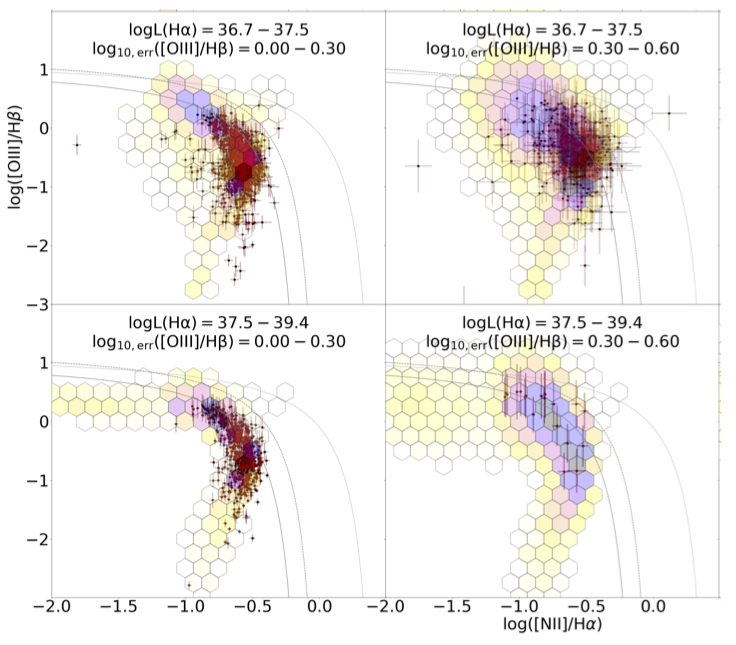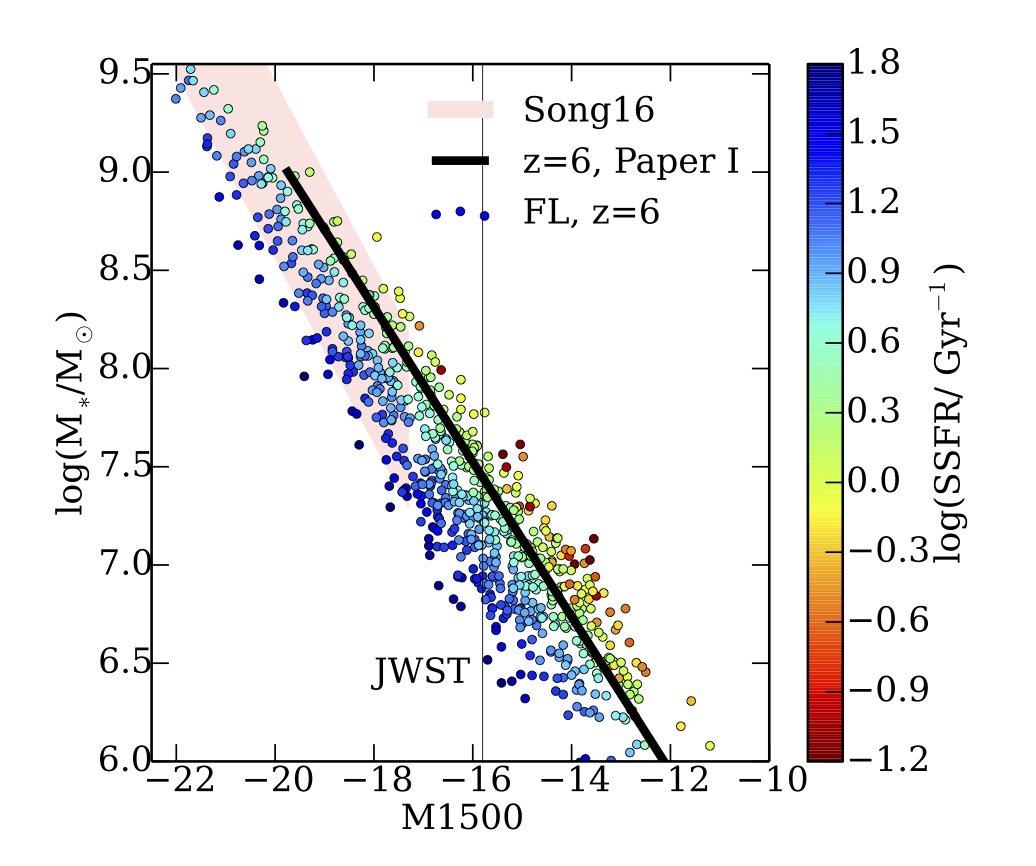Research Highlights
January 2024: The signature of galaxy formation models in the power spectrum of the hydrogen 21cm line during reionization
Lewis, Joseph S. W., Pillepich, Annalisa, Nelson, Dylan, Klessen, Ralf S., Glover, Simon C. O.: Monthly Notices of the Royal Astronomical Society, early access (2024) [ADS link]
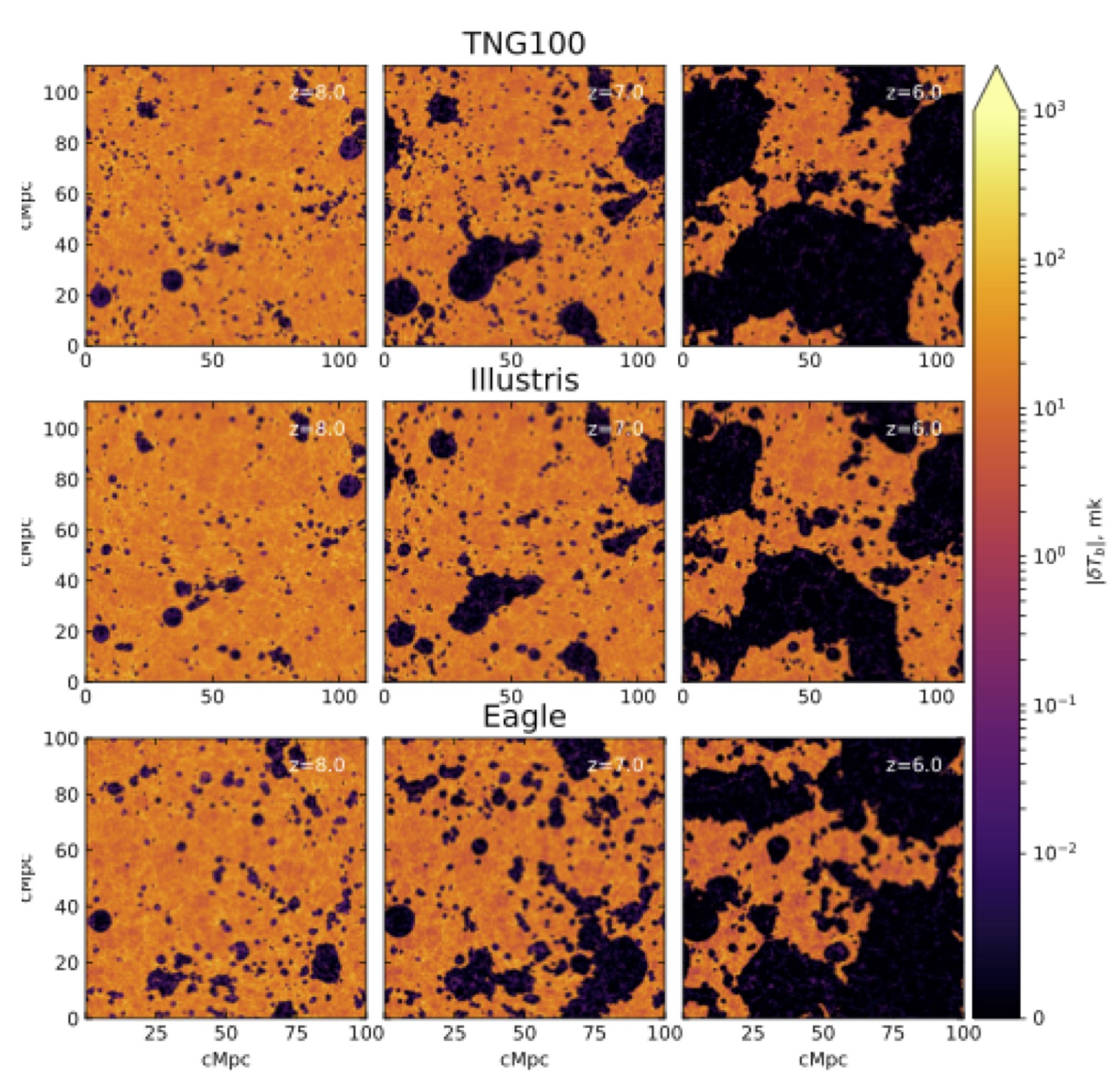
Evolution of the absolute differential brightness temperature of the 21cm line, for the TNG100, Illustris and Eagle simulations (top to bottom), from 𝑧 = 8 (left) to 𝑧 = 6 (right).
Observations of the 21cm line of hydrogen are poised to revolutionize our knowledge of reionization and the first galaxies. However, harnessing such information requires robust and comprehensive theoretical modeling. We study the non-linear effects of hydrodynamics and astrophysical feedback processes, including stellar and AGN feedback, on the 21cm signal by post-processing three existing cosmological hydrodynamical simulations of galaxy formation: Illustris, IllustrisTNG, and Eagle. Despite their different underlying galaxy-formation models, the simulations return similar predictions for the global 21cm brightness temperature and its power spectrum. At fixed redshift, most differences are attributable to alternative reionization histories, in turn driven by differences in the build-up of stellar sources of radiation. However, several astrophysical processes imprint signatures in the 21cm power spectrum at two key scales. First, we find significant small scale (k ≥ 10 Mpc−1) differences between Illustris and IllustrisTNG, where higher velocity winds generated by supernova feedback soften density peaks, leading to lower 21cm power in TNG. Thus, constraints at these scales could rule out extreme feedback models. Second, we find more 21cm power at intermediate scales (k ≈ 0.8 Mpc−1) in Eagle, due to ionization differences driven by highly effective stellar feedback, resulting in lower star formation, older and redder stellar populations, and lower ionizing luminosities for Mh > 109 M⊙. Different source models can manifest similarly in the 21cm power spectrum, leading to often ignored degeneracies. These subtle features could allow future observations of the 21cm signal, in conjunction with other observables, to constrain theoretical models for galactic feedback at high redshift.
December 2023: The First Stars: Formation, Properties, and Impact
Klessen, R.S., Glover, S.C.O.: Annual Reviews of Astronomy & Astrophysics, 61, 65-130 (2023) [ADS link]
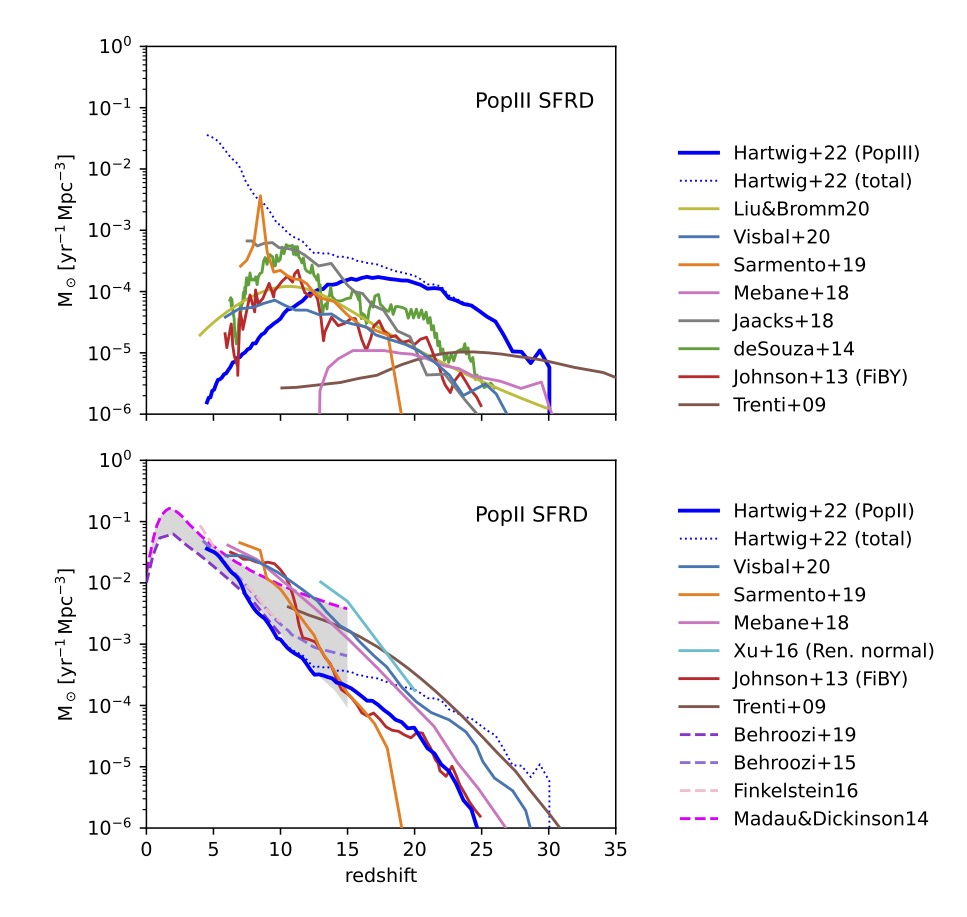
Star formation rate density for Pop III and Pop II stars at z > 5 compiled from different studies.
The first generation of stars, often called Population III (or Pop III), form from metal-free primordial gas at redshifts z ∼ 30 and below. They dominate the cosmic star-formation history until z ∼ 15-20, at which point the formation of metal-enriched Population II stars takes over. We review current theoretical models for the formation, properties, and impact of Pop III stars and discuss existing and future observational constraints. Key takeaways from this review include the following:
■ Primordial gas is highly susceptible to fragmentation and Pop III stars form as members of small clusters with a logarithmically flat mass function.
■ Feedback from massive Pop III stars plays a central role in regulating subsequent star formation, but major uncertainties remain regarding its immediate impact.
■ In extreme conditions, supermassive Pop III stars can form, reaching masses of several 105Mȯ. Their remnants may be the seeds of the supermassive black holes observed in high-redshift quasars.
■ Direct observations of Pop III stars in the early Universe remain extremely challenging. Indirect constraints from the global 21-cm signal or gravitational waves are more promising.
■ Stellar archeological surveys allow us to constrain both the low-mass and the high-mass ends of the Pop III mass distribution. Observations suggest that most massive Pop III stars end their lives as core-collapse supernovae rather than as pair-instability supernovae.
November 2023: Modelling Local Bubble analogs: synthetic dust polarization maps
Maconi, E., Soler, J.D., Reissl, S., Girichidis, P., Klessen, R.S., Hennebelle, P., Molinari, S., Testi, L., Smith, R.J., Sormani, M.C., Teh, J.W., Traficante, A.: MNRAS, 523, 5995 – 6010 (2023) [ADS link]
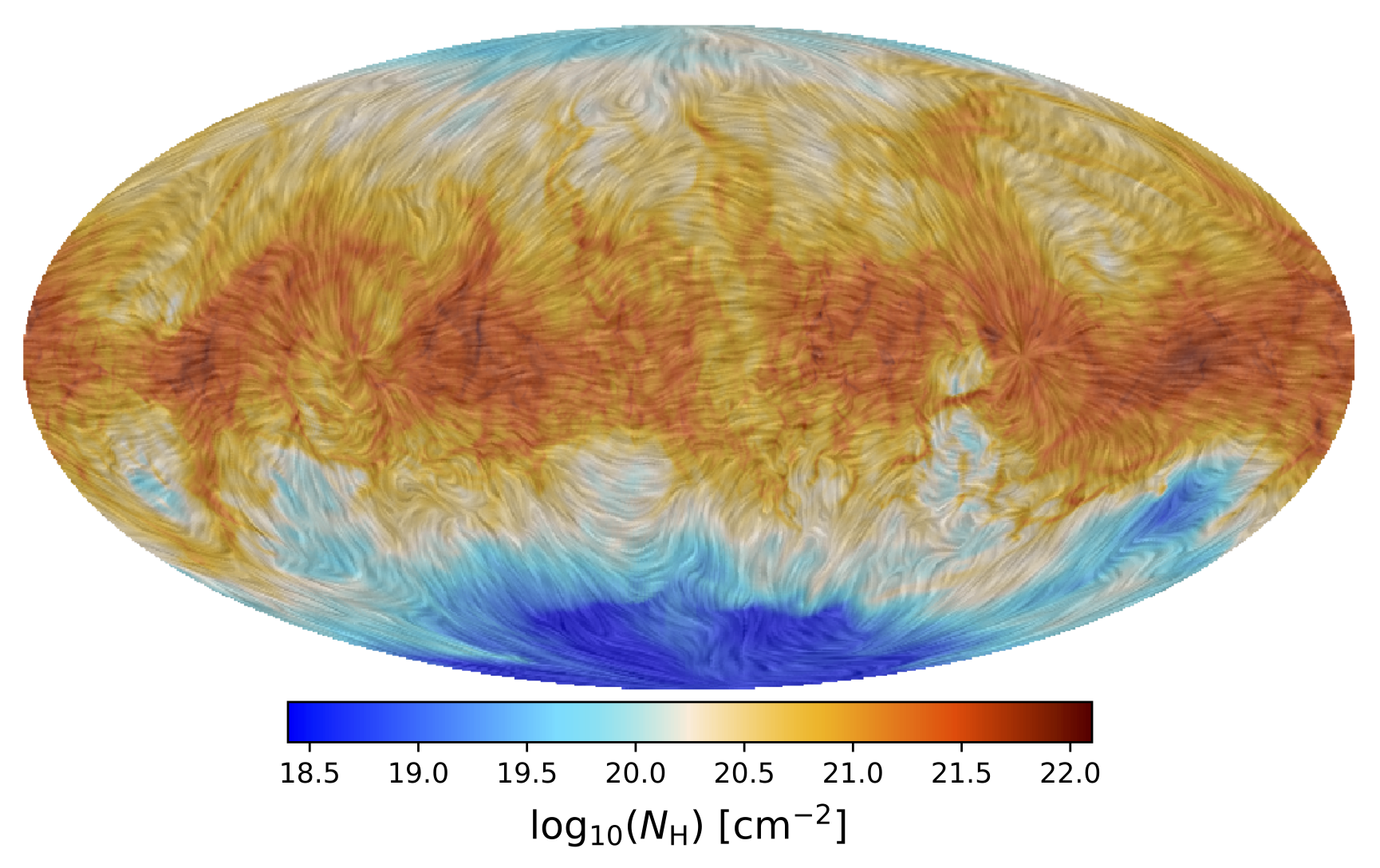
We present a study of synthetic observations of polarized dust emission at 353 GHz as seen by an observer within a cavity in the interstellar medium (ISM). The cavity is selected from a magnetohydrodynamic simulation of the local ISM with time-dependent chemistry, star formation, and stellar feedback in form of supernova explosions with physical properties comparable to the Local Bubble ones. We find that the local density enhancement together with the coherent magnetic field in the cavity walls makes the selected candidate a translucent polarization filter to the emission coming from beyond its domains. This underlines the importance of studying the Local Bubble in further detail. The magnetic field lines inferred from synthetic dust polarization data are qualitatively in agreement with the all-sky maps of polarized emission at 353 GHz from the Planck satellite in the latitudes interval 15° ≲ |b| ≲ 65°. As our numerical simulation allows us to track the galactic mid-plane only out to distances of 250 pc, we exclude the region |b| ≲ 15° from our analysis. At large galactic latitudes, our model exhibits a high degree of small-scale structures. On the contrary, the observed polarization pattern around the Galactic Poles is relatively coherent and regular, and we argue that the global toroidal magnetic field of the Milky Way is important for explaining the data at |b| ≳ 65°. We show that from our synthetic polarization maps, it is difficult to distinguish between an open and a closed galactic cap using the inferred magnetic field morphology alone.
October 2023: A deep learning approach for the 3D reconstruction of dust density and temperature in star-forming regions
Ksoll, Victor F., Reissl, Stefan, Klessen, Ralf S., Stephens, Ian W., Smith, Rowan J., Soler, Juan D., Traficante, Alessio, Testi, Leonardo, Hennebelle, Patrick, Molinari, Sergio: A&A, submitted (2023) [ADS link]
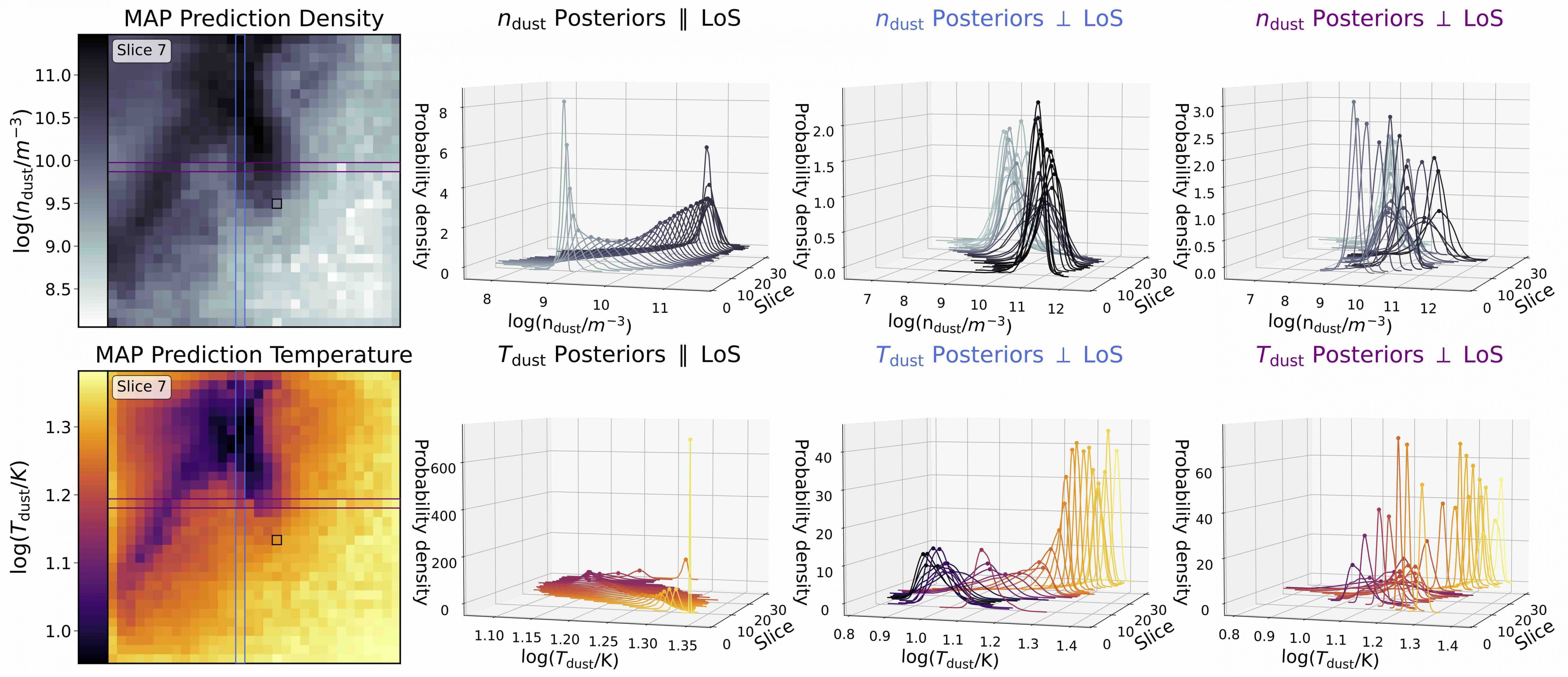
Aims: We introduce a new deep learning approach for the reconstruction of 3D dust density and temperature distributions from multi-wavelength dust emission observations on the scale of individual star-forming cloud cores (<0.2 pc). Methods: We construct a training data set by processing cloud cores from the Cloud Factory simulations with the POLARIS radiative transfer code to produce synthetic dust emission observations at 23 wavelengths between 12 and 1300 μm. We simplify the task by reconstructing the cloud structure along individual lines of sight and train a conditional invertible neural network (cINN) for this purpose. The cINN belongs to the group of normalising flow methods and is able to predict full posterior distributions for the target dust properties. We test different cINN setups, ranging from a scenario that includes all 23 wavelengths down to a more realistically limited case with observations at only seven wavelengths. We evaluate the predictive performance of these models on synthetic test data. Results: We report an excellent reconstruction performance for the 23-wavelengths cINN model, achieving median absolute relative errors of about 1.8% in log(ndust/m−3) and 1% in log(Tdust/K), respectively. We identify trends towards overestimation at the low end of the density range and towards underestimation at the high end of both density and temperature, which may be related to a bias in the training data. Limiting coverage to a combination of only seven wavelengths, we still find a satisfactory performance with average absolute relative errors of about 3.3% and 2.5% in log(ndust/m−3) and log(Tdust/K). Conclusions: This proof of concept study shows that the cINN-based approach for 3D reconstruction of dust density and temperature is very promising and even feasible under realistic observational constraints.
September 2023: Formation of supermassive stars in the first star clusters
Reinoso, Bastián, Klessen, Ralf S., Schleicher, Dominik, Glover, Simon C. O., Solar, P.: MNRAS, 521, 3553 – 3569 (2023), [ADS link]
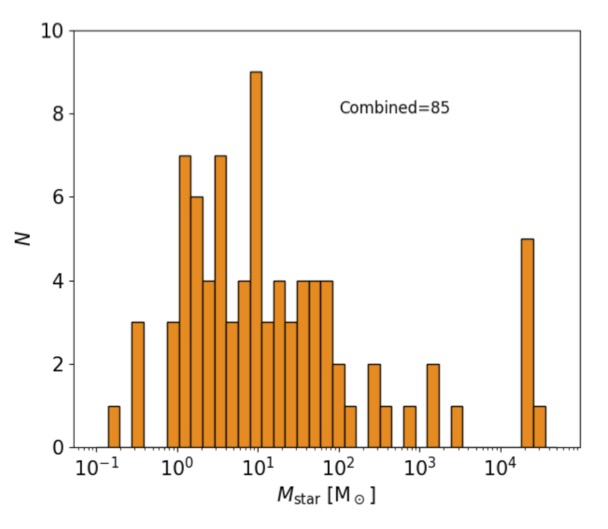
The formation of supermassive stars is believed to be an essential intermediate step for the formation of the massive black hole seeds that become the supermassive black holes powering the quasars observed in the early Universe. Numerical simulations have shown that supermassive stars can form in atomic-cooling haloes when protostars reach accretion rates higher than ~10-2 M⊙ yr-1 and fragmentation is suppressed on pc scales. It is, however, still uncertain if a supermassive star still emerges when fragmentation occurs at smaller scales and a cluster of stars is formed instead. In this work, we explore the problem of massive object formation due to the interplay of collisions and accretion in star clusters at low metallicity. We model a small embedded cluster of accreting protostars following subparsec scale fragmentation during the collapse of a primordial gas cloud, and follow its evolution by performing N-body plus hydrodynamical simulations. Our results show that supermassive stars with 103 and 104 M⊙ are always formed due to the interplay of collisions and accretion, and in some cases these objects are part of a binary system. The resulting supermassive star is surrounded by tens of smaller stars with typical masses in the range 1-100 M⊙.
August 2023: A comparison of the Milky Way’s recent star formation revealed by dust thermal emission and high-mass stars
Soler, J. D., Zari, E., Elia, D., Molinari, S., Mininni, C., Schisano, E., Traficante, A., Klessen, R. S., Glover, S. C. O., Hennebelle, P., Colman, T., Frankel, N., Wenger, T.: A&A, 678, A95, 1 – 8 (2023), [ADS link]
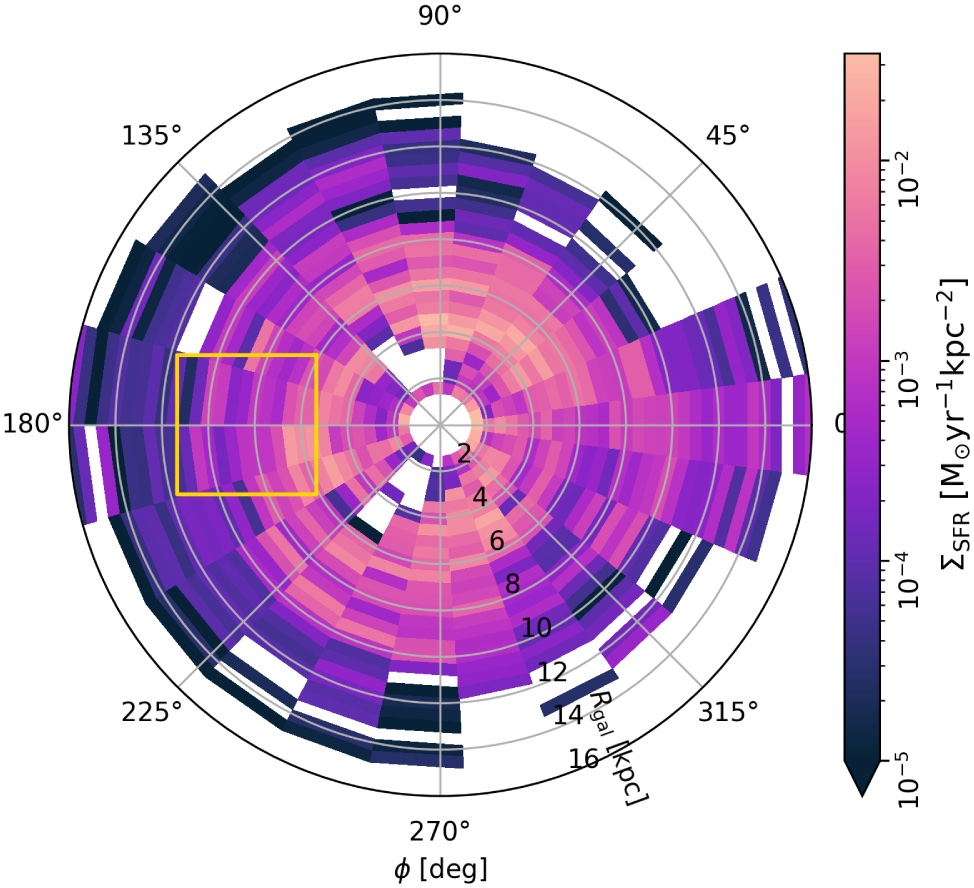
We present a comparison of the Milky Way’s star formation rate (SFR) surface density (∑SFR) obtained with two independent state-of-the-art observational methods. The first method infers ΣSFR from observations of the dust thermal emission from interstellar dust grains in far-infrared wavelengths registered in the Herschel infrared Galactic Plane Survey (Hi-GAL). The second method determines ΣSFR by modeling the current population of O-, B-, and A-type stars in a 6 kpc × 6 kpc area around the Sun. We find an agreement between the two methods within a factor of two for the mean SFRs and the SFR surface density profiles. Given the broad differences between the observational techniques and the independent assumptions in the methods for computing the SFRs, this agreement constitutes a significant advance in our understanding of the star formation of our Galaxy and implies that the local SFR has been roughly constant over the past 10 Myr.
July 2023: A reproduction of the Milky Way’s Faraday rotation measure map in galaxy simulations from global to local scales
Reissl, Stefan, Klessen, Ralf S., Pellegrini, Eric W., Rahner, Daniel, Pakmor, Rüdiger, Grand, Robert, Gómez, Facundo, Marinacci, Federico, Springel, Volker.: Nature Astronomy (2023), https://doi.org/10.1038/s41550-023-02053-2
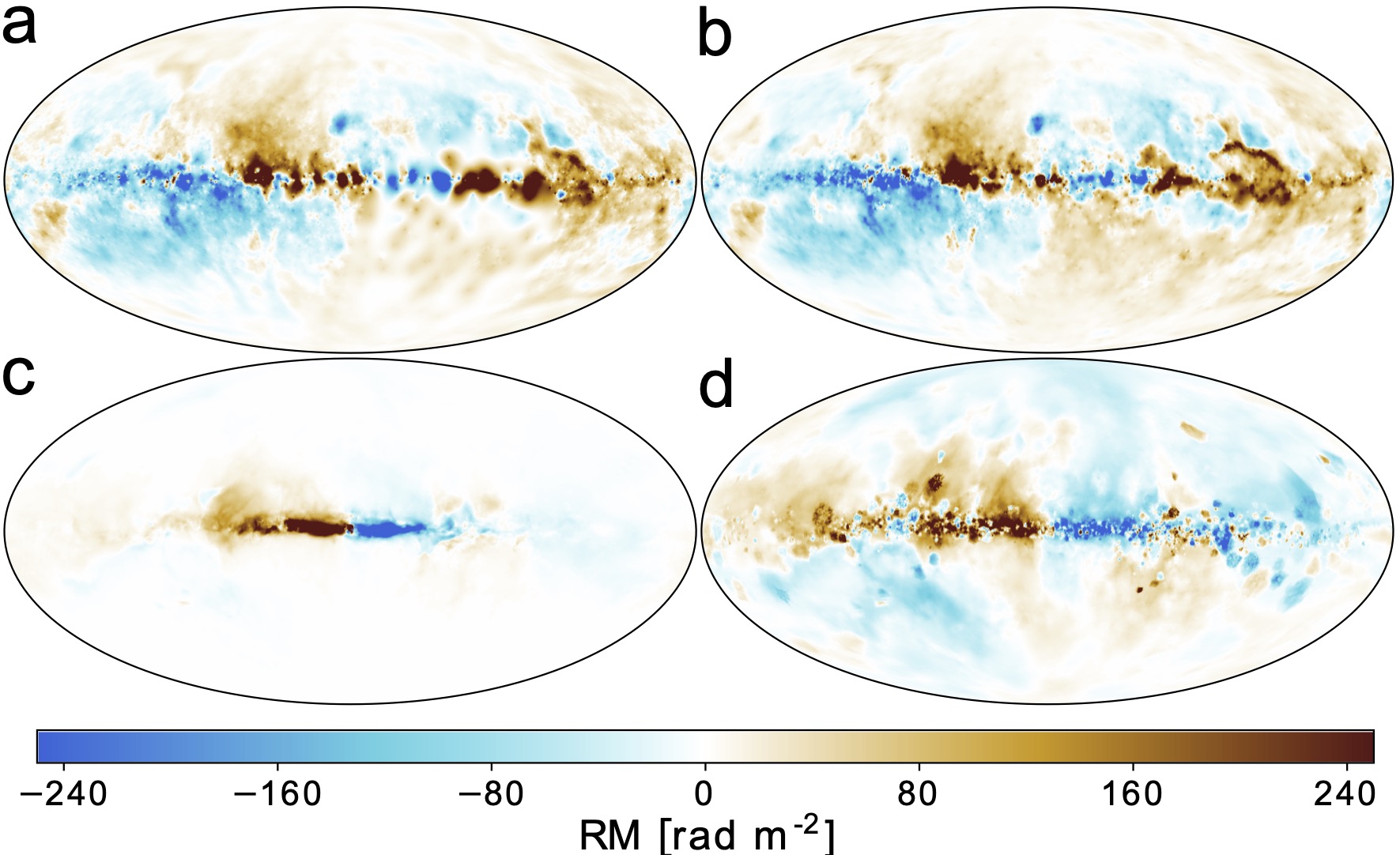
Magnetic fields are of critical importance for our understanding of the origin and long-term evolution of the Milky Way. This is due to their decisive role in the dynamical evolution of the interstellar medium and their influence on the star-formation process. Faraday rotation measures along many different sightlines across the Galaxy are a primary means to infer the magnetic field topology and strength from observations. However, the interpretation of the data has been hampered by the failure of previous attempts to explain the observations in theoretical models and to synthesize a realistic multiscale all-sky rotation measures map. We here utilize a cosmological magnetohydrodynamic simulation of the formation of the Milky Way, augment it with a new star-cluster population-synthesis model for a more realistic structure of the local interstellar medium, and perform detailed polarized radiative transfer calculations on the resulting model. This yields an accurate first-principles prediction of the Faraday sky as observed on Earth. The results reproduce the observations of the Galaxy not only on global scales but also on local scales of individual star-forming clouds. They also indicate that the Local Bubble containing our Sun dominates the rotation measures signal over large regions of the sky. Modern cosmological magnetohydrodynamic simulations of the Milky Way’s formation, combined with a plausible model for star formation, stellar feedback and the distribution of free electrons in the interstellar medium, explain the rotation measures observations remarkably well, and thus contribute to a better understanding of the origin of magnetic fields in our Galaxy.
June 2023: Fuelling the nuclear ring of NGC 1097
Sormani, Mattia, et al.: MNRAS, 523, 2918 – 2927 (2023) [ADS link]

NGC 1097. Gas flows along these lanes to the nuclear region, where it is available for star formation.
Galactic bars can drive cold gas inflows towards the centres of galaxies. The gas transport happens primarily through the so-called bar dust lanes, which connect the galactic disc at kpc scales to the nuclear rings at hundreds of pc scales much like two gigantic galactic rivers. Once in the ring, the gas can fuel star formation activity, galactic outflows, and central supermassive black holes. Measuring the mass inflow rates is therefore important to understanding the mass/energy budget and evolution of galactic nuclei. In this work, we use CO datacubes from the PHANGS-ALMA survey and a simple geometrical method to measure the bar-driven mass inflow rate on to the nuclear ring of the barred galaxy NGC 1097. The method assumes that the gas velocity in the bar lanes is parallel to the lanes in the frame co-rotating with the bar, and allows one to derive the inflow rates from sufficiently sensitive and resolved position-position-velocity diagrams if the bar pattern speed and galaxy orientations are known. We find an inflow rate of (3.0 +/-2.1) Msun/yr averaged over a time span of 40 Myr, which varies by a factor of a few over time-scales of ~10 Myr. Most of the inflow appears to be consumed by star formation in the ring, which is currently occurring at a star formation rate of about 0.02 Msun/yr, suggesting that the inflow is causally controlling the SFR in the ring as a function of time.
May 2023: Spectral classification of young stars using conditional invertible neural networks. I. Introducing and validating the method
Kang, Da Eun; Ksoll, Victor F., Itrich, Dominika, Testi, Leonardo, Klessen, Ralf S., Hennebelle, Patrick, Molinari, Sergio: A&A, 674, A175, 1 – 23 (2023) [ADS link]
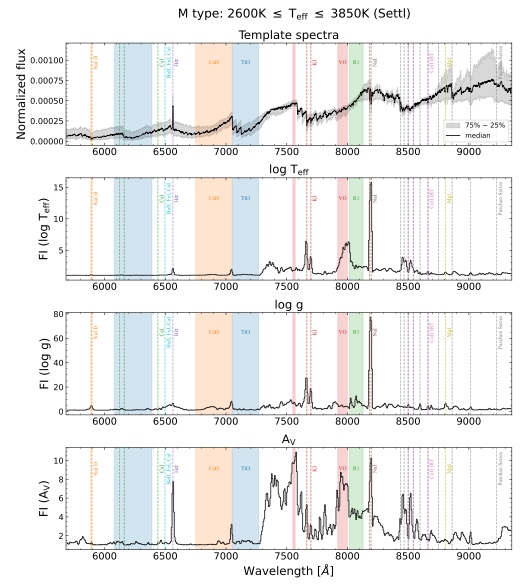
Aims: We introduce a new deep-learning tool that estimates stellar parameters (e.g. effective temperature, surface gravity, and extinction) of young low-mass stars by coupling the Phoenix stellar atmosphere model with a conditional invertible neural network (cINN). Our networks allow us to infer the posterior distribution of each stellar parameter from the optical spectrum.
Methods: We discuss cINNs trained on three different Phoenix grids: Settl, NextGen, and Dusty. We evaluate the performance of these cINNs on unlearned Phoenix synthetic spectra and on the spectra of 36 class III template stars with well-characterised stellar parameters.
Results: We confirm that the cINNs estimate the considered stellar parameters almost perfectly when tested on unlearned Phoenix synthetic spectra. Applying our networks to class III stars, we find good agreement with deviations of 5-10% at most. The cINNs perform slightly better for earlier-type stars than for later-type stars such as late M-type stars, but we conclude that estimates of effective temperature and surface gravity are reliable for all spectral types within the training range of the network.
Conclusions: Our networks are time-efficient tools that are applicable to large numbers of observations. Among the three networks, we recommend using the cINN trained on the Settl library (Settl-Net) because it provides the best performance across the widest range of temperature and gravity.
April 2023: The mechanical alignment of dust (MAD). I. The spin-up process of fractal grains by a gas-dust drift rate
Reissl, Stefan, Meehan, Paul, Klessen, Ralf S.: A&A, 674, A47, 1 – 27 (2023) [ADS link]

Context. Observations of polarized light emerging from aligned dust grains are commonly exploited to probe the magnetic field orientation in astrophysical environments. However, the exact physical processes that result in a coherent large-scale grain alignment are still far from being fully constrained.
Aims: In this work, we aim to investigate the impact of a gas-dust drift on a microscopic level, potentially leading to a mechanical alignment of fractal dust grains and subsequently to dust polarization.
Methods: We scanned a wide range of parameters of fractal dust aggregates in order to statistically analyze the average grain alignment behavior of distinct grain ensembles. In detail, the spin-up efficiencies for individual aggregates were determined utilizing a Monte Carlo approach to simulate the collision, scattering, sticking, and evaporation processes of gas on the grain surface. Furthermore, the rotational disruption of dust grains was taken into account to estimate the upper limit of possible grain rotation. The spin-up efficiencies were analyzed within a mathematical framework of grain alignment dynamics in order to identify long-term stable grain alignment points in the parameter space. Here, we distinguish between the cases of grain alignment in the direction of the gas-dust drift and the alignment along the magnetic field lines. Finally, the net dust polarization was calculated for each collection of stable alignment points per grain ensemble.
Results: We find the purely mechanical spin-up processes within the cold neutral medium to be sufficient enough to drive elongated grains to a stable alignment. The most likely mechanical grain alignment configuration is with a rotation axis parallel to the drift direction. Here, roundish grains require a supersonic drift velocity, while rod-like elongated grains can already align for subsonic conditions. We predict a possible dust polarization efficiency in the order of unity resulting from mechanical alignment. Furthermore, a supersonic drift may result in a rapid grain rotation where dust grains may become rotationally disrupted by centrifugal forces. Hence, the net contribution of such a grain ensemble to polarization drastically reduces. In the presence of a magnetic field, the drift velocity required for the most elongated grains to reach a stable alignment is roughly one order of magnitude higher compared to the purely mechanical case. We demonstrate that a considerable fraction of a grain ensemble can stably align with the magnetic field lines and report a possible dust polarization efficiency of 0.6-0.9, indicating that a gas-dust drift alone can provide the conditions required to observationally probe the magnetic field structure. We predict that magnetic field alignment is highly inefficient when the direction of the gas-dust drift and magnetic field lines are perpendicular.
Conclusions: Our results strongly suggest that mechanical alignment has to be taken into consideration as an alternative driving mechanism where the canonical radiative torque alignment theory fails to account for the full spectrum of available dust polarization observations.
March 2023: Magnetic fields do not suppress global star formation in low metallicity dwarf galaxies
Whitworth, David J.; Smith, Rowan J.; Klessen, Ralf S.; Mac Low, Mordecai-Mark; Glover, Simon C. O.; Tress, Robin, Pakmor; Rüdiger; Soler, Juan D.: MNRAS, 520, 89 – 106 (2023) [ADS link]
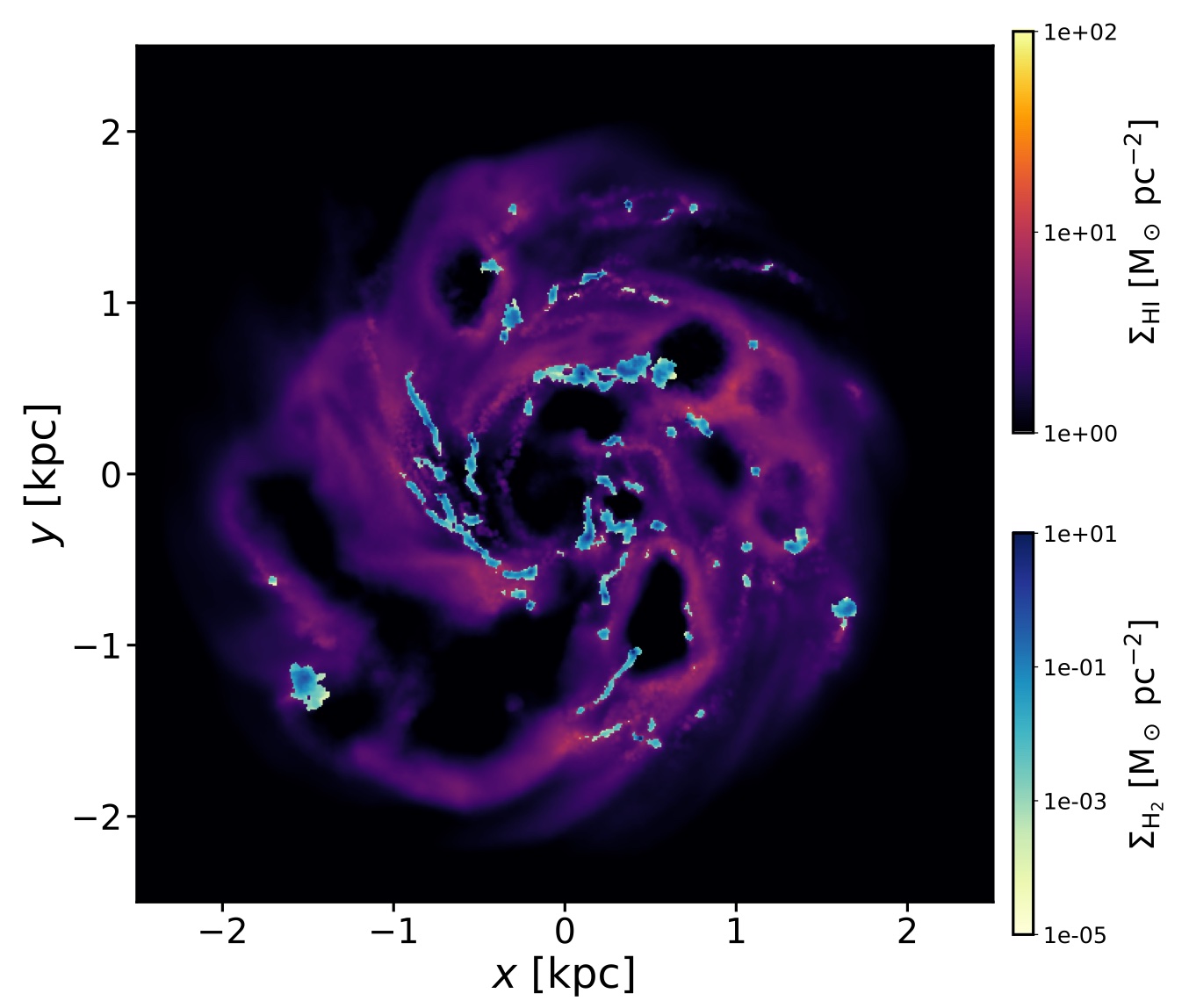
Many studies concluded that magnetic fields suppress star formation in molecular clouds and Milky Way like galaxies. However, most of these studies are based on fully developed fields that have reached the saturation level, with little work on investigating how an initial weak primordial field affects star formation in low metallicity environments. In this paper, we investigate the impact of a weak initial field on low metallicity dwarf galaxies. We perform high-resolution AREPO simulations of five isolated dwarf galaxies. Two models are hydrodynamical, two start with a primordial magnetic field of 10−6 μG and different sub-solar metallicities, and one starts with a saturated field of 10−2 μG. All models include a non-equilibrium, time-dependent chemical network that includes the effects of gas shielding from the ambient ultraviolet field. Sink particles form directly from the gravitational collapse of gas and are treated as star-forming clumps that can accrete gas. We vary the ambient uniform far ultraviolet field, and cosmic ray ionization rate between 1 per cent and 10 per cent of solar values. We find that the magnetic field has little impact on the global star formation rate (SFR), which is in tension with some previously published results. We further find that the initial field strength has little impact on the global SFR. We show that an increase in the mass fractions of both molecular hydrogen and cold gas, along with changes in the perpendicular gas velocity dispersion and the magnetic field acting in the weak-field model, overcome the expected suppression in star formation.
February 2023: Towards the impact of GMC collisions on the star formation rate
Hunter, Glen H.; Clark, Paul C.; Glover, Simon C. O.; Klessen, Ralf S.: MNRAS, 519, 4152 – 4170 (2023) [ADS link]

Collisions between giant molecular clouds (GMCs) are one of the pathways for massive star formation due to the high densities created. However, the enhancement of the star formation rate (SFR) is not well constrained. In this study, we perform a parameter study of cloud-cloud collisions and investigate how the resulting SFR depends on the details of set-up. Our parameter study explores variations in collision speed, magnetic field inclination (with respect to the collisional axis), and resolution, as defined by the number of cells per Jeans length. In all our collision simulations, we find a factor of 2-3 increase in the SFR compared to our no collision simulation, with star formation beginning sooner with (a) high collisional velocities, (b) parallel orientation between the magnetic field and collision axis, (c) and lower resolution. The mean virial parameter of high density (and thus possible star-forming) gas increases with collisional velocity, but has little variation with magnetic field inclination. The alignment of the velocity and magnetic field remains uniform in low-density environments but becomes more perpendicular with increasing density, indicating the compression of the magnetic field by collapsing gas. Comparing the trends in the SFR with other GMC collision studies, we find good agreement with studies that account for the gravitational boundedness of the gas in their star formation algorithm, but not with those that simply form stars above a prescribed density threshold. This suggests that the latter approach should be used with caution when modelling star formation on resolved cloud scales..
January 2023: Public Release of A-SLOTH: Ancient Stars and Local Observables by Tracing Halos
Hartwig, Tilman; Magg, Mattis; Chen, Li-Hsin; Tarumi, Yuta; Bromm, Volker; Glover, Simon C. O.; Ji, Alexander P.; Klessen, Ralf S.; Latif, Muhammad A.; Volonteri, Marta; Yoshida, Naoki: ApJ, 936, A45, 1 – 25 (2023) [ADS link]

The semianalytical model A-SLOTH (Ancient Stars and Local Observables by Tracing Halos) is the first public code that connects the formation of the first stars and galaxies to observables. After several successful projects with this model, we publish the source code (https://gitlab.com/thartwig/asloth) and describe the public version in this paper. The model is based on dark matter merger trees that can either be generated based on Extended Press-Schechter theory or be imported from dark matter simulations. On top of these merger trees, A-SLOTH applies analytical recipes for baryonic physics to model the formation of both metal-free and metal-poor stars and the transition between them with unprecedented precision and fidelity. A-SLOTH samples individual stars and includes radiative, chemical, and mechanical feedback. It is calibrated based on six observables, such as the optical depth to Thomson scattering, the stellar mass of the Milky Way and its satellite galaxies, the number of extremely metal-poor stars, and the cosmic star formation rate density at high redshift. A-SLOTH has versatile applications with moderate computational requirements. It can be used to constrain the properties of the first stars and high-z galaxies based on local observables, predicts properties of the oldest and most metal-poor stars in the Milky Way, can serve as a subgrid model for larger cosmological simulations, and predicts next-generation observables of the early universe, such as supernova rates or gravitational wave events.
December 2022: Public Release of A-SLOTH: Ancient Stars and Local Observables by Tracing Halos
Magg, Mattis; Reis, Itamar; Fialkov, Anastasia; Barkana, Rennan; Klessen, Ralf S.; Glover, Simon C. O.; Chen, Li-Hsin; Hartwig, Tilman; Schauer, Anna T. P.: MNRAS, 514, 4433 – 4449 (2022) [ADS link]

Mapping cosmic dawn with 21-cm tomography offers an exciting new window into the era of primordial star formation. However, self-consistent implementation of both the process of star formation and the related 21-cm signal is challenging, due to the multiscale nature of the problem. In this study, we develop a flexible semi-analytical model to follow the formation of the first stars and the process of gradual transition from primordial to metal-enriched star formation. For this transition, we use different scenarios with varying time-delays (or recovery times) between the first supernovae and the formation of the second generation of stars. We use recovery times between 10 and 100 Myr and find that these delays have a strong impact on the redshift at which the transition to metal-enriched star formation occurs. We then explore the effect of this transition on the 21-cm signal and find that the recovery time has a distinctive imprint in the signal. Together with an improved understanding of how this time-delay relates to the properties of Population III stars, future 21-cm observations can give independent constraints on the earliest epoch of star formation. As the transition away from the primordial star formation is expected to occur at high redshifts, here we ignore the impact of X-ray and ionizing radiation, focusing on the effect of Ly α photons on the 21-cm signal.
November 2022: The physical origin and the properties of arm spurs/feathers in local simulations of the wiggle instability
Mandowara, Yash; Sormani, Mattia C.; Sobacchi, Emanuele; Klessen, Ralf S.: MNRAS, 513, 5052 – 5075 (2022) [ADS link]

Gaseous substructures such as feathers and spurs dot the landscape of spiral arms in disc galaxies. One of the candidates to explain their formation is the wiggle instability of galactic spiral shocks. We study the wiggle instability using local 2D hydrodynamical isothermal non-self-gravitating simulations. We find that: (1) simulations agree with analytic linear stability analysis only under stringent conditions. They display surprisingly strong non-linear coupling between the different modes, even for small mode amplitudes (∼1 per cent). (2) We demonstrate that the wiggle instability originates from a combination of two physically distinct mechanisms: the first is the Kelvin-Helmholtz instability, and the second is the amplification of infinitesimal perturbations from repeated shock passages. These two mechanisms can operate simultaneously, and which mechanism dominates depends on the underlying parameters. (3) We explore the parameter space and study the properties of spurs/feathers generated by the wiggle instability. The wiggle instability is highly sensitive to the underlying parameters. The feather separation decreases, and the growth rate increases, with decreasing sound speed, increasing potential strength and decreasing interarm distance. (4) We compare our simulations with a sample of 20 galaxies in the HST Archival Survey of Spiral Arm Substructure of La Vigne et al. and find that the wiggle instability is able to reproduce the typical range of feather separations seen in observations. It remains unclear how the wiggle instability relates to competing mechanisms for spur/feather formation such as the magneto-jeans instability and the stochastic accumulation of gas due to correlated supernova feedback.
October 2022: The Sweep Method for Radiative Transfer in Arepo
Peter, Toni; Klessen, Ralf S.; Kanschat, Guido; Glover, Simon C. O.; Bastian, Peter: MNRAS, 519, 4263 – 4278 (2023) [ADS link]

We introduce the radiative transfer code Sweep for the cosmological simulation suite Arepo. Sweep is a discrete ordinates method in which the radiative transfer equation is solved under the infinite speed of light, steady state assumption by a transport sweep across the entire computational grid. Since Arepo is based on an adaptive, unstructured grid, the dependency graph induced by the sweep dependencies of the grid cells is non-trivial. In order to solve the topological sorting problem in a distributed manner, we employ a task-based-parallelism approach. The main advantage of the sweep method is that the computational cost scales only with the size of the grid, and is independent of the number of sources or the distribution of sources in the computational domain, which is an advantage for radiative transfer in cosmological simulations, where there are large numbers of sparsely distributed sources. We successfully apply the code to a number of physical tests such as the expansion of HII regions, the formation of shadows behind dense objects, the scattering of light, as well as its behavior in the presence of periodic boundary conditions. In addition, we measure its computational performance with a focus on highly parallel, large-scale simulations.
September 2022: Self-consistent modelling of the Milky Way’s nuclear stellar discbility
Sormani, Mattia C.; Sanders, Jason L.; Fritz, Tobias K.; Smith, Leigh C.; Gerhard, Ortwin; Schödel, Rainer; Magorrian, John; Neumayer, Nadine; Nogueras-Lara, Francisco; Feldmeier-Krause, Anja; Mastrobuono-Battisti, Alessandra; Schultheis, Mathias; Shahzamanian, Banafsheh; Vasiliev, Eugene; Klessen, Ralf S.; Lucas, Philip; Minniti, Dante: MNRAS, 512, 1857 – 1884 (2022) [ADS link]
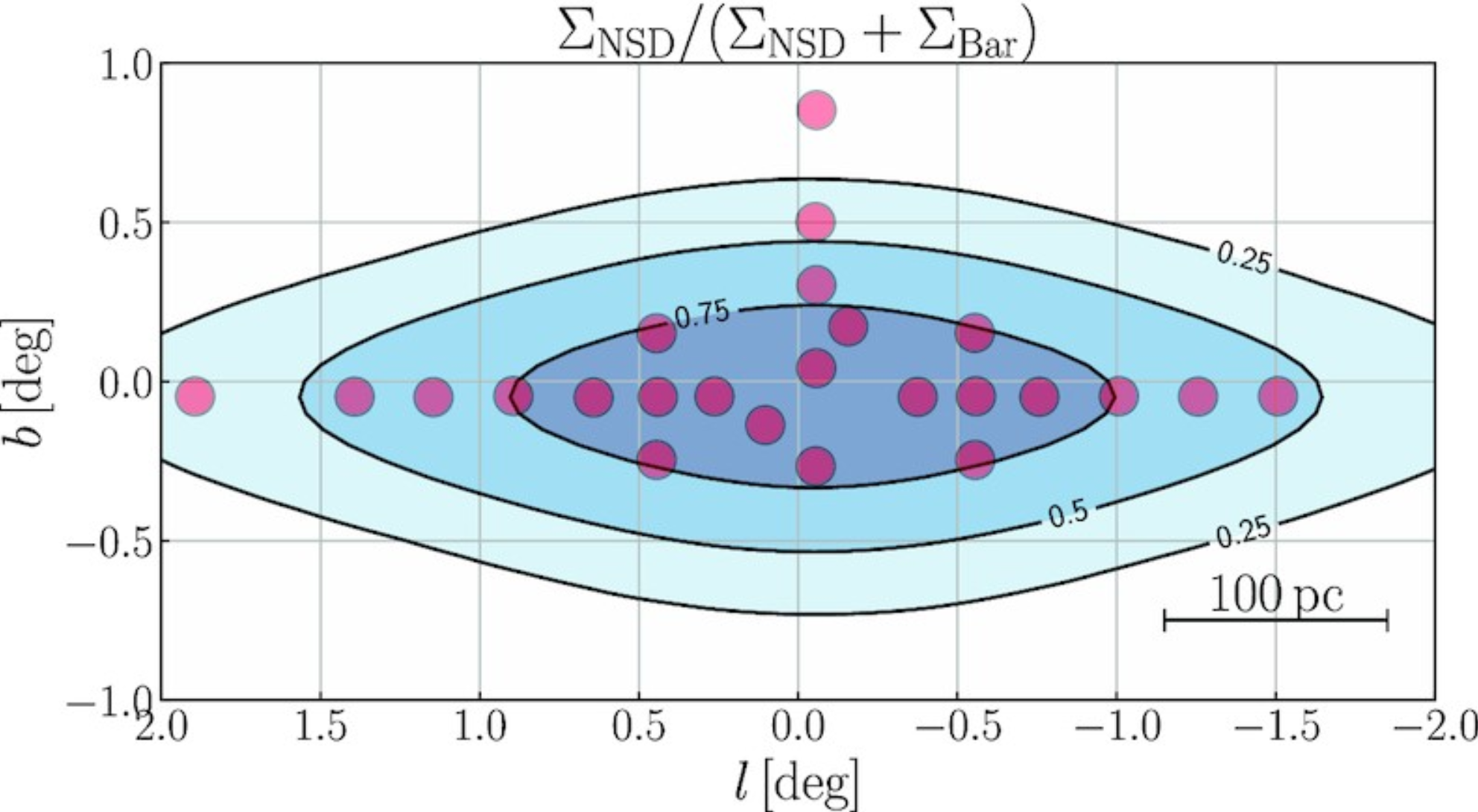
The nuclear stellar disc (NSD) is a flattened high-density stellar structure that dominates the gravitational field of the Milky Way at Galactocentric radius 30pc≲R≲300pc. We construct axisymmetric self-consistent equilibrium dynamical models of the NSD in which the distribution function is an analytic function of the action variables. We fit the models to the normalized kinematic distributions (line-of-sight velocities + VIRAC2 proper motions) of stars in the NSD survey of Fritz et al., taking the foreground contamination due to the Galactic Bar explicitly into account using an N-body model. The posterior marginalized probability distributions give a total mass of MNSD=10.5+1.1−1.0×108M⊙, roughly exponential radial and vertical scale lengths of Rdisc=88.6+9.2−6.9pc and Hdisc=28.4+5.5−5.5pc, respectively, and a velocity dispersion σ≃70kms−1 that decreases with radius. We find that the assumption that the NSD is axisymmetric provides a good representation of the data. We quantify contamination from the Galactic Bar in the sample, which is substantial in most observed fields. Our models provide the full 6D (position + velocity) distribution function of the NSD, which can be used to generate predictions for future surveys. We make the models publicly available as part of the software package AGAMA.
August 2022: The Galactic dynamics revealed by the filamentary structure in atomic hydrogen emission
Soler, J. D.; Miville-Deschênes, M. -A.; Molinari, S.; Klessen, R. S.; Hennebelle, P.; Testi, L.; McClure-Griffiths, N. M.; Beuther, H.; Elia, D.; Schisano, E.; Traficante, A.; Girichidis, P.; Glover, S. C. O.; Smith, R. J.; Sormani, M.; Tress, R.: A&A, 662, A96, 1 – 31 (2022) [ADS link]
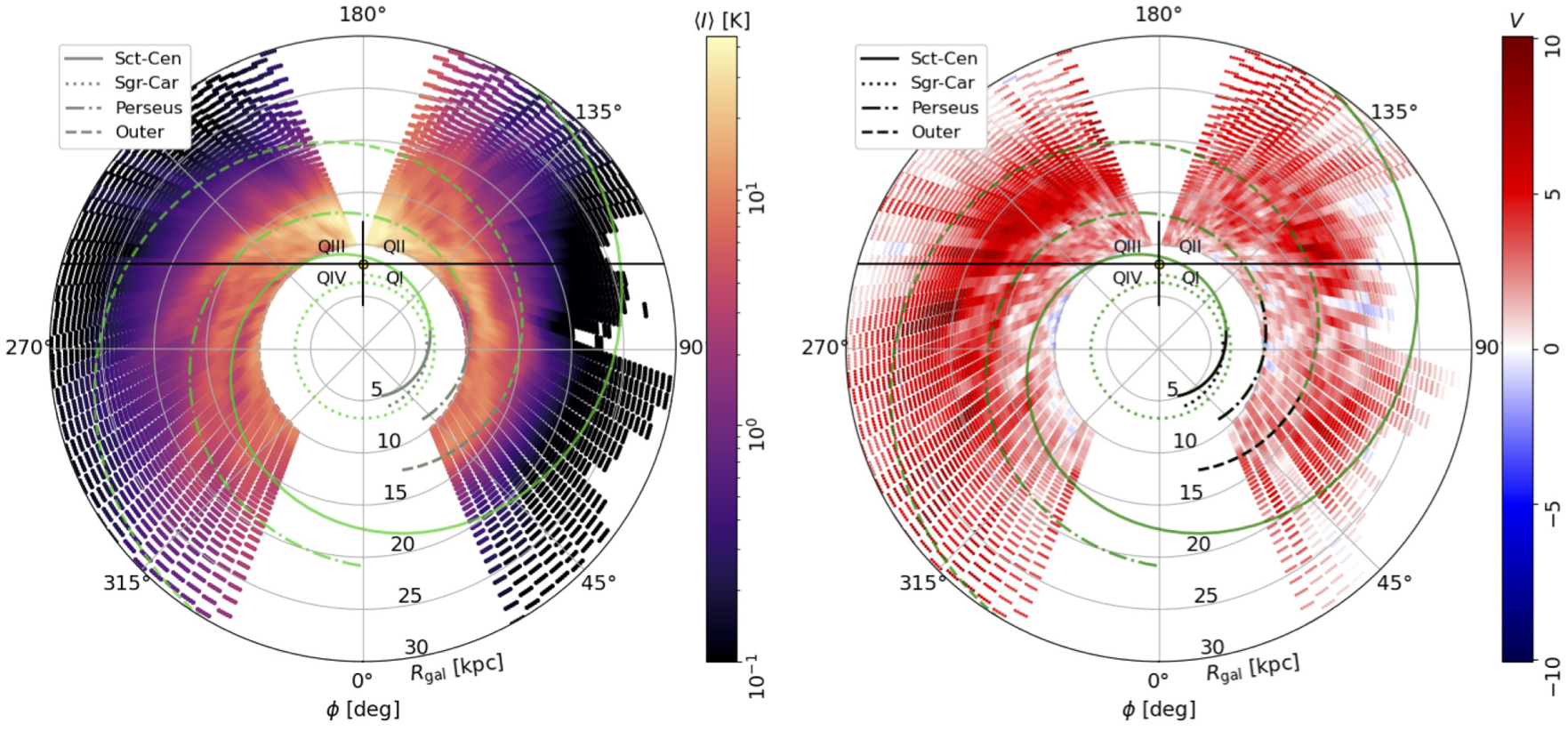
We present a study of the filamentary structure in the neutral atomic hydrogen (H I) emission at the 21 cm wavelength toward the Galactic plane using the 16′.2-resolution observations in the H I 4π (HI4PI) survey. Using the Hessian matrix method across radial velocity channels, we identified the filamentary structures and quantified their orientations using circular statistics. We found that the regions of the Milky Way’s disk beyond 10 kpc and up to roughly 18 kpc from the Galactic center display H I filamentary structures predominantly parallel to the Galactic plane. For regions at lower Galactocentric radii, we found that the H I filaments are mostly perpendicular or do not have a preferred orientation with respect to the Galactic plane. We interpret these results as the imprint of supernova feedback in the inner Galaxy and Galactic rotation and shear in the outer Milky Way. We found that the H I filamentary structures follow the Galactic warp and flaring and that they highlight some of the variations interpreted as the effect of the gravitational interaction with satellite galaxies. In addition, the mean scale height of the filamentary structures is lower than that sampled by the bulk of the H I emission, thus indicating that the cold and warm atomic hydrogen phases have different scale heights in the outer galaxy. Finally, we found that the fraction of the column density in H I filaments is almost constant up to approximately 18 kpc from the Galactic center. This is possibly a result of the roughly constant ratio between the cold and warm atomic hydrogen phases inferred from the H I absorption studies. Our results indicate that the H I filamentary structures provide insight into the dynamical processes shaping the Galactic disk. Their orientations record how and where the stellar energy input, the Galactic fountain process, the cosmic ray diffusion, and the gas accretion have molded the diffuse interstellar medium in the Galactic plane.
June 2022: Gravity versus Magnetic Fields in Forming Molecular Clouds
Ibáñez-Mejía, Juan C.; Mac Low, Mordecai-Mark; Klessen, Ralf S.: ApJ, 925, A196, 1 – 14 (2022) [ADS link]

molecular cloud in numerical simulation of star-formation and ISM dynamics in part of the Galactic disk (Ibáñez-Mejía et al. 2022).
Magnetic fields are dynamically important in the diffuse interstellar medium. Understanding how gravitationally bound, star-forming clouds form requires modeling of the fields in a self-consistent, supernova-driven, turbulent, magnetized, stratified disk. We employ the FLASH magnetohydrodynamics code to follow the formation and early evolution of clouds with final masses of 3-8 × 103 M ⊙ within such a simulation. We use the code’s adaptive mesh refinement capabilities to concentrate numerical resolution in zoom-in regions covering single clouds, allowing us to investigate the detailed dynamics and field structure of individual self-gravitating clouds in a consistent background medium. Our goal is to test the hypothesis that dense clouds are dynamically evolving objects far from magnetohydrostatic equilibrium. We find that the cloud envelopes are magnetically supported with field lines parallel to density gradients and flow velocity, as indicated by the histogram of relative orientations and other statistical measures. In contrast, the dense cores of the clouds are gravitationally dominated, with gravitational energy exceeding internal, kinetic, or magnetic energy and accelerations due to gravity exceeding those due to magnetic or thermal pressure gradients. In these regions, field directions vary strongly, with a slight preference toward being perpendicular to density gradients, as shown by three-dimensional histograms of relative orientation.
May 2022: Metal Mixing in Minihalos: The Descendants of Pair-instability Supernovae
Magg, Mattis, Schauer, Anna T. P., Klessen, Ralf S., Glover, Simon C. O., Tress, Robin G., Jaura, Ondrej: ApJ, 929, A119, 1 – 17 (2022) [ADS link]
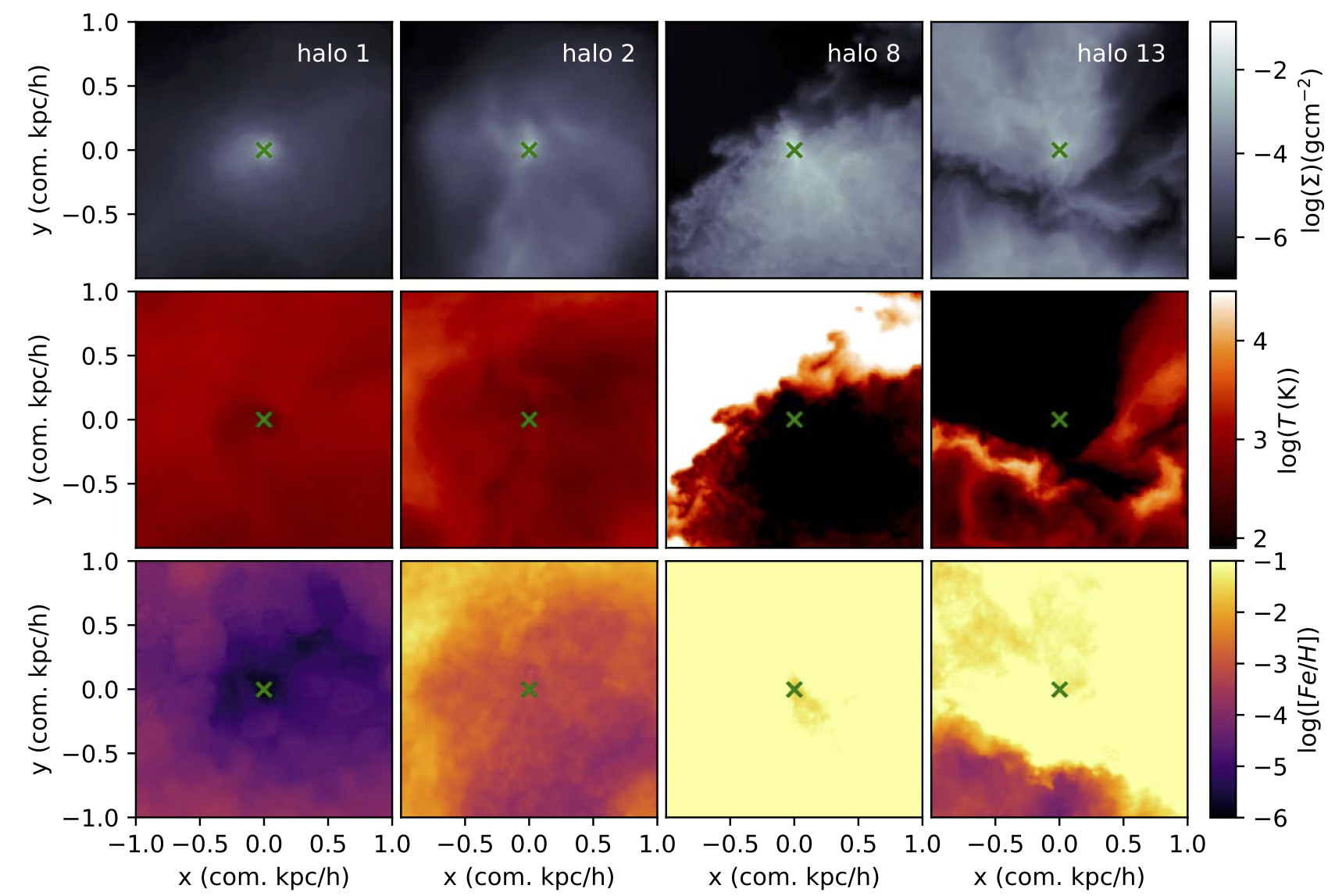
The lack of observations of abundance patterns originating in pair-instability supernovae has been a long-standing problem in relation to the first stars. This class of supernovae is expected to have an abundance pattern with a strong odd-even effect, making it substantially different from present-day supernovae. In this study, we use a cosmological radiation hydrodynamics simulation to model such supernovae and the subsequent formation of the second generation of stars. We incorporate streaming velocities for the first time. There are 14 star-forming minihalos in our 1 cMpc h -1 box, leading to 14 supernovae occurring before redshift z = 19.5, where we start reducing the complexity of the simulation. Following the explosions, extremely metal-poor stars form in 10 halos via internal and external enrichment, which makes it the most common outcome. Only one halo does not recollapse during the simulations. This result is at variance with the current (lack of) observations of metal-poor stars with pair-instability supernova abundance patterns, suggesting that these very massive stars might be rare even in the early universe. The results from this simulation also give us insights into what drives different modes of recollapse and what determines the mixing behavior of metals after very energetic supernovae.
April 2022: Emission-line diagnostics of H II regions using conditional invertible neural networks
Kang, Da Eun, Pellegrini, Eric W., Ardizzone, Lynton, Klessen, Ralf S., Koethe, Ullrich, Glover, Simon C. O., Ksoll, Victor F.: MNRAS, 512, 617 – 647 (2022) [ADS link]
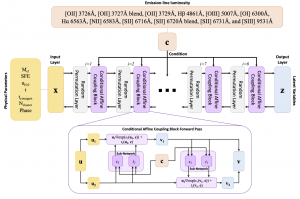
Young massive stars play an important role in the evolution of the interstellar medium (ISM) and the self-regulation of star formation in giant molecular clouds (GMCs) by injecting energy, momentum, and radiation (stellar feedback) into surrounding environments, disrupting the parental clouds, and regulating further star formation. Information of the stellar feedback inheres in the emission we observe, however inferring the physical properties from photometric and spectroscopic measurements is difficult, because stellar feedback is a highly complex and non-linear process, so that the observational data are highly degenerate. On this account, we introduce a novel method that couples a conditional invertible neural network (cINN) with the WARPFIELD-emission predictor (WARPFIELD-EMP) to estimate the physical properties of star-forming regions from spectral observations. We present a cINN that predicts the posterior distribution of seven physical parameters (cloud mass, star formation efficiency, cloud density, cloud age which means age of the first generation stars, age of the youngest cluster, the number of clusters, and the evolutionary phase of the cloud) from the luminosity of 12 optical emission lines, and test our network with synthetic models that are not used during training. Our network is a powerful and time-efficient tool that can accurately predict each parameter, although degeneracy sometimes remains in the posterior estimates of the number of clusters. We validate the posteriors estimated by the network and confirm that they are consistent with the input observations. We also evaluate the influence of observational uncertainties on the network performance.
March 2022: Trapping of H II regions in Population III star formation
Jaura, Ondrej, Glover, Simon C. O., Wollenberg, Katharina M. J., Klessen, Ralf S., Geen, Sam, Haemmerlé, Lionel: MNRAS, 512, 116 – 136 (2022) [ADS link]
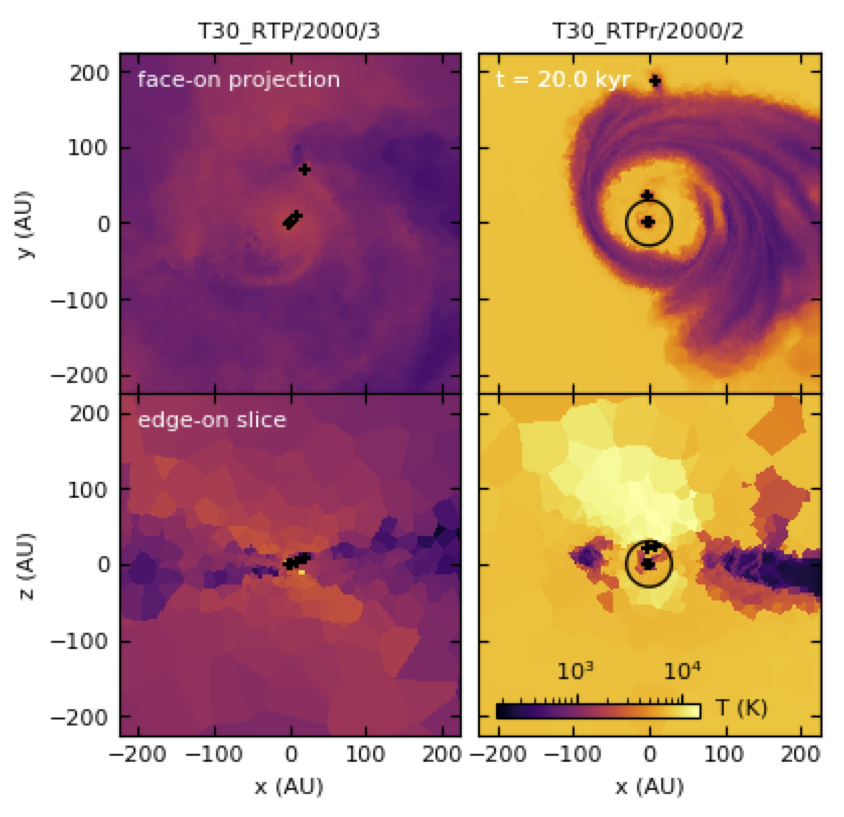
Radiative feedback from massive Population III (Pop III) stars in the form of ionizing and photodissociating photons is widely believed to play a central role in shutting off accretion on to these stars. Understanding whether and how this occurs is vital for predicting the final masses reached by these stars and the form of the Pop III stellar initial mass function. To help us better understand the impact of UV radiation from massive Pop III stars on the gas surrounding them, we carry out high-resolution simulations of the formation and early evolution of these stars, using the AREPO moving-mesh code coupled with the innovative radiative transfer module SPRAI. Contrary to most previous results, we find that the ionizing radiation from these stars is trapped in the dense accretion disc surrounding them. Consequently, the inclusion of radiative feedback has no significant impact on either the number or the total mass of protostars formed during the 20 kyr period that we simulate. We show that the reason that we obtain qualitatively different results from previous studies of Pop III stellar feedback lies in how the radiation is injected into the simulation. H II region trapping only occurs if the photons are injected on scales smaller than the local scale height of the accretion disc, a criterion not fulfilled in previous 3D simulations of this process. Finally, we speculate as to whether outflows driven by the magnetic field or by Lyman-α radiation pressure may be able to clear enough gas away from the star to allow the H II region to escape from the disc.
February 2022: Tracing stars in Milky Way satellites with A-SLOTH
Chen, Li-Hsin, Magg, Mattis, Hartwig, Tilman, Glover, Simon C. O., Ji, Alexander P., Klessen, Ralf S.: MNRAS, 513, 934 – 950 (2022) [ADS link]
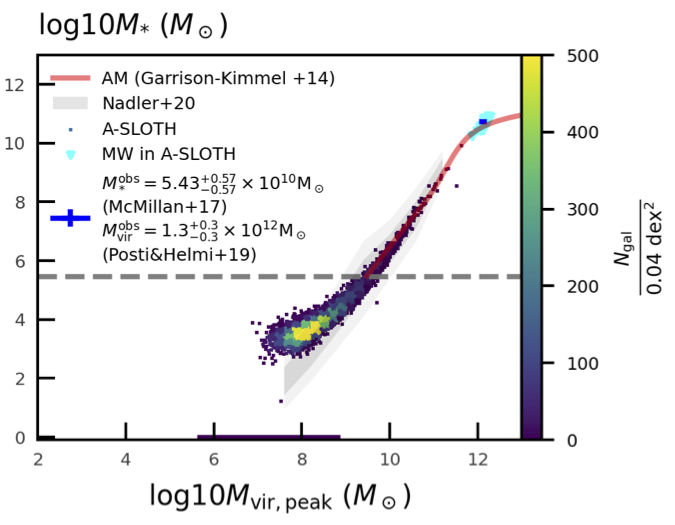
We study the stellar mass-to-halo mass relation at z = 0 in 30 Milky Way-like systems down to the ultra-faint (M* < 105M⊙) regime using the semi-analytic model A-SLOTH. A new model allows us to follow star formation and the stochastic stellar feedback from individually sampled Pop II stars. Our fiducial model produces consistent results with the stellar mass-to-halo mass relation derived from abundance matching and the observed cumulative stellar mass function above the observational completeness. We find a plateau in the stellar mass-to-halo mass relation in the ultra-faint regime. The stellar mass of this plateau tells us how many stars formed before supernovae occur and regulate further star formation, which is determined by the Pop II star formation efficiency. We also find that the number of luminous satellites increases rapidly as M* decreases until M* ≍ 104 M⊙. Finally, we find that the relative streaming velocity between baryons and dark matter at high redshift is important in determining the number of ultra-faint dwarf galaxies at z = 0. The new model in A-SLOTH provides a framework to study the stellar properties and the formation history of metal-poor stars in Milky Way and its satellites.
January 2022: The mean free path approximation and stellar collisions in star clusters: numerical exploration of the analytic rates and the role of perturbations on binary star mergers
Reinoso, Bastián; Leigh, Nathan W. C.; Barrera-Retamal, Carlos M.; Schleicher, Dominik; Klessen, Ralf S.; Stutz, Amelia M.: MNRAS, 509, 3724 – 3736 (2022) [ADS link]

In this paper, we compute predictions for the number of stellar collisions derived from analytic models based on the mean free path (MFP) approximation and compare them to the results of N-body simulations. Our goal is to identify the cluster conditions under which the MFP approximation remains valid. Adopting a range of particle numbers (100 ≤ N ≤ 5000) and different combinations of particle masses and radii, we explore three different channels leading to stellar collisions, all of which are expected to occur in realistic stellar environments. At high densities, binaries form from isolated three-body interactions of single stars. Hence, we consider collisions between single stars and collisions involving binary stars, after they form in our simulations. For the latter, we consider two channels for mergers, namely direct stellar collisions during chaotic single-binary interactions and perturbation-driven mergers of binaries due to random walks in eccentricity approaching unity. In the densest systems considered here, a very massive object is formed at the cluster centre, causing local stellar orbits to become increasingly Keplerian and the assumptions going into our analytic model to break down. Before reaching this limit, we obtain excellent agreement between our theoretical predictions and the simulations: The analytic rates are typically accurate to within one standard deviation for the entire parameter space considered here, but the agreement is best for short integration times. Our results have direct implications for blue straggler formation in dense star clusters, and stellar mergers in galactic nuclei hosting massive black holes.
December 2021: Fragmentation induced starvation in Population III star formation: A resolution study
Prole, Lewis R.; Clark, Paul C.; Klessen, Ralf S.; Glover, Simon C. O.: MNRAS, in press (2021) [ADS link]
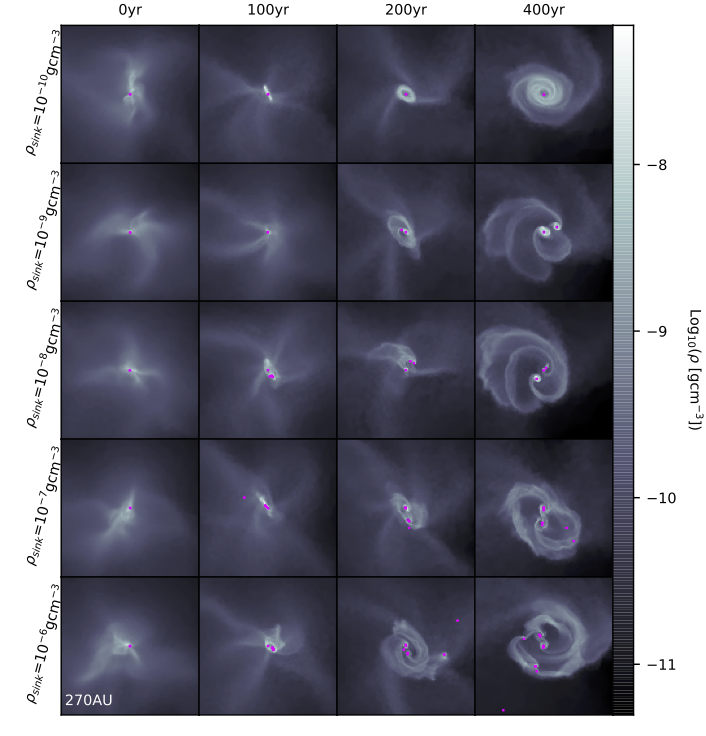
The Population III initial mass function (IMF) is currently unknown, but recent studies agree that fragmentation of primordial gas gives a broader IMF than the initially suggested singular star per halo. In this study we introduce sink particle mergers into AREPO, to perform the first resolution study for primordial star formation simulations and present the first Population III simulations to run up to densities of 10-6 g cm-3 for hundreds of years after the formation of sink particles. The total number of sinks formed increases with increasing sink particle creation density, without achieving numerical convergence. The total mass in sinks remains invariant to the maximum resolution and is safe to estimate using low resolution studies. This results in an IMF that shifts towards lower masses with increasing resolution. Greater numbers of sinks cause increased fragmentation-induced starvation of the most massive sink, yielding lower accretion rates, masses and ionising photons emitted per second. The lack of convergence up to densities 2 orders of magnitudes higher than all relevant chemical reactions suggests that the number of sinks will continue to grow with increasing resolution until H2 is fully dissociated and the collapse becomes almost adiabatic at 10-4 g cm-3. These results imply that many Population III studies utilising sink particles have produced IMFs which have overestimated the masses of primordial stars, and underestimated the number of stars formed. In the highest resolution runs, sinks with masses capable of surviving until the present day had an ejection fraction of 0.21.
November 2021: Measuring Young Stars in Space and Time. II. The Pre-main-sequence Stellar Content of N44
Ksoll, Victor F.; Gouliermis, Dimitrios; Sabbi, Elena; Ryon, Jenna E.; Robberto, Massimo; Gennaro, Mario; Klessen, Ralf S.; Koethe, Ullrich; de Marchi, Guido; Chen, C. -H. Rosie; Cignoni, Michele; Dolphin, Andrew E.: ApJ, 161, ID 257, 1 – 25 (2021) [ADS link]

The Hubble Space Telescope survey Measuring Young Stars in Space and Time (MYSST) entails some of the deepest photometric observations of extragalactic star formation, capturing even the lowest-mass stars of the active star-forming complex N44 in the Large Magellanic Cloud. We employ the new MYSST stellar catalog to identify and characterize the content of young pre-main-sequence (PMS) stars across N44 and analyze the PMS clustering structure. To distinguish PMS stars from more evolved line of sight contaminants, a non-trivial task due to several effects that alter photometry, we utilize a machine-learning classification approach. This consists of training a support vector machine (SVM) and a random forest (RF) on a carefully selected subset of the MYSST data and categorize all observed stars as PMS or non-PMS. Combining SVM and RF predictions to retrieve the most robust set of PMS sources, we find ∼26,700 candidates with a PMS probability above 95% across N44. Employing a clustering approach based on a nearest neighbor surface density estimate, we identify 16 prominent PMS structures at 1σ significance above the mean density with sub-clusters persisting up to and beyond 3σ significance. The most active star-forming center, located at the western edge of N44’s bubble, is a subcluster with an effective radius of ∼5.6 pc entailing more than 1100 PMS candidates. Furthermore, we confirm that almost all identified clusters coincide with known H II regions and are close to or harbor massive young O stars or YSOs previously discovered by MUSE and Spitzer observations.
October 2021: A multi-shock model for the density variance of anisotropic, highly-magnetised, supersonic turbulence
Haemmerlé, L.; Klessen, R. S.; Mayer, L.; Zwick, L.: A&A, 652, L7, 1 – 5 (2021) [ADS link]
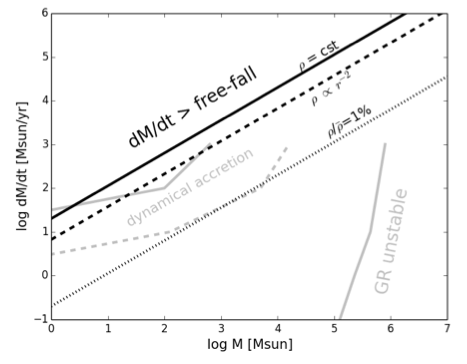
The formation of the most massive quasars observed at high redshifts requires extreme inflows of gas down to the length scales of the central compact object. Here we estimate the maximum inflow rate allowed by gravity down to the surface of supermassive stars, the possible progenitors of these supermassive black holes. We use the continuity equation and the assumption of spherical symmetry and free fall to derive the maximum allowed inflow rates for various density profiles. We apply our approach to the mass-radius relation of rapidly accreting supermassive stars to estimate an upper limit to the accretion rates allowed during the formation of these objects. We find that, as long as the density of the accreted gas is smaller than or equal to the average density of the accretor, the maximum allowed rate, Ṁmax, is given uniquely by the compactness of the accretor. We argue that a density inversion between accreting matter and the accretor is inconsistent with gravitational collapse. For the compactness of rapidly accreting supermassive stars, Ṁmax is related to the stellar mass, M, by a power law, Ṁmax ∝ M3/4. The rates of atomically cooled halos (0.1−10 M⊙ yr−1) are allowed as soon as M ≳ 1 M⊙. The largest rates expected in galaxy mergers (104 − 105 M⊙ yr−1) become accessible once the accretor is supermassive (M ≳ 104 M⊙). These results suggest that supermassive stars can accrete up to masses > 106 M⊙ before they collapse via the general-relativistic instability. At such masses, the collapse is expected to lead to the direct formation of a supermassive black hole, even within metal-rich gas, resulting in a black hole seed that is significantly heavier than in conventional direct collapse models for atomic cooling halos.
September 2021: The Cloud Factory II: gravoturbulent kinematics of resolved molecular clouds in a galactic potential
Syed, J.; Soler, J. D.; Beuther, H.; Wang, Y.; Suri, S.; Henshaw, J. D.; Riener, M.; Bialy, S.; Rezaei Kh., S.; Stil, J. M.; Goldsmith, P. F.; Rugel, M. R.; Glover, S. C. O.; Klessen, R. S.; Kerp, J.; Urquhart, J. S.; Ott, J.; Roy, N.; Schneider, N.; Smith, R. J.; Longmore, S. N.; Linz, H.: A&A, 657, A1, 1 – 19 (2021) [ADS link]

The atomic phase of the interstellar medium plays a key role in the formation process of molecular clouds. Due to the line-of-sight confusion in the Galactic plane that is associated with its ubiquity, atomic hydrogen emission has been challenging to study.
Aims: We investigate the physical properties of the „Maggie“ filament, a large-scale filament identified in H I emission at line-of-sight velocities, vLSR ~−54 km s−1. Employing the high-angular resolution data from The H I/OH Recombination line survey of the inner Milky Way (THOR), we have been able to study H I emission features at negative vLSR velocities without any line-of-sight confusion due to the kinematic distance ambiguity in the first Galactic quadrant. In order to investigate the kinematic structure, we decomposed the emission spectra using the automated Gaussian fitting algorithm GAUSSPY+. We identify one of the largest, coherent, mostly atomic H I filaments in the Milky Way. The giant atomic filament Maggie, with a total length of 1.2 ± 0.1 kpc, is not detected in most other tracers, and it does not show signs of active star formation. At a kinematic distance of 17 kpc, Maggie is situated below (by ≈500 pc), but parallel to, the Galactic H I disk and is trailing the predicted location of the Outer Arm by 5−10 km s−1 in longitude-velocity space. The centroid velocity exhibits a smooth gradient of less than ±3 km s−1 (10 pc)−1 and a coherent structure to within ±6 km s−1. The line widths of ~10 km s−1 along the spine of the filament are dominated by nonthermal effects. After correcting for optical depth effects, the mass of Maggie’s dense spine is estimated to be 7.2−1.9+2.5 × 105 M⊙. The mean number density of the filament is ~4 cm−3, which is best explained by the filament being a mix of cold and warm neutral gas. In contrast to molecular filaments, the turbulent Mach number and velocity structure function suggest that Maggie is driven by transonic to moderately supersonic velocities that are likely associated with the Galactic potential rather than being subject to the effects of self-gravity or stellar feedback. The probability density function of the column density displays a log-normal shape around a mean of ⟨NH I⟩ = 4.8 × 1020 cm−2, thus reflecting the absence of dominating effects of gravitational contraction. While Maggie’s origin remains unclear, we hypothesize that Maggie could be the first in a class of atomic clouds that are the precursors of giant molecular filaments.
August 2021: The influence of streaming velocities and Lyman-Werner radiation on the formation of the first stars
Schauer, Anna T. P.;Glover, Simon C. O.;Klessen, Ralf S.;Clark, Paul C.: MNRAS, 507, 1775 – 1787 (2021) [ADS link]
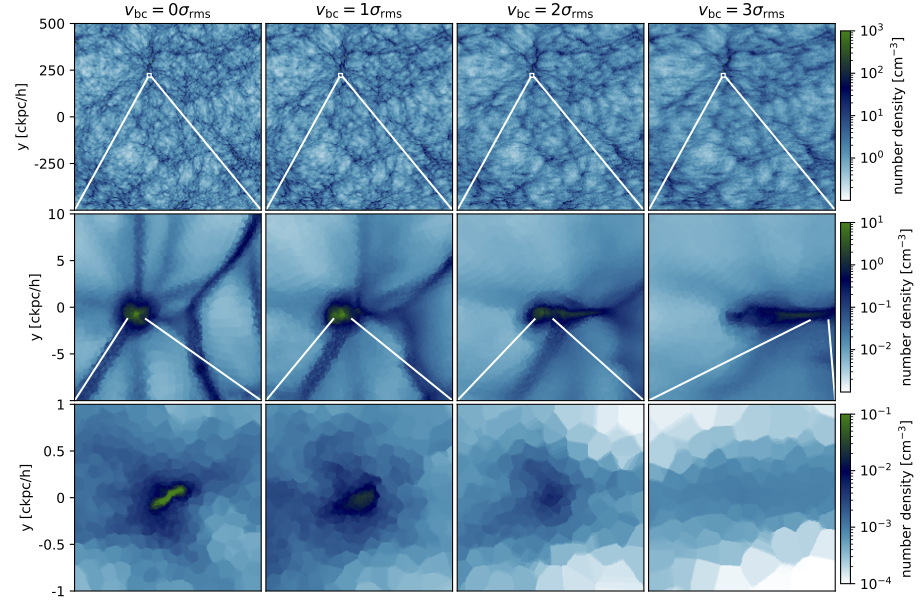
The first stars in the Universe, the so-called Population III stars, form in small dark matter minihaloes with virial temperatures Tvir < 104 K. Cooling in these minihaloes is dominated by molecular hydrogen (H2), and so Population III star formation is only possible in those minihaloes that form enough H2 to cool on a short timescale. As H2 cooling is more effective in more massive minihaloes, there is therefore a critical halo mass scale Mmin above which Population III star formation first becomes possible. Two important processes can alter this minimum mass scale: streaming of baryons relative to the dark matter and the photodissociation of H2 by a high redshift Lyman-Werner (LW) background. In this paper, we present results from a set of high resolution cosmological simulations that examine the impact of these processes on Mmin and on Mave (the average minihalo mass for star formation), both individually and in combination. We show that streaming has a bigger impact on Mmin than the LW background, but also that both effects are additive. We also provide a fitting functions quantifying the dependence of Mave and Mmin on the streaming velocity and the strength of the LW background.
Juli 2021: Bringing faint active galactic nuclei (AGNs) to light: a view from large-scale cosmological simulations
Schirra, Adrian P.; Habouzit, Mélanie; Klessen, Ralf S.; Fornasini, Francesca; Nelson, Dylan;Pillepich, Annalisa; Anglés-Alcázar, Daniel; Davé, Romeel; Civano, Francesca: MNRAS, 508, 4816 – 4843 (2021) [ADS link]
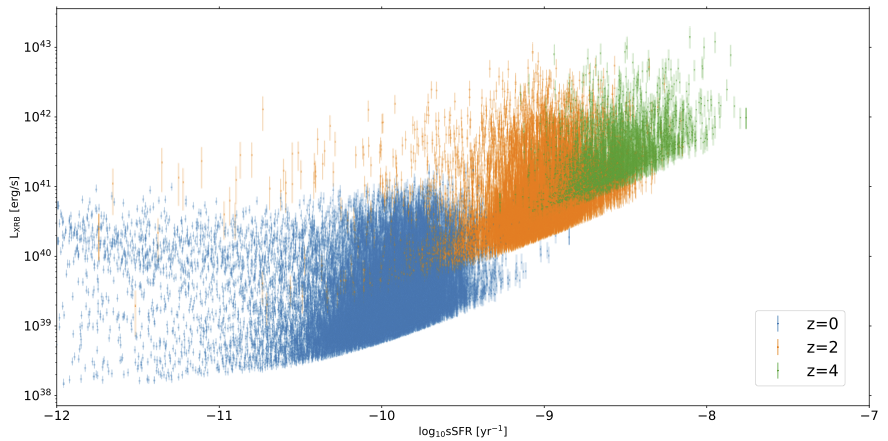
The sensitivity of X-ray facilities and our ability to detect fainter active galactic nuclei (AGNs) will increase with the upcoming Athena mission and the AXIS and Lynx concept missions, thus improving our understanding of supermassive black holes (BHs) in a luminosity regime that can be dominated by X-ray binaries. We analyse the population of faint AGNs in the Illustris, TNG100, EAGLE, and SIMBA cosmological simulations, and find that the properties of their host galaxies vary from one simulation to another. In Illustris and EAGLE, faint AGNs are powered by low-mass BHs located in low-mass star-forming galaxies. In TNG100 and SIMBA, they are mostly associated with more massive BHs in quenched massive galaxies. We model the X-ray binary (XRB) populations of the simulated galaxies, and find that AGNs often dominate the galaxy AGN + XRB hard X-ray luminosity at z > 2, while XRBs dominate in some simulations at z < 2. Whether the AGN or XRB emission dominates in star-forming and quenched galaxies depends on the simulations. These differences in simulations can be used to discriminate between galaxy formation models with future high-resolution X-ray observations. We compare the luminosity of simulated faint AGN host galaxies to observations of stacked galaxies from Chandra. Our comparison indicates that the simulations post-processed with our X-ray modelling tend to overestimate the AGN + XRB X-ray luminosity; luminosity that can be strongly affected by AGN obscuration. Some simulations reveal clear AGN trends as a function of stellar mass (e.g. galaxy luminosity drop in massive galaxies), which are not apparent in the observations.
Juni 2021: Simulations of the star-forming molecular gas in an interacting M51-like galaxy: cloud population statistics
Treß, Robin G.; Sormani, Mattia C.; Smith, Rowan J.; Glover, Simon C. O.; Klessen, Ralf S.; Mac Low, Mordecai-Mark; Clark, Paul C.; Duarte-Cabral, Ana: MNRAS, 505, 5438 – 5459 (2021) [ADS link]
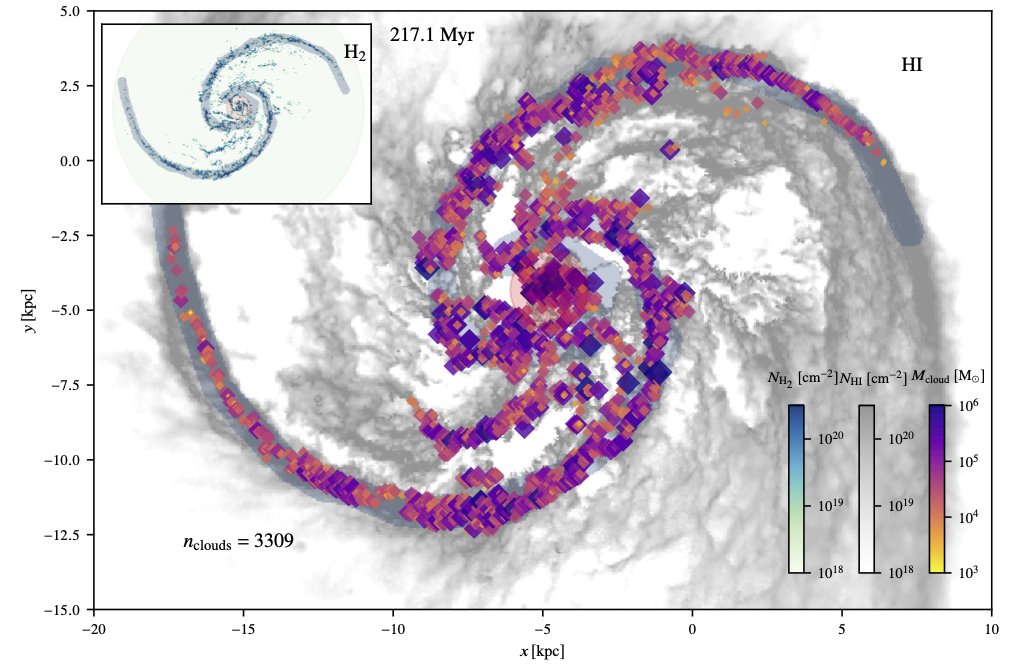
To investigate how molecular clouds react to different environmental conditions at a galactic scale, we present a catalogue of giant molecular clouds (GMCs) resolved down to masses of ~10 M⊙ from a simulation of the entire disc of an interacting M51-like galaxy and a comparable isolated galaxy. Our model includes time-dependent gas chemistry, sink particles for star formation, and supernova feedback, meaning we are not reliant on star formation recipes based on threshold densities and can follow the physics of the cold molecular phase. We extract GMCs from the simulations and analyse their properties. In the disc of our simulated galaxies, spiral arms seem to act merely as snowplows, gathering gas, and clouds without dramatically affecting their properties. In the centre of the galaxy, on the other hand, environmental conditions lead to larger, more massive clouds. While the galaxy interaction has little effect on cloud masses and sizes, it does promote the formation of counter-rotating clouds. We find that the identified clouds seem to be largely gravitationally unbound at first glance, but a closer analysis of the hierarchical structure of the molecular interstellar medium shows that there is a large range of virial parameters with a smooth transition from unbound to mostly bound for the densest structures. The common observation that clouds appear to be virialized entities may therefore be due to CO bright emission highlighting a specific level in this hierarchical binding sequence. The small fraction of gravitationally bound structures found suggests that low galactic star formation efficiencies may be set by the process of cloud formation and initial collapse.
May 2021: The Cloud Factory II: gravoturbulent kinematics of resolved molecular clouds in a galactic potential
Izquierdo, Andrés F. ; Smith, Rowan J. ; Glover, Simon C. O. ; Klessen, Ralf S. ; Treß, Robin G. ; Sormani, Mattia C. ; Clark, Paul C. ; Duarte-Cabral, Ana ; Zucker, Catherine.: MNRAS, 500, 5268 – 5296 (2021) [ADS link]
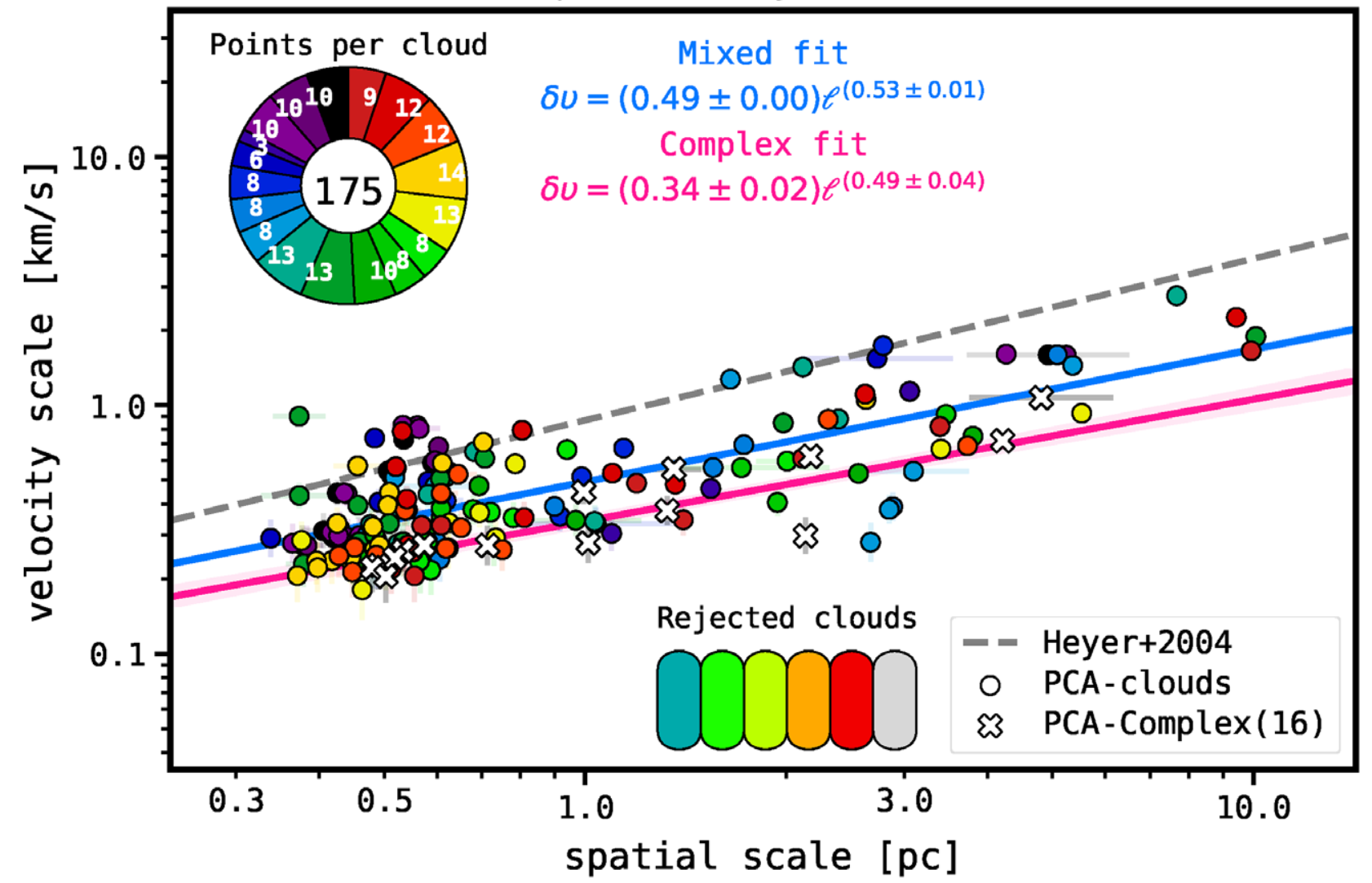
We present a statistical analysis of the gravoturbulent velocity fluctuations in molecular cloud complexes extracted from our ‘Cloud Factory’ Galactic-scale interstellar medium (ISM) simulation suite. For this purpose, we produce non-local thermodynamic equilibrium 12CO J = 1 − 0 synthetic observations and apply the principal component analysis (PCA) reduction technique on a representative sample of cloud complexes. The velocity fluctuations are self-consistently generated by different physical mechanisms at play in our simulations, which include Galactic-scale forces, gas self-gravity, and supernova feedback. The statistical analysis suggests that, even though purely gravitational effects are necessary to reproduce standard observational laws, they are not sufficient in most cases. We show that the extra injection of energy from supernova explosions plays a key role in establishing the global turbulent field and the local dynamics and morphology of molecular clouds. Additionally, we characterize structure function scaling parameters as a result of cloud environmental conditions: some of the complexes are immersed in diffuse (interarm) or dense (spiral-arm) environments, and others are influenced by embedded or external supernovae. In quiescent regions, we obtain time-evolving trajectories of scaling parameters driven by gravitational collapse and supersonic turbulent flows. Our findings suggest that a PCA-based statistical study is a robust method to diagnose the physical mechanisms that drive the gravoturbulent properties of molecular clouds. Also, we present a new open source module, the pcafactory, which smartly performs PCA to extract velocity structure functions from simulated or real data of the ISM in a user-friendly way.
April 2021: A multi-shock model for the density variance of anisotropic, highly-magnetised, supersonic turbulence
Beattie, James R.; Mocz, Philip; Federrath, Christoph; Klessen, Ralf S.: MNRAS, in press (2021) [ADS link]

Shocks form the basis of our understanding for the density and velocity statistics of supersonic turbulent flows, such as those found in the cool interstellar medium (ISM). The variance of the density field, σ2ρ/ρ0, is of particular interest for molecular clouds (MCs), the birthplaces of stars in the Universe. The density variance may be used to infer underlying physical processes in an MC, and parameterises the star formation (SF) rate of a cloud. However, models for σ2ρ/ρ0 all share a common feature – the variance is assumed to be isotropic. This assumption does not hold when a trans/sub-Alfvénic mean magnetic field, B0, is present in the cloud, which observations suggest is relevant for some MCs. We develop an anisotropic model for σ2ρ/ρ0, using contributions from hydrodynamical and fast magnetosonic shocks that propagate orthogonal to each other. Our model predicts an upper bound for σ2ρ/ρ0 in the high Mach number (M) limit as small-scale density fluctuations become suppressed by the strong B0. The model reduces to the isotropic σ2ρ/ρ0−M relation in the hydrodynamical limit. To validate our model, we calculate σ2ρ/ρ0 from 12 high-resolution, three-dimensional, supersonic, sub-Alfvénic magnetohydrodynamical (MHD) turbulence simulations and find good agreement with our theory. We discuss how the two MHD shocks may be the bimodally oriented over-densities observed in some MCs and the implications for SF theory in the presence of a sub-Alfvénic B0. By creating an anisotropic, supersonic density fluctuation model, this study paves the way for SF theory in the highly anisotropic regime of interstellar turbulence.
March 2021: Measuring Young Stars in Space and Time — I. The Photometric Catalog and Extinction Properties of N44
Ksoll, Victor F.; Gouliermis, Dimitrios; Sabbi, Elena; Ryon, Jenna E.; Robberto, Massimo; Gennaro, Mario; Klessen, Ralf S.; Koethe, Ullrich; de Marchi, Guido; Chen, C. -H. Rosie; Cignoni, Michele; Dolphin, Andrew E.: Astronomical Journal, in press (2021) [ADS link]
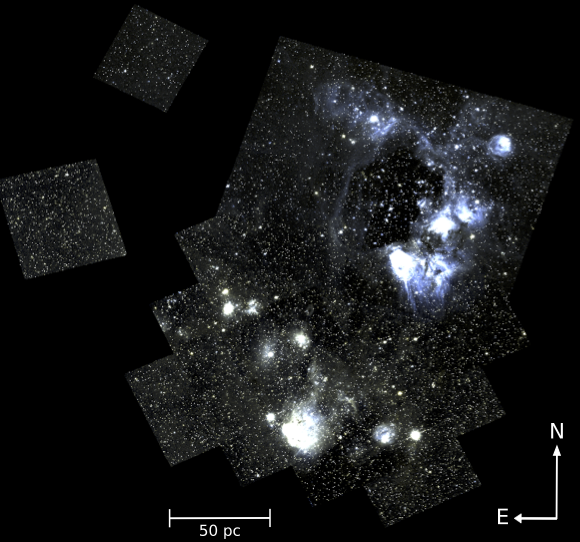
In order to better understand the role of high-mass stellar feedback in regulating star formation in giant molecular clouds, we carried out a Hubble Space Telescope (HST) Treasury Program „Measuring Young Stars in Space and Time“ (MYSST) targeting the star-forming complex N44 in the Large Magellanic Cloud (LMC). Using the F555W and F814W broadband filters of both the ACS and WFC3/UVIS, we built a photometric catalog of 461,684 stars down to mF555W≃29mag and mF814W≃28mag, corresponding to the magnitude of an unreddened 1 Myr pre-main-sequence star of ≈0.09M⊙ at the LMC distance. In this first paper we describe the observing strategy of MYSST, the data reduction procedure, and present the photometric catalog. We identify multiple young stellar populations tracing the gaseous rim of N44’s super bubble, together with various contaminants belonging to the LMC field population. We also determine the reddening law from the slope of the red clump feature by applying the machine learning algorithm RANSAC, and we select a set of Upper Main Sequence (UMS) stars as primary probes to build an extinction map, deriving a relatively modest median extinction AF555W≃0.77mag. The same procedure applied to the red clump provides AF555W≃0.68mag.
February 2021: The sonic scale of interstellar turbulence
Federrath, Christoph; Klessen, Ralf S.; Iapichino, Luigi; Beattie, James R.: Nature Astronomy (2021) [LINK: DOI: 10.1038/s41550-020-01282-zk]
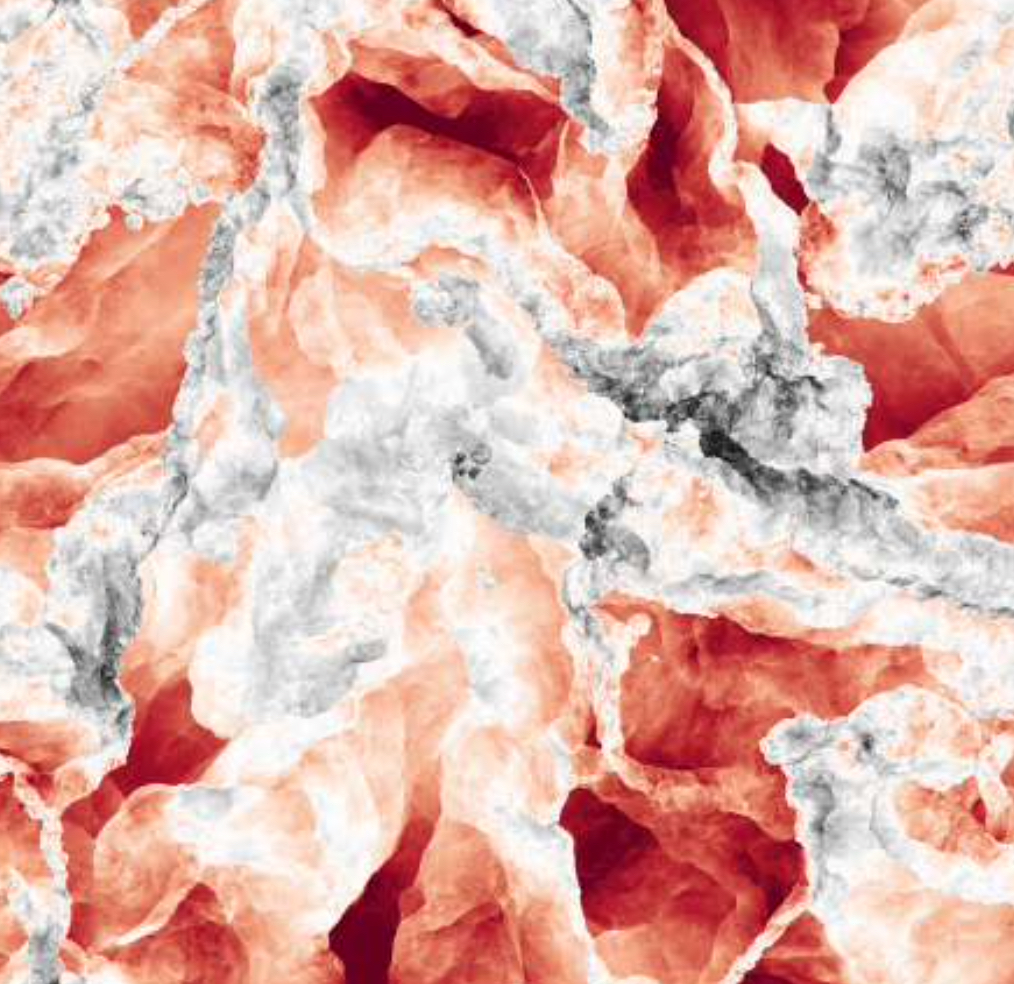
Understanding the physics of turbulence is crucial for many applications, including weather, industry and astrophysics. In the interstellar medium, supersonic turbulence plays a crucial role in controlling the gas density and velocity structure, and ultimately the birth of stars. Here we present a simulation of interstellar turbulence with a grid resolution of 10,0483 cells that allows us to determine the position and width of the sonic scale (ℓs) — the transition from supersonic to subsonic turbulence. The simulation simultaneously resolves the supersonic and subsonic cascade, with the velocity as a function of scale, v(ℓ) ∝ ℓp, where we measure psup = 0.49 ± 0.01 and psub = 0.39 ± 0.02, respectively. We find that ℓs agrees with the relation ℓs=ϕsL M-1 /psup ?, where M ? is the three-dimensional Mach number, L is either the driving scale of the turbulence or the diameter of a molecular cloud, and ϕs is a dimensionless factor of order unity. If L is the driving scale, we measure ϕs=0.4 2-0.09+0.12 ?, primarily because of the separation between the driving scale and the start of the supersonic cascade. For a supersonic cascade extending beyond the cloud scale, we get ϕs=0.9 1-0.20+0.25 ? In both cases, ϕs ≲ 1, because we find that the supersonic cascade transitions smoothly to the subsonic cascade over a factor of 3 in scale, instead of a sharp transition. Our measurements provide quantitative input for turbulence-regulated models of filament structure and star formation in molecular clouds.
January 2021: Magnetic fields in star-forming systems – II: Examining dust polarization, the Zeeman effect, and the Faraday rotation measure as magnetic field tracers
Reissl, Stefan; Stutz, Amelia M.; Klessen, Ralf S.; Seifried, Daniel; Walch, Stefanie: MNRAS, 500, 153 – 176 (2021) [ADS link]

The degree to which the formation and evolution of clouds and filaments in the interstellar medium is regulated by magnetic fields remains an open question. Yet the fundamental properties of the fields (strength and 3D morphology) are not readily observable. We investigate the potential for recovering magnetic field information from dust polarization, the Zeeman effect, and the Faraday rotation measure (RM) in a SILCC-Zoom magnetohydrodynamic (MHD) filament simulation. The object is analysed at the onset of star formation and it is characterized by a line-mass of about (M/L) ∼ 63 M⊙ pc−1 out to a radius of 1 pc and a kinked 3D magnetic field morphology. We generate synthetic observations via POLARIS radiative transfer (RT) post-processing and compare with an analytical model of helical or kinked field morphology to help interpreting the inferred observational signatures. We show that the tracer signals originate close to the filament spine. We find regions along the filament where the angular dependence with the line of sight (LOS) is the dominant factor and dust polarization may trace the underlying kinked magnetic field morphology. We also find that reversals in the recovered magnetic field direction are not unambiguously associated to any particular morphology. Other physical parameters, such as density or temperature, are relevant and sometimes dominant compared to the magnetic field structure in modulating the observed signal. We demonstrate that the Zeeman effect and the RM recover the line-of-sight magnetic field strength to within a factor 2.1-3.4. We conclude that the magnetic field morphology may not be unambiguously determined in low-mass systems by observations of dust polarization, Zeeman effect, or RM, whereas the field strengths can be reliably recovered.
December 2020: Synthetic observations of spiral arm tracers of a simulated Milky Way analog
Reissl, S.; Stil, J. M.; Chen, E.; Treß, R. G.; Sormani, M. C.; Smith, R. J.; Klessen, R. S.; Buick, M.; Glover, S. C. O.; Shanahan, R.; Lemmer, S. J.; Soler, J. D.; Beuther, H.; Urquhart, J. S.; Anderson, L. D.; Menten, K. M.; Brunthaler, A.; Ragan, S.; Rugel, M. R.: A&A, 642, A201, 1 – 15 (2020) [ADS link]
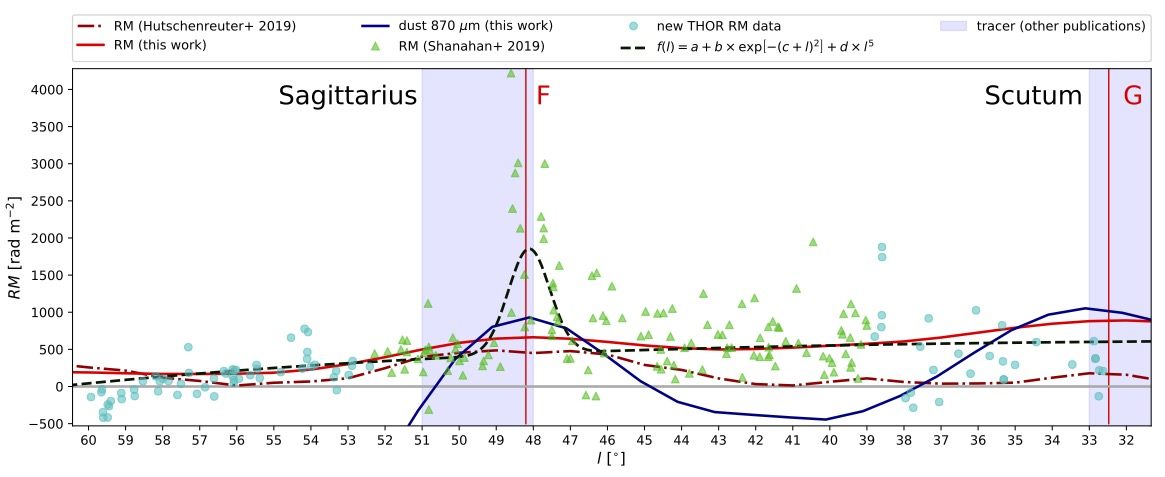
Context: The Faraday rotation measure (RM) is often used to study the magnetic field strength and orientation within the ionized medium of the Milky Way. Recent observations indicate an RM magnitude in the spiral arms that exceeds the commonly assumed range. This raises the question of how and under what conditions spiral arms create such strong Faraday rotation.
Aims: We investigate the effect of spiral arms on Galactic Faraday rotation through shock compression of the interstellar medium. It has recently been suggested that the Sagittarius spiral arm creates a strong peak in Faraday rotation where the line of sight is tangent to the arm, and that enhanced Faraday rotation follows along side lines which intersect the arm. Here our aim is to understand the physical conditions that may give rise to this effect and the role of viewing geometry.
Methods: We apply a magnetohydrodynamic simulation of the multi-phase interstellar medium in a Milky Way-type spiral galaxy disk in combination with radiative transfer in order to evaluate different tracers of spiral arm structures. For observers embedded in the disk, dust intensity, synchrotron emission, and the kinematics of molecular gas observations are derived to identify which spiral arm tangents are observable. Faraday rotation measures are calculated through the disk and evaluated in the context of different observer positions. The observer’s perspectives are related to the parameters of the local bubbles surrounding the observer and their contribution to the total Faraday rotation measure along the line of sight.
Results: We reproduce a scattering of tangent points for the different tracers of about 6° per spiral arm similar to the Milky Way. For the RM, the model shows that compression of the interstellar medium and associated amplification of the magnetic field in spiral arms enhances Faraday rotation by a few hundred rad m-2 in addition to the mean contribution of the disk. The arm-interarm contrast in Faraday rotation per unit distance along the line of sight is approximately ~10 in the inner Galaxy, fading to ~2 in the outer Galaxy in tandem with the waning contrast of other tracers of spiral arms. We identify a shark fin pattern in the RM Milky Way observations and in the synthetic data that is characteristic for a galaxy with spiral arms.
November 2020: Stellar parameter determination from photometry using invertible neural networks
Ksoll, Victor F.; Ardizzone, Lynton; Klessen, Ralf S.; Koethe, Ullrich; Sabbi, Elena; Robberto, Massimo; Gouliermis, Dimitrios; Rother, Carsten; Zeidler, Peter; Gennaro, Mario: MNRAS, 499, 5447 – 5485 (2020) [ADS link]
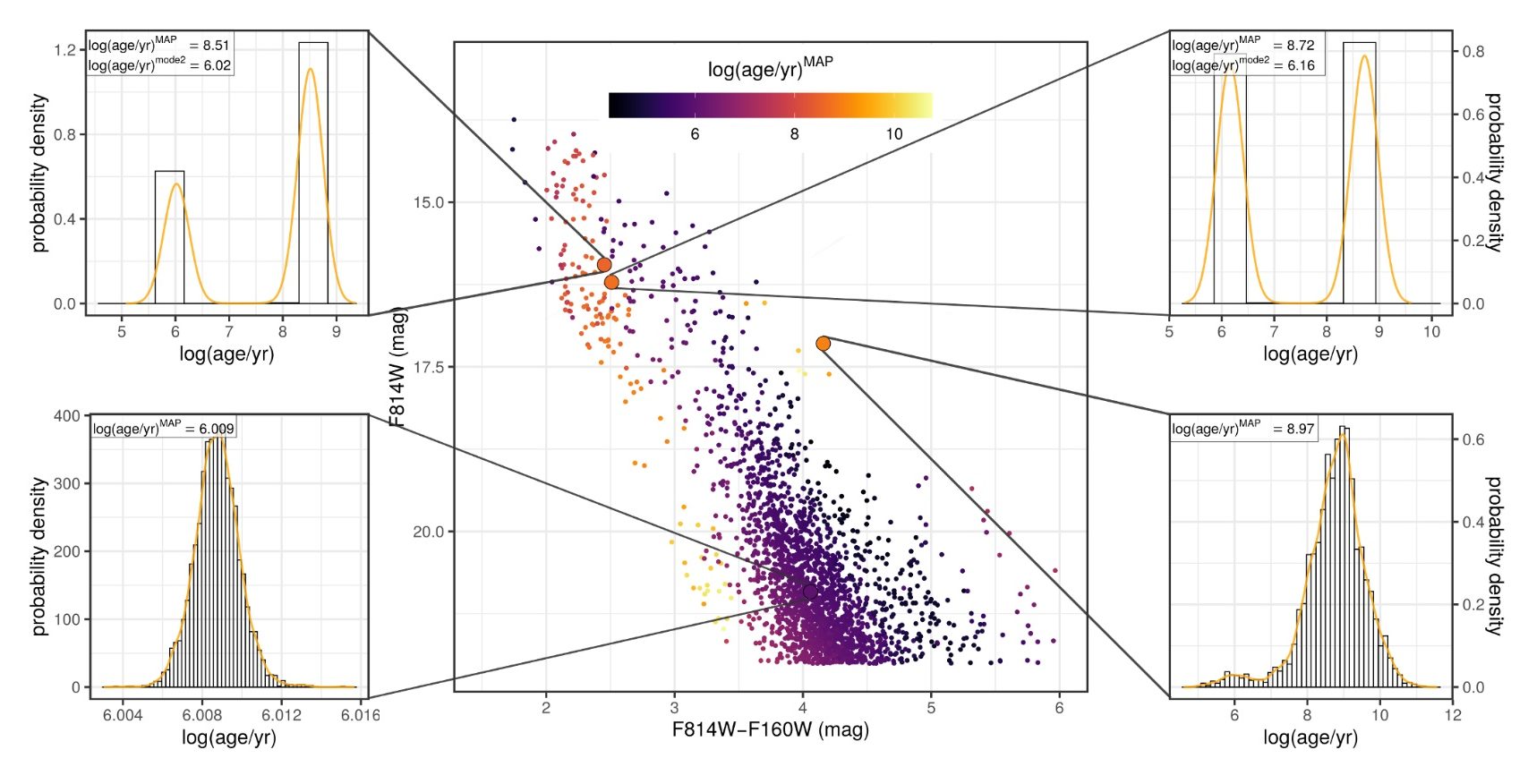
Photometric surveys with the Hubble Space Telescope (HST) allow us to study stellar populations with high-resolution and deep coverage, with estimates of the physical parameters of the constituent stars being typically obtained by comparing the survey data with adequate stellar evolutionary models. This is a highly non-trivial task due to effects such as differential extinction, photometric errors, low filter coverage, or uncertainties in the stellar evolution calculations. These introduce degeneracies that are difficult to detect and break. To improve this situation, we introduce a novel deep learning approach, called conditional invertible neural network (cINN), to solve the inverse problem of predicting physical parameters from photometry on an individual star basis and to obtain the full posterior distributions. We build a carefully curated synthetic training data set derived from the PARSEC stellar evolution models to predict stellar age, initial/current mass, luminosity, effective temperature, and surface gravity. We perform tests on synthetic data from the MIST and Dartmouth models, and benchmark our approach on HST data of two well-studied stellar clusters, Westerlund 2 and NGC 6397. For the synthetic data, we find overall excellent performance, and note that age is the most difficult parameter to constrain. For the benchmark clusters, we retrieve reasonable results and confirm previous findings for Westerlund 2 on cluster age ( 1.04+8.48−0.90Myr ), mass segregation, and the stellar initial mass function. For NGC 6397, we recover plausible estimates for masses, luminosities, and temperatures, however, discrepancies between stellar evolution models and observations prevent an acceptable recovery of age for old stars.
October 2020: Jeans modelling of the Milky Way’s nuclear stellar disc
Sormani, Mattia C.; Magorrian, John; Nogueras-Lara, Francisco; Neumayer, Nadine; Schönrich, Ralph; Klessen, Ralf S.; Mastrobuono-Battisti, Alessandra: MNRAS, 499, 7 – 24 (2020) [ADS link]
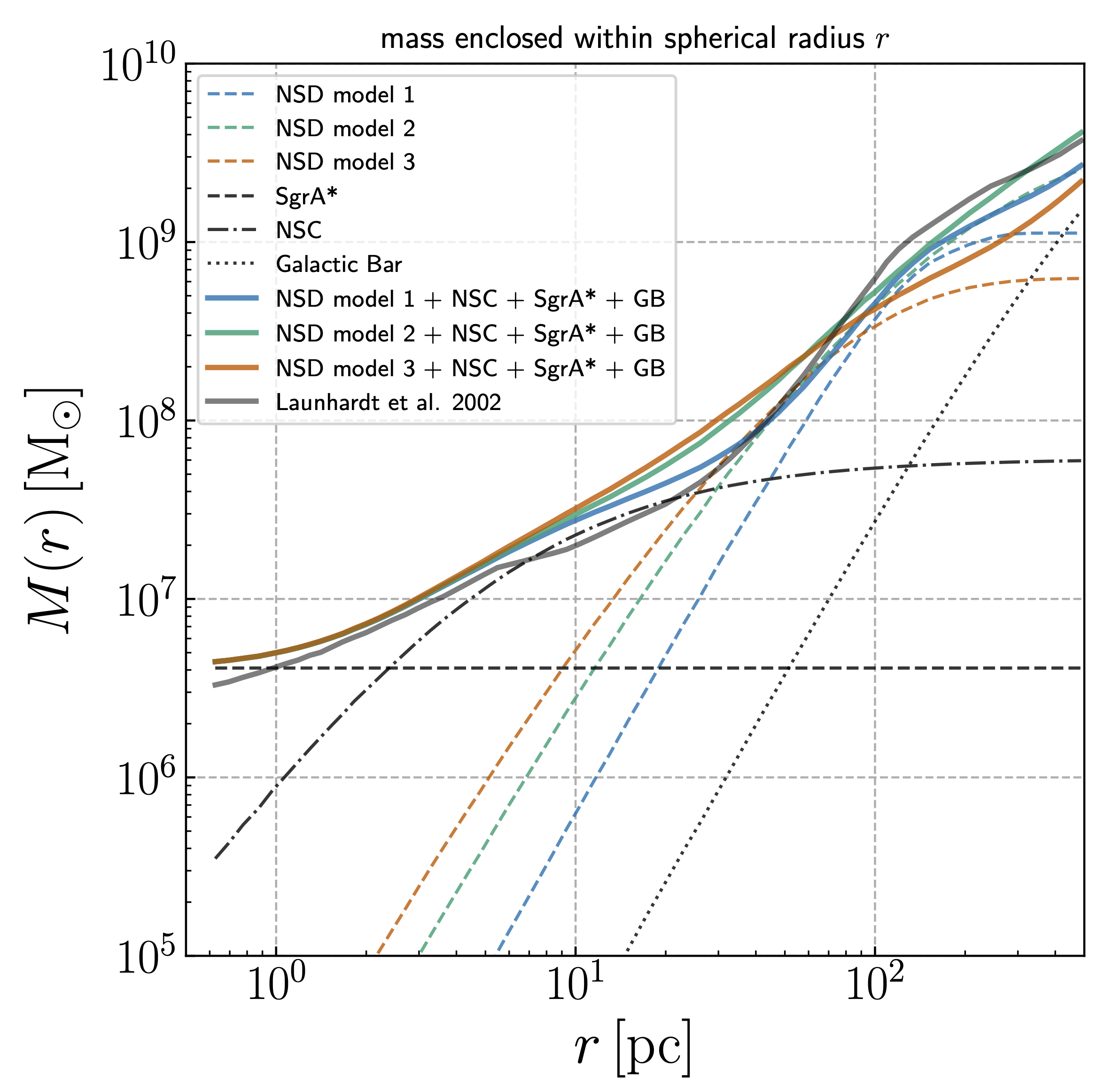
The nuclear stellar disc (NSD) is a flattened stellar structure that dominates the gravitational potential of the Milky Way at Galactocentric radii 30 ≲ R ≲ 300 pc. In this paper, we construct axisymmetric Jeans dynamical models of the NSD based on previous photometric studies and we fit them to line-of-sight kinematic data of APOGEE and SiO maser stars. We find that (i) the NSD mass is lower but consistent with the mass independently determined from photometry by Launhardt et al. (2002). Our fiducial model has a mass contained within spherical radius r = 100 pc of M(r < 100pc) = 3.9 ± 1 × 108M⊙ and a total mass of MNSD = 6.9 ± 2 × 108 M⊙ . (ii) The NSD might be the first example of a vertically biased disc, i.e. with ratio between the vertical and radial velocity dispersion σz/σR > 1. Observations and theoretical models of the star-forming molecular gas in the central molecular zone suggest that large vertical oscillations may be already imprinted at stellar birth. However, the finding σz/σR > 1 depends on a drop in the velocity dispersion in the innermost few tens of parsecs, on our assumption that the NSD is axisymmetric, and that the available (extinction corrected) stellar samples broadly trace the underlying light and mass distributions, all of which need to be established by future observations and/or modelling. (iii) We provide the most accurate rotation curve to date for the innermost 500 pc of our Galaxy.
September 2020: WARPFIELD population synthesis: the physics of (extra-)Galactic star formation and feedback-driven cloud structure and emission from sub-to-kpc scales
Pellegrini, Eric W.; Reissl, Stefan; Rahner, Daniel; Klessen, Ralf S.; Glover, Simon C. O.; Pakmor, Rüdiger; Herrera-Camus, Rodrigo; Grand, Robert J. J.: MNRAS, 498, 3193 – 3214 (2020) [ADS link]
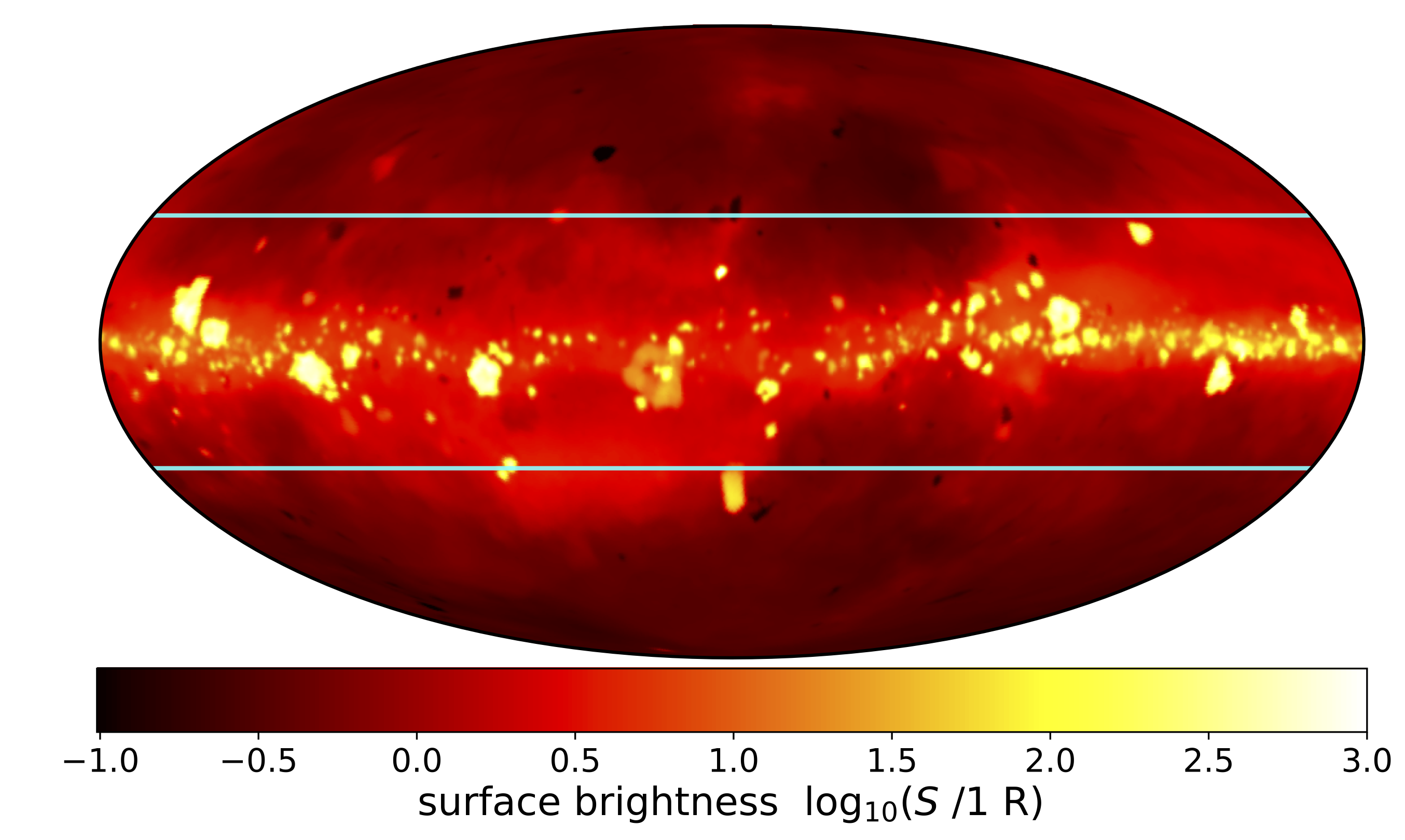
Synthetic all-sky Hα emission map as seen by an observer at the position of the Earch in a simulated Milky Way-like galaxy.
We present a novel method to model galactic-scale star formation and emission of star clusters and a multiphase interstellar medium (ISM). We combine global parameters, including star formation rate and metallicity, with the 1D cloud evolution code WARPFIELD to model the sources of feedback within a star-forming galaxy. Within individual star-forming regions, we include stellar evolution, stellar winds, radiation pressure, and supernovae, all coupled to the dynamical evolution of the 1D parental cloud in a highly non-linear fashion. Heating of the diffuse galactic gas and dust is calculated self-consistently with the age-, mass-, and density-dependent escape fractions of photons from these fully resolved local star-forming regions. We construct the interstellar radiation field, and we employ the multifrequency radiative transfer code POLARIS to produce synthetic emission maps for a one-to-one comparison with observations. We apply this to a cosmological simulation of a Milky-Way-like galaxy built-up in a high-resolution MHD simulation of cosmic structure formation. From this, we produce the multiscale/phase distribution of ISM density and temperature and present a synthesized all-sky H α map. We use a multipole expansion to show that the resulting maps reproduce all observed statistical emission characteristics. Next, we predict [S III] 9530 Å, a key emission line that will be observed in several large forthcoming surveys. It suffers less extinction than other lines and provides information about star formation in very dense environments that are otherwise observationally inaccessible optically. Finally, we explore the effects of differential extinction, and discuss the consequences for the interpretation of H α emission at different viewing angles by an extragalactic observer.
August 2020: A minimum dilution scenario for supernovae and consequences for extremely metal-poor stars
Magg, Mattis; Nordlander, Thomas; Glover, Simon C. O.; Hansen, Camilla J.; Ishigaki, Miho; Heger, Alexander; Klessen, Ralf S.; Kobayashi, Chiaki; Nomoto, Ken’ichi: MNRAS, 496, 3703 – 3712 (2020) [ADS link]
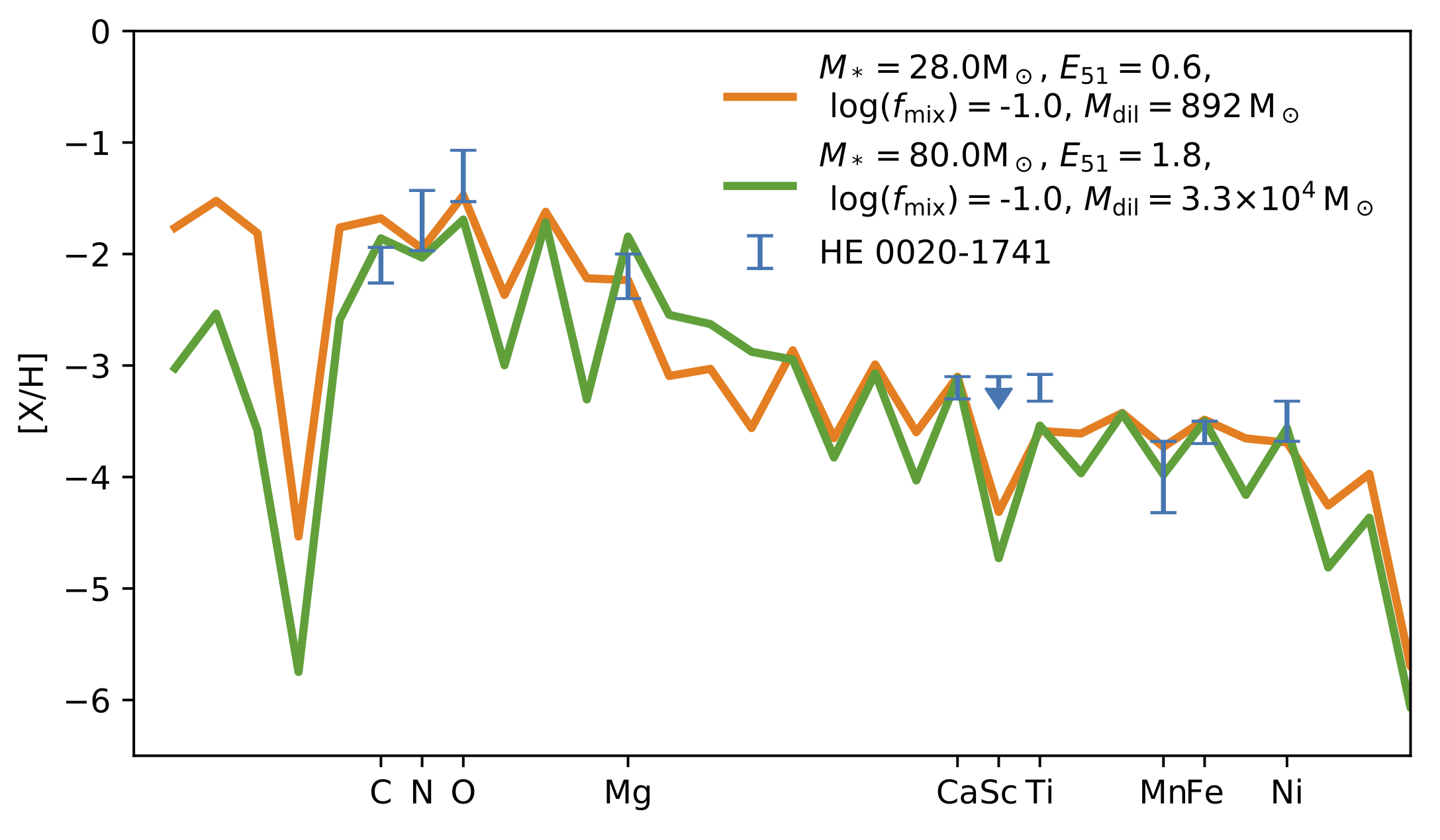
Best-fitting abundance patterns for HE 0020-1741. The dilation-mass constraint rules out a single low-mass progenitor star responsible for the enrichment.
To date no metal-free stars have been identified by direct observations. The most common method of constraining their properties is searching the spectra of the most metal-poor stars for the chemical elements created in the first stars and their supernova (SN). In this approach, modelled SN yields are compared to the observed abundance patterns in extremely metal-poor stars. The method typically only uses the abundance ratios, i.e. the yields are diluted to the observed level. Following the usual assumption of spherical symmetry we compute a simple lower limit of the mass an SN can mix with and find that it is consistent with all published simulations of early chemical enrichment in the interstellar medium. For three different cases, we demonstrate that this dilution limit can change the conclusions from the abundance fitting. There is a large discrepancy between the dilution found in simulations of SN explosions in minihaloes and the dilution assumed in many abundance fits. Limiting the dilution can significantly alter the likelihood of which supernovae are possible progenitors of observed CEMP-no stars. In particular, some of the faint, very low yield SNe, which have been suggested as models for the abundance pattern of SMSS0313-6708, cannot explain the measured metal abundances, as their predicted metal yields are too small by two orders of magnitude. Altogether, the new dilution model presented here emphasizes the need to better understand the mixing and dilution behaviour of aspherical SNe.
July 2020: A systematic study of radiative torque grain alignment in the diffuse interstellar medium
Reissl, Stefan; Guillet, Vincent; Brauer, Robert; Levrier, François; Boulanger, François; Klessen, Ralf S.: A&A, 640, A118, 1 – 22 (2020) [ADS link]

Dust alignment radii resulting from radiative torques (RAT) in an MHD simulation of the turbulent ISM calculated with POLARIS.
Context: Analyses of Planck data have demonstrated that the grain alignment efficiency is almost constant in the diffuse and translucent interstellar medium (ISM).
Aims: We aim to test whether the radiative torque (RAT) theory is compatible with these new observational constraints on grain alignment.
Methods: We combine a numerical magnetohydrodynamical simulation with a state-of-the-art radiative transfer post-processing code POLARIS which incorporates a physical dust model and the detailed physics of grain alignment by RATs. A dust model based on two distinct power-law-sized distributions of spherical graphite grains and oblate silicate grains was designed to reproduce the mean spectral dependence of extinction and polarization observed in the diffuse ISM. From a simulation of interstellar turbulence obtained with the adaptive-mesh-refinement code RAMSES, we extracted a data cube with physical conditions representative of the diffuse ISM. We post-process the RAMSES cube with POLARIS to compute the grain temperature and alignment efficiency in each cell of the cube. Finally, we simulate synthetic dust emission and polarization observations.
Results: In our simulation, the grain alignment efficiency is well-correlated with the gas pressure, but not with the radiative torque intensity. Because of the low dust extinction in our simulation, the magnitude of the radiative torque varies little, decreasing only for column densities larger than 1022 cm-2. In comparing our synthetic maps with those obtained assuming a uniform alignment efficiency, we find no systematic difference and very small random differences. The dependencies of the polarization fraction p with the column density NH or with the dispersion in polarization angle S are also similar in both cases. The drop of grain alignment produced by the RAT model in the denser cells of the data cube does not significantly affect the patterns of the synthetic polarization maps, the polarization signal being dominated by the line-of-sight and beam integration of the geometry of the magnetic field. If a star is artificially inserted at the center of the simulation, the polarization fraction is increased everywhere, with no specific pattern around the star. The angle-dependence of the RAT efficiency is not observed in simulated maps and where the magnetic field is artificially set to a uniform configuration in the plane of the sky, it is only seen to be very weak in the optimal configuration.
Conclusions: The RAT alignment theory is found to be compatible with the Planck polarization data for the diffuse and translucent ISM in the sense that both uniform alignment and RAT alignment lead to very similar simulated maps. To further test the predictions of the RAT theory in an environment where an important drop of grain alignment is expected, high-resolution polarization observations of dense regions must be confronted with numerical simulations sampling high-column densities (NH > 1022 cm-2) through dense clouds, given a sufficient statistical basis.
June 2020: Simulations of the Milky Way’s Central Molecular Zone – II. Star formation
Sormani, Mattia C.; Tress, Robin G.; Glover, Simon C. O.; Klessen, Ralf S.; Battersby, Cara D.; Clark, Paul C.; Hatchfield, H. Perry; Smith, Rowan J.: MNRAS, 497, 5024 – 5040 (2020) [ADS link]
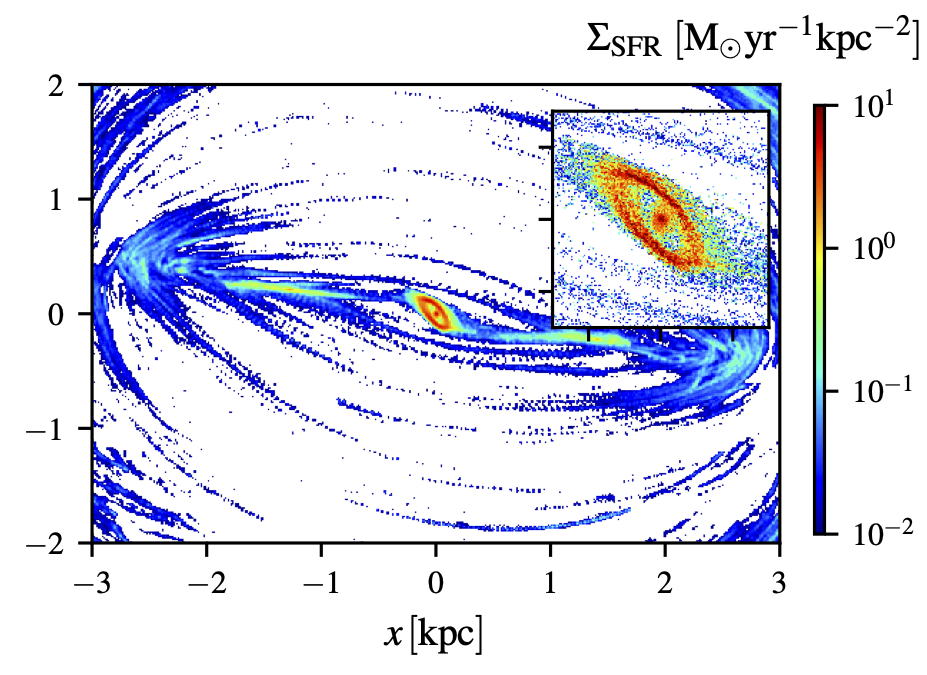
Mean star formation rate surface density averaged over a period of 20 Myr in the inner 3 kpc of a synthetic Milky Way like galaxy.
The Milky Way’s Central Molecular Zone (CMZ) has emerged in recent years as a unique laboratory for the study of star formation. Here we use the simulations presented in Tress et al. to investigate star formation in the CMZ. These simulations resolve the structure of the interstellar medium at sub-parsec resolution while also including the large-scale flow in which the CMZ is embedded. Our main findings are as follows. (1) While most of the star formation happens in the CMZ ring at R ≳ 100pc, a significant amount also occurs closer to Sgr A* at R≲10pc. (2) Most of the star formation in the CMZ happens downstream of the apocentres, consistent with the ‚pearls-on-a-string‘ scenario, and in contrast to the notion that an absolute evolutionary timeline of star formation is triggered by pericentre passage. (3) Within the time-scale of our simulations (∼100 Myr), the depletion time of the CMZ is constant within a factor of ∼2. This suggests that variations in the star formation rate are primarily driven by variations in the mass of the CMZ, caused, for example, by active galactic nuclei (AGN) feedback or externally induced changes in the bar-driven inflow rate, and not by variations in the depletion time. (4) We study the trajectories of newly born stars in our simulations. We find several examples that have age and 3D velocity compatible with those of the Arches and Quintuplet clusters. Our simulations suggest that these prominent clusters originated near the collision sites where the bar-driven inflow accretes on to the CMZ, at symmetrical locations with respect to the Galactic Centre, and that they have already decoupled from the gas in which they were born.
May 2020: Formation sites of Population III star formation: The effects of different levels of rotation and turbulence on the fragmentation behaviour of primordial gas
Wollenberg, Katharina M. J., Glover, Simon C. O., Clark, Paul C., Klessen, Ralf S.: MNRAS, 494, 1871-1893 (2020) [ADS link]

We use the moving-mesh code Arepo to investigate the effects of different levels of rotation and turbulence on the fragmentation of primordial gas and the formation of Population III stars. We consider nine different combinations of turbulence and rotation and carry out five different realizations of each setup, yielding one of the largest sets of simulations of Population III star formation ever performed. We find that fragmentation in Population III star-forming systems is a highly chaotic process and show that the outcomes of individual realizations of the same initial conditions often vary significantly. However, some general trends are apparent. Increasing the turbulent energy promotes fragmentation, while increasing the rotational energy inhibits fragmentation. Within the ~1000 yr period that we simulate, runs including turbulence yield flat protostellar mass functions while purely rotational runs show a more top-heavy distribution. The masses of the individual protostars are distributed over a wide range from a few 10-3 M☉ to several tens of M☉. The total mass growth rate of the stellar systems remains high throughout the simulations and depends only weakly on the degree of rotation and turbulence. Mergers between protostars are common, but predictions of the merger fraction are highly sensitive to the criterion used to decide whether two protostars should merge. Previous studies of Population III star formation have often considered only one realization per set of initial conditions. However, our results demonstrate that robust trends can only be reliably identified by considering averages over a larger sample of runs.
April 2020: The Cloud Factory I: Generating resolved filamentary molecular clouds from galactic-scale forces
Smith, Rowan J., Treß, Robin G., Sormani, Mattia C., Glover, Simon C. O., Klessen, Ralf S., Clark, Paul C., Izquierdo, Andrés F., Duarte-Cabral, Ana, Zucker, Catherine, MNRAS, 492, 1594-1613 (2020) [ADS link]
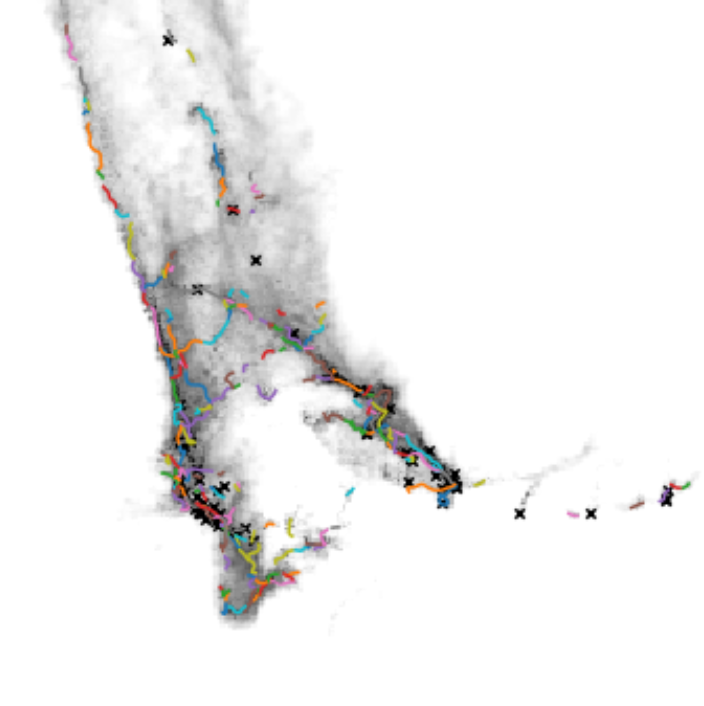
We introduce a new suite of simulations, `The Cloud Factory‘, which self-consistently forms molecular cloud complexes at high enough resolution to resolve internal substructure (up to 0.25 M☉ in mass) all while including galactic-scale forces. We use a version of the AREPO code modified to include a detailed treatment of the physics of the cold molecular ISM, and an analytical galactic gravitational potential for computational efficiency. The simulations have nested levels of resolution, with the lowest layer tied to tracer particles injected into individual cloud complexes. These tracer refinement regions are embedded in the larger simulation so continue to experience forces from outside the cloud. This allows the simulations to act as a laboratory for testing the effect of galactic environment on star formation. Here we introduce our method and investigate the effect of galactic environment on filamentary clouds. We find that cloud complexes formed after a clustered burst of feedback have shorter lengths and are less likely to fragment compared to quiescent clouds (e.g. the Musca filament) or those dominated by the galactic potential (e.g. Nessie). Spiral arms and differential rotation preferentially align filaments, but strong feedback randomizes them. Long filaments formed within the cloud complexes are necessarily coherent with low internal velocity gradients, which has implications for the formation of filamentary star-clusters. Cloud complexes formed in regions dominated by supernova feedback have fewer star-forming cores, and these are more widely distributed. These differences show galactic-scale forces can have a significant impact on star formation within molecular clouds.
March 2020: Simulations of the star-forming molecular gas in an interacting M51-like galaxy
Tress, Robin G., Smith, Rowan J., Sormani, Mattia C., Glover, Simon C. O., Klessen, Ralf S., Mac Low, Mordecai-Mark, Clark, Paul C., MNRAS, 492, 2973-2995 (2020) [ADS link]
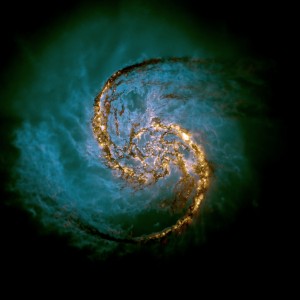
We present here the first of a series of papers aimed at better understanding the evolution and properties of giant molecular clouds (GMCs) in a galactic context. We perform high-resolution, three-dimensional AREPO simulations of an interacting galaxy inspired by the well-observed M51 galaxy. Our fiducial simulations include a non-equilibrium, time-dependent, chemical network that follows the evolution of atomic and molecular hydrogen as well as carbon and oxygen self-consistently. Our calculations also treat gas self-gravity and subsequent star formation (described by sink particles), and coupled supernova feedback. In the densest parts of the simulated interstellar medium (ISM), we reach sub-parsec resolution, granting us the ability to resolve individual GMCs and their formation and destruction self-consistently throughout the galaxy. In this initial work, we focus on the general properties of the ISM with a particular focus on the cold star-forming gas. We discuss the role of the interaction with the companion galaxy in generating cold molecular gas and controlling stellar birth. We find that while the interaction drives large-scale gas flows and induces spiral arms in the galaxy, it is of secondary importance in determining gas fractions in the different ISM phases and the overall star formation rate. The behaviour of the gas on small GMC scales instead is mostly controlled by the self-regulating property of the ISM driven by coupled feedback.
February 2020: When H II regions are complicated: considering perturbations from winds, radiation pressure, and other effects
Geen, Sam, Pellegrini, Eric C., Bieri, Rebekka, Klessen, Ralf S.: MNRAS, 492, 915 – 933 (2020) [ADS link]

We explore to what extent simple algebraic models can be used to describe H II regions when winds, radiation pressure, gravity, and photon breakout are included. We (a) develop algebraic models to describe the expansion of photoionized H II regions under the influence of gravity and accretion in power-law density fields with ρ ∝ r-w, (b) determine when terms describing winds, radiation pressure, gravity, and photon breakout become significant enough to affect the dynamics of the H II region where w = 2, and (c) solve these expressions for a set of physically motivated conditions. We find that photoionization feedback from massive stars is the principal mode of feedback on molecular cloud scales, driving accelerating outflows from molecular clouds in cases where the peaked density structure around young massive stars is considered at radii between ~0.1 and 10-100 pc. Under a large range of conditions the effect of winds and radiation on the dynamics of H II regions is around 10 per cent of the contribution from photoionization. The effect of winds and radiation pressure is most important at high densities, either close to the star or in very dense clouds such as those in the Central Molecular Zone of the Milky Way. Out to ~0.1 pc they are the principal drivers of the H II region. Lower metallicities make the relative effect of photoionization even stronger as the ionized gas temperature is higher.
January 2020: Detecting strongly lensed supernovae at z ~ 5-7 with LSST
Rydberg, Claes-Erik, Whalen, Daniel J., Maturi, Matteo, Collett, Thomas, Carrasco, Mauricio, Magg, Mattis, Klessen, Ralf S.: MNRAS, 491, 2447 – 2459 (2020) [ADS link]
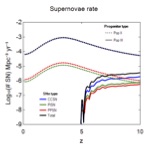
Supernovae (SNe) could be powerful probes of the properties of stars and galaxies at high redshifts in future surveys. Wide fields and longer exposure times are required to offset diminishing star formation rates and lower fluxes to detect useful number of events at high redshift. In principle, the Large Synoptic Survey Telescope (LSST) could discover large numbers of early SNe because of its wide fields but only at lower redshifts because of its AB mag limit of ∼24. However, gravitational lensing by galaxy clusters and massive galaxies could boost flux from ancient SNe and allow LSST to detect them at earlier times. Here, we calculate detection rates for lensed SNe at z ∼ 5-7 for LSST. We find that the LSST Wide Fast Deep survey could detect up to 120 lensed Population (Pop) I and II SNe but no lensed Pop III SNe. Deep-drilling programs in 10 square degree fields could detect Pop I and II core-collapse SNe at AB magnitudes of 27-28 and 26, respectively.
December 2019: SIGNALS – I. Survey description
Rousseau-Nepton, L., Martin, R. P., Robert, C., Drissen, L., Amram, P., Prunet, S., Martin, T., Moumen, I., Adamo, A., Alarie, A., Barmby, P., Boselli, A., Bresolin, F., Bureau, M., Chemin, L., Fernandes, R. C., Combes, F., Crowder, C., Della Bruna, L., Duarte Puertas, S. Egusa, F., Epinat, B., Ksoll, V. F., Girard, M., Gómez Llanos, V., Gouliermis, D., Grasha, K., Higgs, C., Hlavacek-Larrondo, J., Ho, I.-T., Iglesias-Páramo, J., Joncas, G., Kam, Z. S., Karera, P., Kennicutt, R. C., Klessen, R. S., Lianou, S., Liu, L., Liu, Q., de Amorim, A. Luiz, Lyman, J. D., Martel, H., Mazzilli-Ciraulo, B., McLeod, A. F., Melchior, A.-L., Millan, I., Mollá, M., Momose, R., Morisset, C., Pan, H.-A., Pati, A. K., Pellerin, A., Pellegrini, E., Pérez, I., Petric, A., Plana, H., Rahner, D., Ruiz Lara, T., Sánchez-Menguiano, L., Spekkens, K., Stasińska, G., Takamiya, M., Vale Asari, N., Vílchez, J. M.: MNRAS, 489, 5530 – 5546 (2019) [ADS link]

SIGNALS, the Star formation, Ionized Gas, and Nebular Abundances Legacy Survey, is a large observing programme designed to investigate massive star formation and H II regions in a sample of local extended galaxies. The programme will use the imaging Fourier transform spectrograph SITELLE at the Canada-France-Hawaii Telescope. Over 355 h (54.7 nights) have been allocated beginning in fall 2018 for eight consecutive semesters. Once completed, SIGNALS will provide a statistically reliable laboratory to investigate massive star formation, including over 50 000 resolved H II regions: the largest, most complete, and homogeneous data base of spectroscopically and spatially resolved extragalactic H II regions ever assembled. For each field observed, three datacubes covering the spectral bands of the filters SN1 (363-386 nm), SN2 (482-513 nm), and SN3 (647-685 nm) are gathered. The spectral resolution selected for each spectral band is 1000, 1000, and 5000, respectively. As defined, the project sample will facilitate the study of small-scale nebular physics and many other phenomena linked to star formation at a mean spatial resolution of ̃20 pc. This survey also has considerable legacy value for additional topics, including planetary nebulae, diffuse ionized gas, and supernova remnants. The purpose of this paper is to present a general outlook of the survey, notably the observing strategy, galaxy sample, and science requirements.
November 2019: Radiative Transfer with POLARIS. II. Modeling of Synthetic Galactic Synchrotron Observations
Reissl, Stefan, Brauer, Robert, Klessen, Ralf S., Pellegrini, Eric W.: ApJ, 885, 15, 1 – 17 (2019) [ADS link]
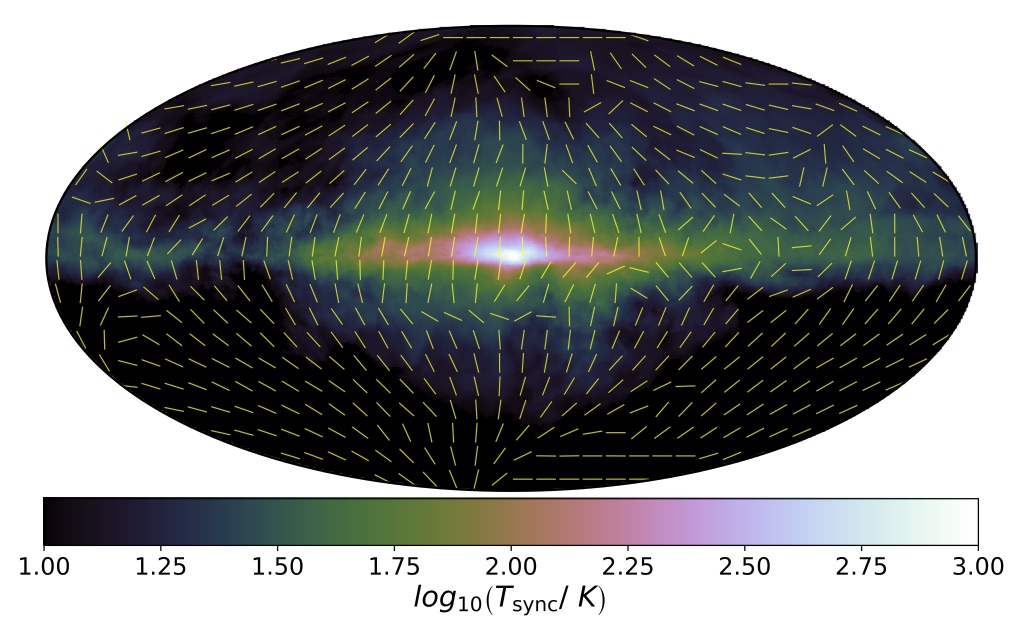
We present an updated version of POLARIS, a well-established code designated for dust polarization and line radiative transfer (RT) in arbitrary astrophysical environments. We extend the already available capabilities with a synchrotron feature for polarized emission. Here, we combine state-of-the-art solutions of the synchrotron RT coefficients with numerical methods for solving the complete system of equations of the RT problem, including Faraday rotation (FR) as well as Faraday conversion (FC). We validate the code against Galactic and extragalactic observations by performing a statistical analysis of synthetic all-sky synchrotron maps for positions within the Galaxy and for extragalactic observations. For these test scenarios we apply a model of the Milky Way based on sophisticated magnetohydrodynamic simulations and population synthesis post-processing techniques. We explore different parameters for modeling the distribution of free electrons and for a turbulent magnetic field component. We find that a strongly fluctuating field is necessary for simulating synthetic synchrotron observations on small scales, we argue that FR alone can account for the depolarization of the synchrotron signal, and we discuss the importance of the observer position within the Milky Way. Altogether, we conclude that POLARIS is a highly reliable tool for predicting synchrotron emission and polarization, including FR in a realistic galactic context. It can thus contribute to a better understanding of the results from current and future observational missions.
October 2019: Maximally accreting supermassive stars: a fundamental limit imposed by hydrostatic equilibrium
Haemmerlé, L., Meynet, G., Mayer, L., Klessen, R. S., Woods, T. E., Heger, A.: A&A, 632, L2, 1 – 5 (2019) [ADS link]
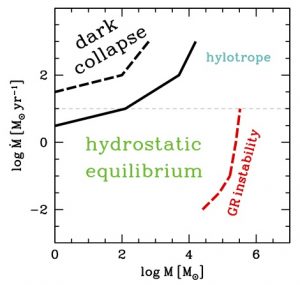
Limits to hydrostatic equilibrium for accretion above 1000 solar masses per year (without rotation).
Major mergers of gas-rich galaxies provide promising conditions for the formation of supermassive black holes (SMBHs; ≳105 M☉) by direct collapse because they can trigger mass inflows as high as 104 – 105 M☉ yr-1 on sub-parsec scales. However, the channel of SMBH formation in this case, either dark collapse (direct collapse without prior stellar phase) or supermassive star (SMS; ≳104 M☉), remains unknown. We investigate the limit in accretion rate up to which stars can maintain hydrostatic equilibrium. We compute hydrostatic models of SMSs accreting at 1-1000 M☉ yr-1, and estimate the departures from equilibrium a posteriori by taking into account the finite speed of sound. We find that stars accreting above the atomic cooling limit (≳10 M☉ yr-1) can only maintain hydrostatic equilibrium once they are supermassive. In this case, they evolve adiabatically with a hylotropic structure, that is, entropy is locally conserved and scales with the square root of the mass coordinate. Our results imply that stars can only become supermassive by accretion at the rates of atomically cooled haloes (~0.1 – 10 M☉ yr-1). Once they are supermassive, larger rates are possible.
September 2019: WARPFIELD-EMP: The self-consistent prediction of emission lines from evolving HII regions in dense molecular clouds
Pellegrini, Eric C., Rahner, Daniel, Reissl, Stefan, Glover, Simon C. O., Klessen, Ralf S., Rousseau-Nepton, L, Herrera-Camus, R., MNRAS, 496, 339 – 363 (2020) — ADS link]
We present the WARPFIELD emission predictor, WARPFIELD-EMP which couples the 1D stellar feedback code WARPFIELD with the CLOUDY HII region/PDR code and the POLARIS radiative transfer code, in order to make detailed predictions for the time-dependent line and continuum emission arising from the H{\sc ii} region and PDR surrounding an evolving star cluster. WARPFIELD-EMP accounts for a wide range of physical processes (stellar winds, supernovae, radiation pressure, gravity, thermal conduction, radiative cooling, dust extinction etc.) and yet runs quickly enough to allow us to explore broad ranges of different cloud parameters. We compare the results of an extensive set of models with SITELLE observations of a large sample of HII regions in NGC 628 and find very good agreement, particularly for the highest signal-to-noise observations. We show that our approach of modeling individual clouds from first principles (instead of in terms of dimensionless quantities such as the ionization parameter) allows us to avoid long-standing degeneracies in the interpretation of HII region diagnostics and enables us to relate these diagnostics to important physical parameters such as cloud mass or cluster age. Finally, we explore the implications of our models regarding the reliability of simple metallicity diagnostics, the properties of long-lived embedded clusters, and the role played by winds and supernovae in regulating HII region and PDR line emission.
August 2019: Optimal neighbourhood to nurture giants: a fundamental link between star-forming galaxies and direct collapse black holes
Agarwal, Bhaskar, Cullen, Fergus, Khochfar, Sadegh, Ceverino, Daniel, Klessen, Ralf S.: MNRAS, 488, 3268 – 3273 (2019) [ADS link]
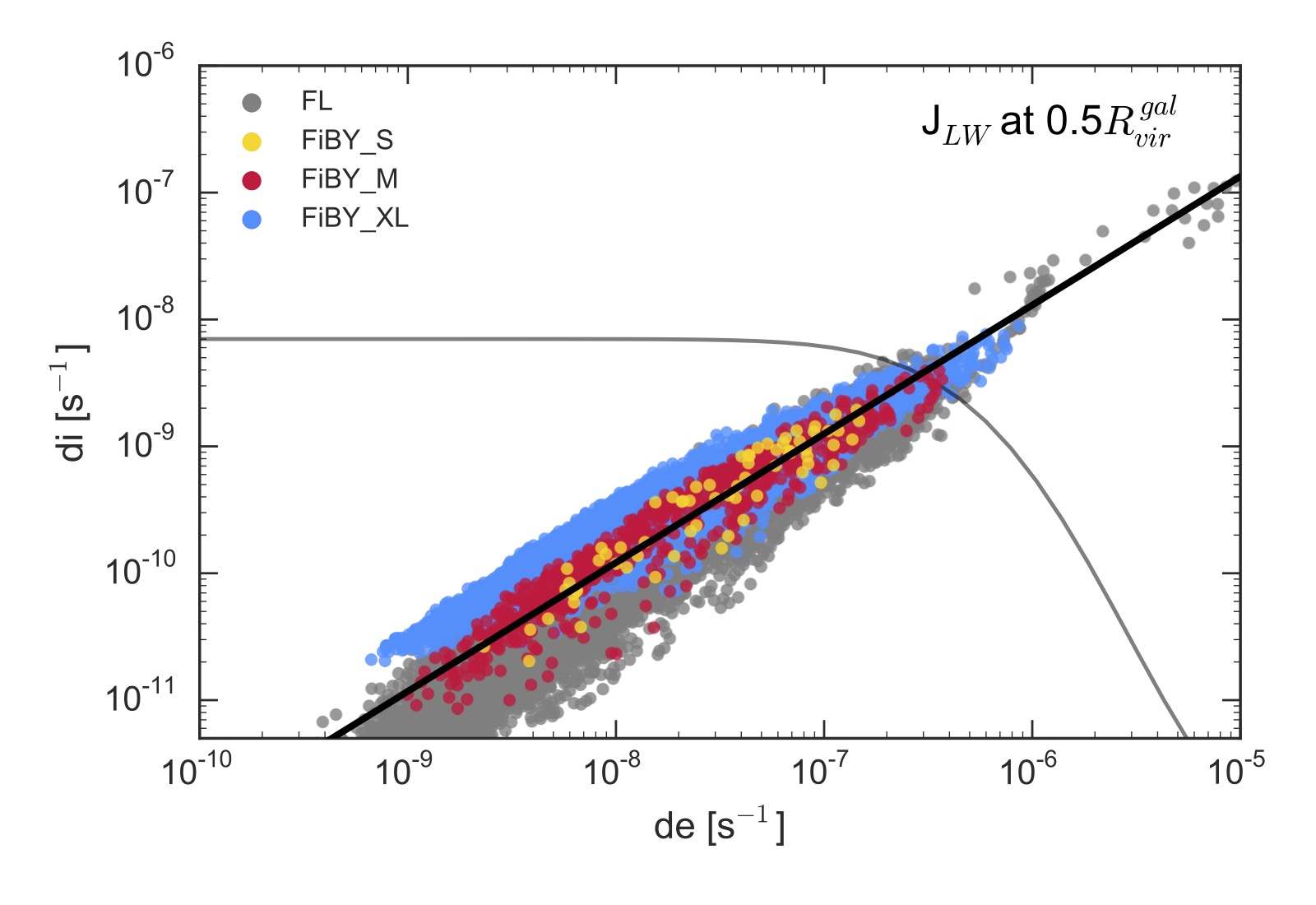
Galaxies in the H2 photodissociation (kdi) and H photodetachment (kde) rate plane. The rates (and thus the critial Lyman-Werner flux JLW ) is computed at half the virial radius.
Massive 104-5 M☉ black hole seeds resulting from the direct collapse of pristine gas require a metal-free atomic cooling halo with extremely low H2 fraction, allowing the gas to cool isothermally in the presence of atomic hydrogen. In order to achieve this chemo-thermodynamical state, the gas needs to be irradiated by both Lyman-Werner (LW) photons in the energy range of 11.2-13.6 eV capable of photodissociating H2 and 0.76 eV photons capable of photodetaching H–. Employing cosmological simulations capable of creating the first galaxies in high resolution, we explore if there exists a subset of galaxies that favour direct collapse black hole (DCBH) formation in their vicinity. We find a fundamental relation between the maximum distance at which a galaxy can cause DCBH formation and its star formation rate (SFR), which automatically folds in the chemo-thermodynamical effects of both H2 photodissociation and H– photodetachment. This is in contrast to the approximately three order of magnitude scatter seen in the LW flux parameter computed at the maximum distance, which is synonymous with a scatter in `Jcrit‚. Thus, computing the rates and/or the LW flux from a galaxy is no longer necessary to identify neighbouring sites of DCBH formation, as our relation allows one to distinguish regions where DCBH formation could be triggered in the vicinity of a galaxy of a given SFR.
July 2019: Histogram of oriented gradients: a technique for the study of molecular cloud formation
Soler, J. D., Beuther, H., Rugel, M., Wang, Y., Clark, P. C., Glover, S. C. O., Goldsmith, P. F., Heyer, M., Anderson, L. D., Goodman, A., Henning, T., Kainulainen, J., Klessen, R. S., Longmore, S. N., McClure-Griffiths, N. M., Menten, K. M., Mottram, J. C., Ott, J., Ragan, S. E., Smith, R. J., Urquhart, J. S., Bigiel, F. , Hennebelle, P., Roy, N., Schilke, P.: A&A, 622, A166, 1 – 31 (2019) [ADS link]
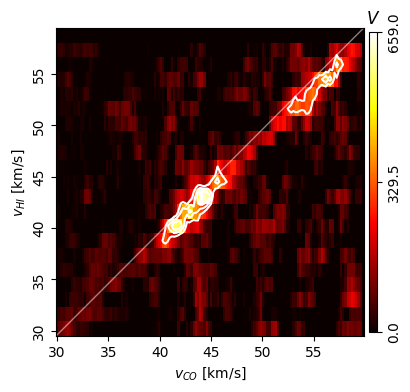
Results of the histogram of oriented gradients (HOG) analysis of the THOR HI and GRS 13CO observations,
We introduce the histogram of oriented gradients (HOG), a tool developed for machine vision that we propose as a new metric for the systematic characterization of spectral line observations of atomic and molecular gas and the study of molecular cloud formation models. In essence, the HOG technique takes as input extended spectral-line observations from two tracers and provides an estimate of their spatial correlation across velocity channels. We characterized HOG using synthetic observations of HI and 13CO (J = 1 → 0) emission from numerical simulations of magnetohydrodynamic (MHD) turbulence leading to the formation of molecular gas after the collision of two atomic clouds. We found a significant spatial correlation between the two tracers in velocity channels where vHI ≈ v13CO, almost independent of the orientation of the collision with respect to the line of sight. Subsequently, we used HOG to investigate the spatial correlation of the HI, from The HI/OH/recombination line survey of the inner Milky Way (THOR), and the 13CO (J = 1 → 0) emission from the Galactic Ring Survey (GRS), toward the portion of the Galactic plane 33°.75 ≤ l ≤ 35°.25 and |b| ≤ 1°.25. We found a significant spatial correlation between the two tracers in extended portions of the studied region. Although some of the regions with high spatial correlation are associated with HI self-absorption (HISA) features, suggesting that it is produced by the cold atomic gas, the correlation is not exclusive to this kind of region. The HOG results derived for the observational data indicate significant differences between individual regions: some show spatial correlation in channels around vHI ≈ v13CO while others present spatial correlations in velocity channels separated by a few kilometers per second. We associate these velocity offsets to the effect of feedback and to the presence of physical conditions that are not included in the atomic-cloud-collision simulations, such as more general magnetic field configurations, shear, and global gas infall.
June 2019: The relation between the true and observed fractal dimensions of turbulent clouds
Beattie, James R., Federrath, Christoph, Klessen, Ralf S.: MNRAS, 487, 2070 – 2081 (2019) [ADS link]

Observations of interstellar gas clouds are typically limited to two-dimensional (2D) projections of the intrinsically three-dimensional (3D) structure of the clouds. In this study, we present a novel method for relating the 2D projected fractal dimension (Dp) to the 3D fractal dimension (D3D) of turbulent clouds. We do this by computing the fractal dimension of clouds over two orders of magnitude in turbulent Mach number (M = 1 – 100), corresponding to seven orders of magnitude in spatial scales within the clouds. This provides us with the data to create a new empirical relation between Dp and D3D. The minimum 3D fractal dimension, D3D,min = 2.06 ± 0.35, indicates that in the high M limit the 3D clouds are dominated by planar shocks. The relation between Dp and D3D of molecular clouds may be a useful tool for those who are seeking to understand the 3D structures of molecular clouds, purely based upon 2D projected data and shows promise for relating the physics of the turbulent clouds to the fractal dimension.
May 2019: The geometry of the gas surrounding the Central Molecular Zone: on the origin of localised molecular clouds with extreme velocity dispersions
Sormani, Mattia C., Treß, Robin G., Glover, Simon C. O., Klessen, Ralf S., Barnes, Ashley T., Battersby, Cara D., Clark, Paul C., Hatchfield, H. Perry, Smith, Rowan J.: MNRAS, tmp 1994, (2019) [ADS link]

Features in the (x,y) plane and their projection to the (l,v) plane for a simulation of the CMZ. Arrows in the left panels show the velocity field in the rotating frame of the bar. Labels mark some of the interesting features.
Observations of molecular gas near the Galactic centre (|l| < 10°, |b| < 1°) reveal the presence of a distinct population of enigmatic compact clouds which are characterised by extreme velocity dispersions (∆v > 100 km s-1). These Extended Velocity Features (EVFs) are very prominent in the datacubes and dominate the kinematics of molecular gas just outside the Central Molecular Zone (CMZ). The prototypical example of such a cloud is Bania Clump 2. We show that similar features are naturally produced in simulations of gas flow in a realistic barred potential. We analyse the structure of the features obtained in the simulations and use this to interpret the observations. We find that the features arise from collisions between material that has been infalling rapidly along the dust lanes of the Milky Way bar and material that belongs to one of the following two categories: (i) material that has `overshot‘ after falling down the dust lanes on the opposite side; (ii) material which is part of the CMZ. Both types of collisions involve gas with large differences in the line-of-sight velocities, which is what produces the observed extreme velocity dispersions. Examples of both categories can be identified in the observations. If our interpretation is correct, we are directly witnessing (a) collisions of clouds with relative speeds of about 200 km/s and (b) the process of accretion of fresh gas onto the CMZ.
April 2019: Observational constraints on the survival of pristine stars
Magg, Mattis, Klessen, Ralf S., Glover, Simon C. O., Li, Haining: MNRAS, 487, 486-490 484, (2019) [ADS link]

Probability of not detecting metal-free stars until today, as function of halo mass. We show the probabilities derived from ultra metal-poor (UMP, blue diamonds) and extremely metal-poor (EMP, orange triangles) star detections separately and combined (green circles). The UMP stars give much tighter constraints than the EMP stars.
There is a longstanding discussion about whether low-mass stars can form from pristine gas in the early Universe. A particular point of interest is whether we can find surviving pristine stars from the first generation in our local neighbourhood. We present here a simple analytical estimate that puts tighter constraints on the existence of such stars. In the conventional picture, should these stars have formed in significant numbers and have preserved their pristine chemical composition until today, we should have found them already. With the presented method most current predictions for survivor counts larger than zero can be ruled out.
March 2019: The influence of streaming velocities on the formation of the first stars
Schauer, Anna T. P., Glover, Simon C. O., Klessen, Ralf S., Ceverino, Daniel: MNRAS, 484, 3510-3521 (2019) [ADS link]

Baryon fraction in haloes with masses larger than 105 M⊙ as a function of redshift. In the case of zero streaming velocity (light green), the value approaches the cosmic mean (dashed line). For all simulations with non-zero streaming velocities (blue, dark green, grey), it is well below that value. The shaded regions show the respective standard deviations.
How, when, and where the first stars formed are fundamental questions regarding the epoch of cosmic dawn. A second-order effect in the fluid equations was recently found to make a significant contribution: an offset velocity between gas and dark matter, the so-called streaming velocity. Previous simulations of a limited number of low-mass dark matter haloes suggest that this streaming velocity can delay the formation of the first stars and decrease halo gas fractions and the halo mass function in the low-mass regime. However, a systematic exploration of its effects in a large sample of haloes has been lacking until now. In this paper, we present results from a set of cosmological simulations of regions of the Universe with different streaming velocities performed with the moving mesh code AREPO. Our simulations have very high mass resolution, enabling us to accurately resolve minihaloes as small as 105 M⊙. We show that in the absence of streaming, the least massive halo that contains cold gas has a mass Mhalo, min = 5 × 105 M⊙, but that cooling only becomes efficient in a majority of haloes for halo masses greater than Mhalo, 50% = 1.6 × 106 M⊙. In regions with non-zero streaming velocities, Mhalo, min and Mhalo, 50% both increase significantly, by around a factor of a few for each one sigma increase in the value of the local streaming velocity. As a result, in regions with streaming velocities v_stream ≥ 3 σrms, cooling of gas in minihaloes is completely suppressed, implying that the first stars in these regions form within atomic cooling haloes.
FEBRUARY 2019: FirstLight III: rest-frame UV-optical spectral energy distributions of simulated galaxies at cosmic dawn
Ceverino, Daniel, Klessen, Ralf S., Glover, Simon C. O.: MNRAS, 484, 1366-1377 (2019) [ADS link]
Using the FirstLight data base of 300 zoom-in cosmological simulations we provide rest-frame UV-optical spectral energy distributions of galaxies with complex star-formation histories that are coupled to the non-uniform gas accretion history of galactic haloes during cosmic dawn. The population at any redshift is very diverse ranging from starbursts to quiescent galaxies even at a fixed stellar mass. This drives a redshift-dependent relation between UV luminosity and stellar mass with a large scatter, driven by the specific star formation rate. The UV slope and the production efficiency of Lyman continuum photons have high values, consistent with dust-corrected observations. This indicates young stellar populations with low metallicities. The FirstLight simulations make predictions on the rest-frame UV-optical absolute magnitudes, colours, and optical emission lines of galaxies at z = 6-12 that will be observed for the first time with James Webb Space Telescope and the next generation of telescopes in the coming decade.
JANUARY 2019: WARPFIELD 2.0 — feedback-regulated minimum star formation efficiencies of giant molecular clouds
Rahner, Daniel, Pellegrini, Eric W., Glover, Simon C. O., Klessen, Ralf S.: MNRAS, 483, 2547-2560 (2019) [ADS link]
Star formation is an inefficient process and in general only a small fraction of the gas in a giant molecular cloud (GMC) is turned into stars. This is partly due to the negative effect of stellar feedback from young massive star clusters. Recently, we introduced a novel 1D numerical treatment of the effects of stellar feedback from young massive clusters on their natal clouds, which we named WARPFIELD. Here, we present version 2 of the WARPFIELD code, containing improved treatments of the thermal evolution of the gas and the fragmentation of the feedback-driven shell. As part of this update, we have produced new cooling and heating tables that account for the combined effects of photoionization and collisional ionization on the cooling rate, which we now make publicly available. We employ our updated version of WARPFIELD to investigate the impact of stellar feedback on GMCs with a broad range of masses and surface densities and a variety of density profiles. We show that the minimum star formation efficiency (SFE) ɛmin, i.e. the SFE above which the cloud is destroyed by feedback, is mainly set by the average cloud surface density. An SFE of 1-6 per cent is generally sufficient to destroy a GMC. We also find an SFE per free-fall time ɛff ˜ 0.3 per cent, in good agreement with recent observations. Our results imply that feedback alone is sufficient to explain the low observed SFE of GMCs. Finally, we show that very massive clouds with steep density profiles – possible proxies of the giant clumps observed in galaxies at z ≈ 2 – are more resilient to feedback than typical GMCs, with ɛmin between 1 and 12 per cent.
December 2018: Fingerprint of the first stars: multi-enriched extremely metal-poor stars in the TOPOS
Hartwig, Tilman, Ishigaki, Miho, Klessen, Ralf S., Yoshida, Naoki, MNRAS, 482, 1204–1210 (2019) [ADS LINK]
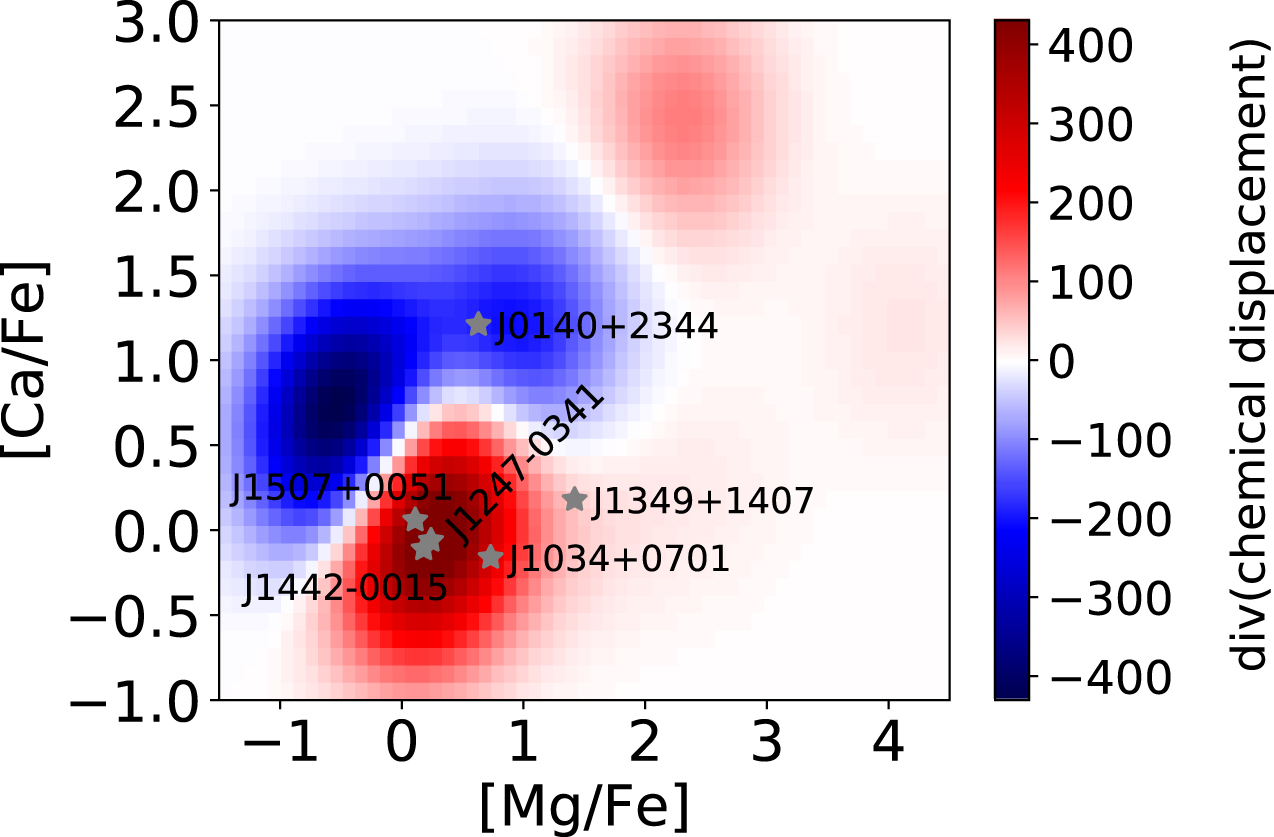
Extremely metal-poor (EMP) stars in the Milky Way inherited the chemical composition of the gas out of which they formed. They therefore carry the chemical fingerprint of the first stars in their spectral lines. It is commonly assumed that EMP stars form from gas that was enriched by only one progenitor supernova (‘mono-enriched’). However, recent numerical simulations show that the first stars form in small clusters. Consequently, we expect several supernovae to contribute to the abundances of an EMP star (‘multi-enriched’). We analyse seven recently observed EMP stars from the TOPoS survey by applying the divergence of the chemical displacement and find that J1035+0641 is mono-enriched (pmono=53 per cent) and J1507+0051 is multi-enriched (pmono=4 per cent). For the remaining five stars, we cannot make a distinct prediction (pmono≲50 per cent) due to theoretical and observational uncertainties. Further observations in the near-UV will help to improve our diagnostic and therefore contribute to constrain the nature of the first stars.
NoVember 2018: A dynamical mechanism for the origin of nuclear rings
Sormani, Mattia C., Sobacchi, Emanuele, Fragkoudi, Francesca, Ridley, Matthew, Treß, Robin G., Glover, Simon C. O., Klessen, Ralf S., MNRAS, 481, 2 -19 (2018) [ADS LINK]

We develop a dynamical theory for the origin of nuclear rings in barred galaxies. In analogy with the standard theory of accretion discs, our theory is based on shear viscous forces among nested annuli of gas. However, the fact that gas follows non-circular orbits in an external barred potential has profound consequences: it creates a region of reverse shear in which it is energetically favourable to form a stable ring that does not spread despite dissipation. Our theory allows us to approximately predict the size of the ring given the underlying gravitational potential. The size of the ring is loosely related to the location of the Inner Lindblad Resonance in the epicyclic approximation, but the predicted location is more accurate and is also valid for strongly barred potentials. By comparing analytical predictions with the results of hydrodynamical simulations, we find that our theory provides a viable mechanism for ring formation if the effective sound speed of the gas is low (cs≲1kms−1), but that nuclear spirals/shocks created by pressure destroy the ring when the sound speed is high (cs≃10kms−1). We conclude that whether this mechanism for ring formation is relevant for real galaxies ultimately depends on the effective equation of state of the interstellar medium (ISM). Promising confirmation comes from simulations in which the ISM is modelled using state-of-the-art cooling functions coupled to live chemical networks, but more tests are needed regarding the role of turbulence driven by stellar feedback. If the mechanism is relevant in real galaxies, it could provide a powerful tool to constrain the gravitational potential, in particular the bar pattern speed.
october 2018: FirstLight – II. Star formation rates of primeval galaxies from z=5-15
Ceverino, Daniel, Klessen, Ralf S., Glover, Simon C. O., MNRAS, 480, 4842-4850 (2018) [ADS LINK]

In the FirstLight project, we have used ˜300 cosmological, zoom-in simulations to determine the star formation histories of distinct first galaxies with stellar masses between M* = 106 and 3 × 10^9 M_{⊙} during cosmic dawn (z = 5-15). The evolution of the star formation rate (SFR) in each galaxy is complex and diverse, characterized by bursts of star formation. Overall, first galaxies spend 70 per cent of their time in star formation bursts. A sample of 1000 of these bursts indicates that the typical burst at z ≃ 6 has a specific SFR (sSFR) maximum of 5-}15 Gyr^{-1} with an effective width of ˜100 Myr, one-tenth of the age of the Universe at that redshift. A quarter of the bursts populate a tail with very high sSFR maxima of 20-}30 Gyr^{-1} and significantly shorter time-scales of ˜40-80 Myr. This diversity of bursts sets the mean and the mass-dependent scatter of the star-forming main sequence. This scatter is driven by a population of low-mass, M_*≤10^8 M_{⊙}, quiescent galaxies. The mean sSFR and the burst maximum at fixed mass increase with redshift, with the later always being a factor of ˜2 higher than the former. This implies sSFR maxima of {˜ } 20-60 Gyr^{-1} at z = 9-10. The SFR histories are publicly available at the FirstLight website.
September 2018: Hubble Tarantula Treasury Project – VI. Identification of pre-main-sequence stars using machine-learning techniques
Ksoll, Victor F., Gouliermis, Dimitrios A., Klessen, Ralf S., Grebel, Eva K., Sabbi, Elena, Anderson, Jay, Lennon, Daniel J., Cignoni, Michele, de Marchi, Guido, Smith, Linda J., Tosi, Monica, van der Marel, Roeland P., MNRAS, 479, 2389-2414 (2018) [ADS LINK]
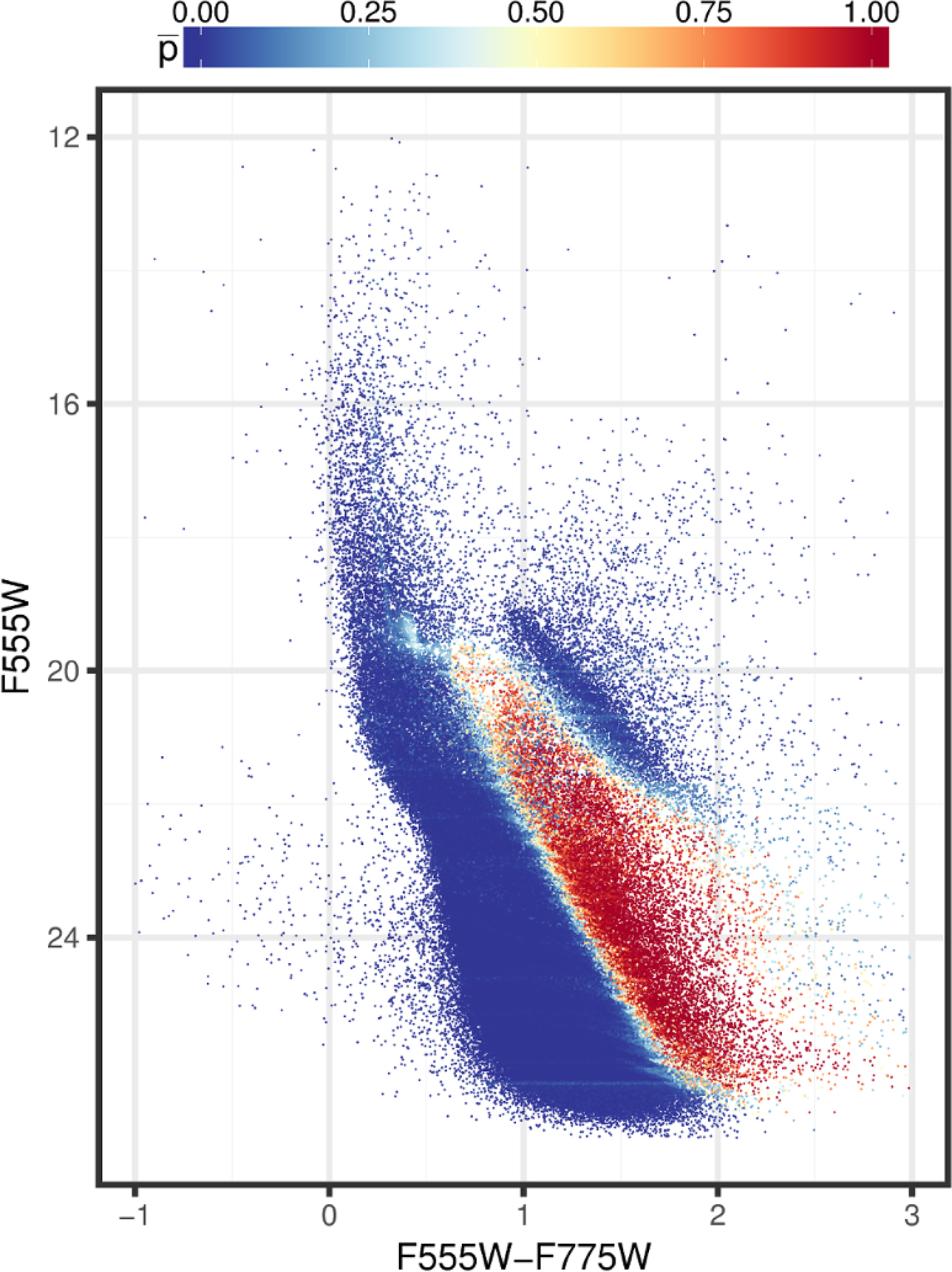
The Hubble Tarantula Treasury Project (HTTP) has provided an unprecedented photometric coverage of the entire starburst region of 30 Doradus down to the half Solar mass limit. We use the deep stellar catalogue of HTTP to identify all the pre-main-sequence (PMS) stars of the region, i.e. stars that have not started their lives on the main-sequence yet. The photometric distinction of these stars from the more evolved populations is not a trivial task due to several factors that alter their colour-magnitude diagram positions. The identification of PMS stars requires, thus, sophisticated statistical methods. We employ machine-learning classification techniques on the HTTP survey of more than 800 000 sources to identify the PMS stellar content of the observed field. Our methodology consists of (1) carefully selecting the most probable low-mass PMS stellar population of the star-forming cluster NGC 2070, (2) using this sample to train classification algorithms to build a predictive model for PMS stars, and (3) applying this model in order to identify the most probable PMS content across the entire Tarantula Nebula. We employ decision tree, random forest (RF), and support vector machine (SVM) classifiers to categorize the stars as PMS and non-PMS. The RF and SVM provided the most accurate models, predicting about 20 000 sources with a candidateship probability higher than 50 per cent, and almost 10 000 PMS candidates with a probability higher than 95 per cent. This is the richest and most accurate photometric catalogue of extragalactic PMS candidates across the extent of a whole star-forming complex.
August 2018: On the indeterministic nature of star formation on the cloud scale
Geen, Sam, Watson, Stuart K., Rosdahl, Joakim, Bieri, Rebekka, Klessen, Ralf S., Hennebelle, Patrick, MNRAS, 481, 2548-2569 (2018) [ADS LINK]
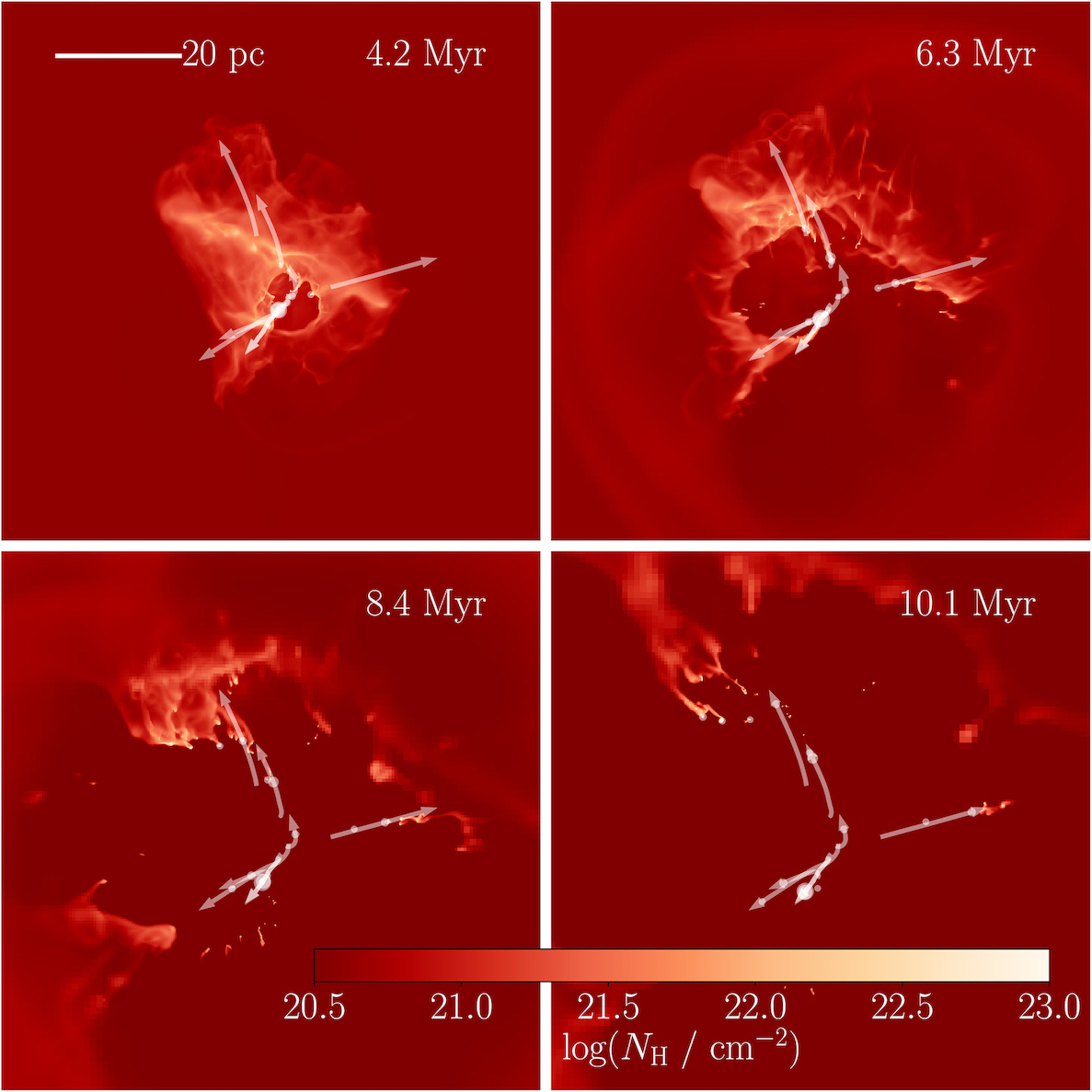
Molecular clouds are turbulent structures whose star formation efficiency (SFE) is strongly affected by internal stellar feedback processes. In this paper, we determine how sensitive the SFE of molecular clouds is to randomized inputs in the star formation feedback loop, and to what extent relationships between emergent cloud properties and the SFE can be recovered. We introduce the YULE suite of 26 radiative magnetohydrodynamic simulations of a 10 000 solar mass cloud similar to those in the solar neighbourhood. We use the same initial global properties in every simulation but vary the initial mass function sampling and initial cloud velocity structure. The final SFE lies between 6 and 23 per cent when either of these parameters are changed. We use Bayesian mixed-effects models to uncover trends in the SFE. The number of photons emitted early in the cluster’s life and the length of the cloud provide the strongest predictors of the SFE. The H II regions evolve following an analytic model of expansion into a roughly isothermal density field. The more efficient feedback is at evaporating the cloud, the less the star cluster is dispersed. We argue that this is because if the gas is evaporated slowly, the stars are dragged outwards towards surviving gas clumps due to the gravitational attraction between the stars and gas. While star formation and feedback efficiencies are dependent on non-linear processes, statistical models describing cloud-scale processes can be constructed.
July 2018: SPRAI: coupling of radiative feedback and primordial chemistry in moving mesh hydrodynamics
Jaura, O., Glover, S. C. O., Klessen, R. S., Paardekooper, J.-P., MNRAS, 475, 2822-2834 (2018) [ADS LINK]
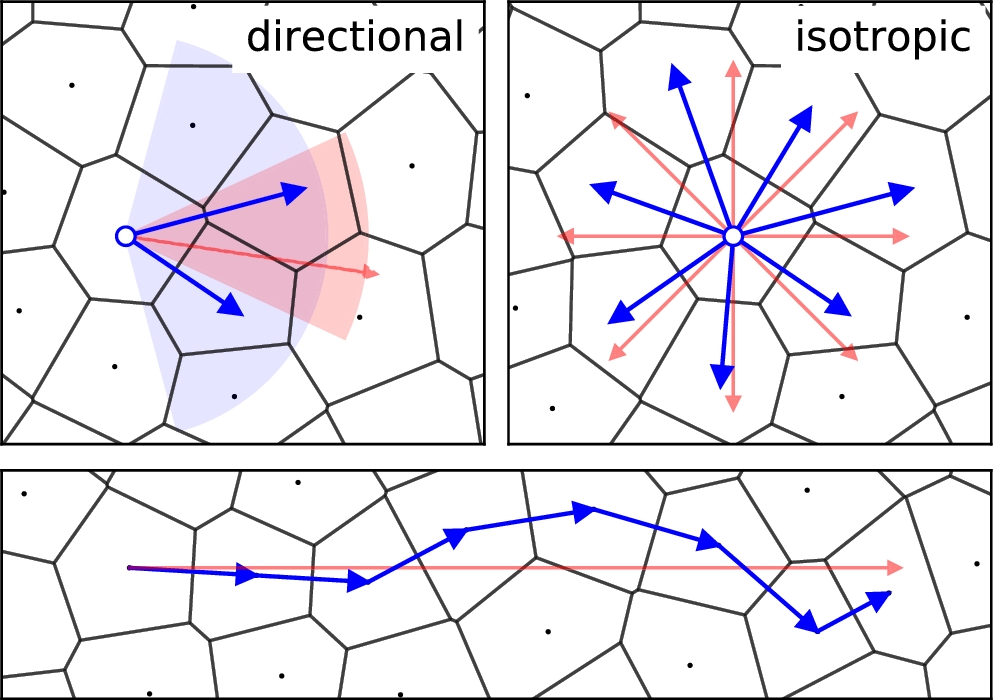
In this paper, we introduce a new radiative transfer code SPRAI (Simplex Photon Radiation in the Arepo Implementation) based on the SIMPLEX radiation transfer method. This method, originally used only for post-processing, is now directly integrated into the AREPO code and takes advantage of its adaptive unstructured mesh. Radiated photons are transferred from the sources through the series of Voronoi gas cells within a specific solid angle. From the photon attenuation, we derive corresponding photon fluxes and ionization rates and feed them to a primordial chemistry module. This gives us a self-consistent method for studying dynamical and chemical processes caused by ionizing sources in primordial gas. Since the computational cost of the SIMPLEX method does not scale directly with the number of sources, it is convenient for studying systems such as primordial star-forming haloes that may form multiple ionizing sources.
June 2018: A theoretical explanation for the Central Molecular Zone asymmetry
Sormani, Mattia C., Treß, Robin G., Ridley, Matthew, Glover, Simon C. O., Klessen, Ralf S., Binney, James, Magorrian, John, Smith, Rowan, MNRAS, 475, 2383-2402 (2018) [ADS LINK]
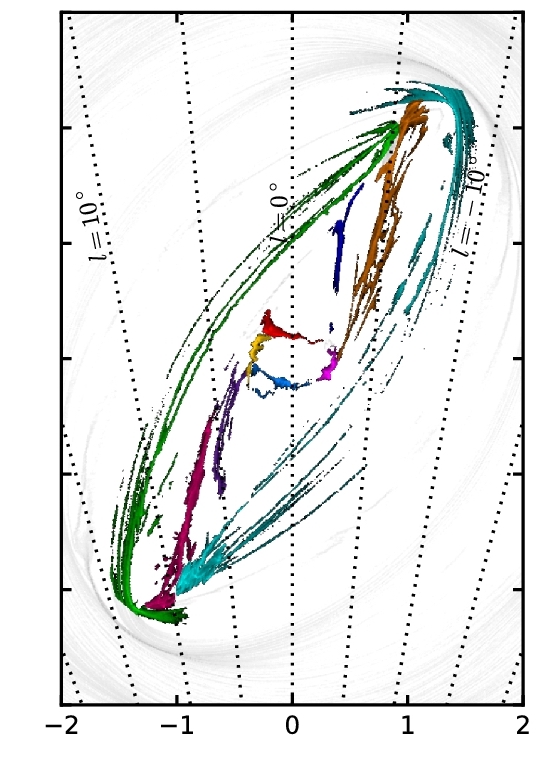
It has been known for more than 30 yr that the distribution of molecular gas in the innermost 300 parsecs of the Milky Way, the Central Molecular Zone, is strongly asymmetric. Indeed, approximately three quarters of molecular emission come from positive longitudes, and only one quarter from negative longitudes. However, despite much theoretical effort, the origin of this asymmetry has remained a mystery. Here, we show that the asymmetry can be neatly explained by unsteady flow of gas in a barred potential. We use high-resolution 3D hydrodynamical simulations coupled to a state-of-the-art chemical network. Despite the initial conditions and the bar potential being point symmetric with respect to the Galactic Centre, asymmetries develop spontaneously due to the combination of a hydrodynamical instability known as the `wiggle instability‘ and the thermal instability. The observed asymmetry must be transient: observations made tens of megayears in the past or in the future would often show an asymmetry in the opposite sense. Fluctuations of amplitude comparable to the observed asymmetry occur for a large fraction of time in our simulations, and suggest that the present is not an exceptional moment in the life of our Galaxy.
May 2018: Spectral shifting strongly constrains molecular cloud disruption by radiation pressure on dust
Reißl, Stefan, Klessen, Ralf S., Mac Low, Mordecai-Mark, Pellegrini, Eric W., A&A, 611, A70, 1-19 (2018) [ADS LINK]
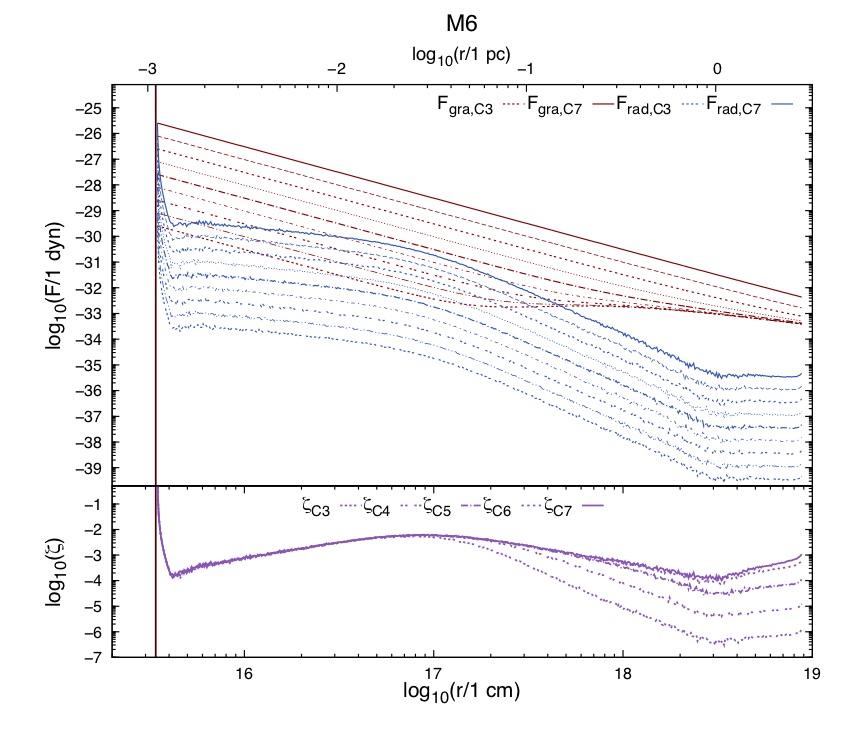
Aim. We aim to test the hypothesis that radiation pressure from young star clusters acting on dust is the dominant feedback agent disrupting the largest star-forming molecular clouds and thus regulating the star-formation process.
Methods: We performed multi-frequency, 3D, radiative transfer calculations including both scattering and absorption and re-emission to longer wavelengths for model clouds with masses of 104-107 M⊙, containing embedded clusters with star formation efficiencies of 0.009-91%, and varying maximum grain sizes up to 200 μm. We calculated the ratio between radiative and gravitational forces to determine whether radiation pressure can disrupt clouds.
Results: We find that radiation pressure acting on dust almost never disrupts star-forming clouds. Ultraviolet and optical photons from young stars to which the cloud is optically thick do not scatter much. Instead, they quickly get absorbed and re-emitted by the dust at thermal wavelengths. As the cloud is typically optically thin to far-infrared radiation, it promptly escapes, depositing little momentum in the cloud. The resulting spectrum is more narrowly peaked than the corresponding Planck function, and exhibits an extended tail at longer wavelengths. As the opacity drops significantly across the sub-mm and mm wavelength regime, the resulting radiative force is even smaller than for the corresponding single-temperature blackbody. We find that the force from radiation pressure falls below the strength of gravitational attraction by an order of magnitude or more for either Milky Way or moderate starbust conditions. Only for unrealistically large maximum grain sizes, and star formation efficiencies far exceeding 50% do we find that the strength of radiation pressure can exceed gravity.
Conclusions: We conclude that radiation pressure acting on dust does not disrupt star-forming molecular clouds in any Local Group galaxies. Radiation pressure thus appears unlikely to regulate the star-formation process on either local or global scales.
April 2018: Predicting the locations of possible long-lived low-mass first stars: importance of satellite dwarf galaxies
Magg, Mattis, Hartwig, Tilman, Agarwal, Bhaskar, Frebel, Anna, Glover, Simon C. O., Griffen, Brendan F., Klessen, Ralf S., MNRAS, 473, 5308-5323 (2018) [ADS LINK]
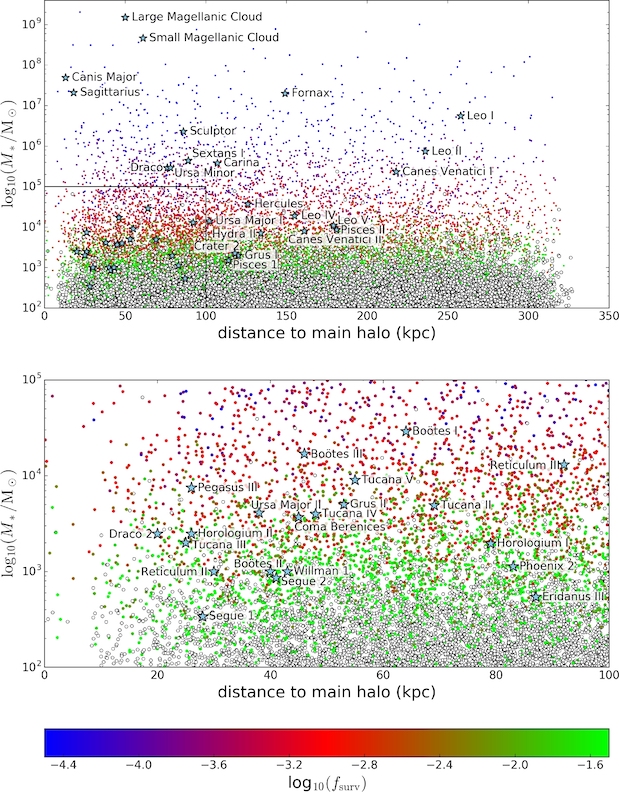
The search for metal-free stars has so far been unsuccessful, proving that if there are surviving stars from the first generation, they are rare, they have been polluted or we have been looking in the wrong place. To predict the likely location of Population III (Pop III) survivors, we semi-analytically model early star formation in progenitors of Milky Way-like galaxies and their environments. We base our model on merger trees from the high-resolution dark matter only simulation suite Caterpillar. Radiative and chemical feedback are taken into account self-consistently, based on the spatial distribution of the haloes. Our results are consistent with the non-detection of Pop III survivors in the Milky Way today. We find that possible surviving Pop III stars are more common in Milky Way satellites than in the main Galaxy. In particular, low-mass Milky Way satellites contain a much larger fraction of Pop III stars than the Milky Way. Such nearby, low-mass Milky Way satellites are promising targets for future attempts to find Pop III survivors, especially for high-resolution, high signal-to-noise spectroscopic observations. We provide the probabilities of finding a Pop III survivor in the red giant branch phase for all known Milky Way satellites to guide future observations.
March 2018: Shape and spin of minihaloes: from large scales to the centeRs
Druschke, Maik, Schauer, Anna T. P., Glover, Simon C. O., Klessen, Ralf S., MNRAS, 481, 3266-3277 (2018) [ADS LINK]
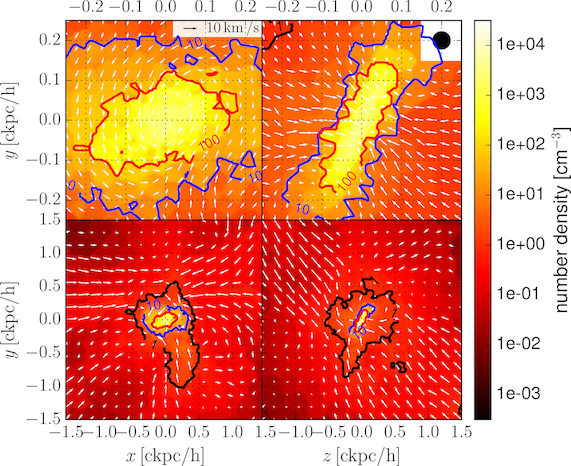
The spin and shape of galaxies at the present day have been well studied both observationally and theoretically. At high redshifts, however, we have to rely on numerical simulations. In this study, we investigate the shape and spin of minihaloes with masses of M ˜ 105-10^7 M_{⊙} which are of particular interest as they are the sites where the first stars in the Universe form. We analyse a large sample of these minihaloes, selected from a high-resolution cosmological simulation. The first minihaloes form at z ≃ 24 and by the end of the simulation at z ≃ 14 our sample includes ˜9000 minihaloes. We find that the spin parameter of the minihaloes follows a log-normal distribution with minimal dependence on redshift. Most minihaloes are prolate, but those formed at the highest redshifts are more prolate than those formed at lower redshifts. On the scale of the virial radius, there is a good correlation between the shape and spin of the gas and that of the dark matter. However, this correlation breaks down in gas which is cooling and undergoing gravitational collapse. We show, contrary to previous assumptions, that although the direction of the spin of the central dense gas correlates well with that of the halo, the magnitude of the spin of the dense gas is uncorrelated with that of the halo. Therefore, measurements of the spin of minihaloes on large scales tell us little about the angular momentum of the gas responsible for forming the first stars.
February 2018: Forming clusters within clusters: how 30 Doradus recollapsed and gave birth again
Rahner, Daniel, Pellegrini, Eric W., Glover, Simon C. O., Klessen, Ralf S., MNRAS, 473, L11-L15 (2018) [ADS LINK]

The 30 Doradus nebula in the Large Magellanic Cloud (LMC) contains the massive starburst cluster NGC 2070 with a massive and probably younger stellar sub clump at its centre: R136. It is not clear how such a massive inner cluster could form several million years after the older stars in NGC 2070, given that stellar feedback is usually thought to expel gas and inhibit further star formation. Using the recently developed 1D feedback scheme WARPFIELD to scan a large range of cloud and cluster properties, we show that an age offset of several million years between the stellar populations is in fact to be expected given the interplay between feedback and gravity in a giant molecular cloud with a density ≳500 cm-3 due to re-accretion of gas on to the older stellar population. Neither capture of field stars nor gas retention inside the cluster have to be invoked in order to explain the observed age offset in NGC 2070 as well as the structure of the interstellar medium around it.
January 2018: On the Rotation of Supermassive Stars
Haemmerlé, Lionel, Woods, Tyrone E., Klessen, Ralf S., Heger, Alexander, Whalen, Daniel J., ApJ, 853, L3, 1-5 (2018) [ADS LINK]
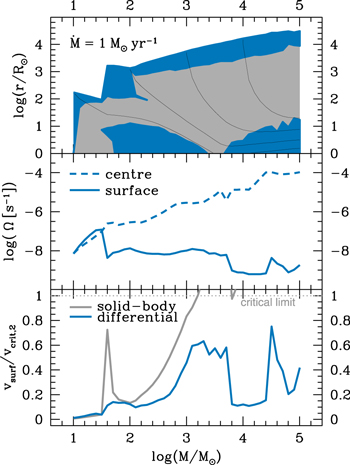
Supermassive stars (SMSs) born from pristine gas in atomically cooled halos are thought to be the progenitors of supermassive black holes at high redshifts. However, the way they accrete their mass is still an unsolved problem. In particular, for accretion to proceed, a large amount of angular momentum has to be extracted from the collapsing gas. Here, we investigate the constraints stellar evolution imposes on this angular momentum problem. We present an evolution model of a supermassive Population III star simultaneously including accretion and rotation. We find that, for SMSs to form by accretion, the accreted angular momentum has to be about 1% of the Keplerian angular momentum. This tight constraint comes from the ΩΓ-limit, at which the combination of radiation pressure and centrifugal force cancels gravity. It implies that SMSs are slow rotators, with a surface velocity less than 10%-20% of their first critical velocity, at which the centrifugal force alone cancels gravity. At such low velocities, the deformation of the star due to rotation is negligible.
Schematic overview of our cINN architecture with the information of input parameters and observations for a condition.

